“The best time to buy real estate is five years ago.”
– Anonymous
“A pessimist sees difficulty in every opportunity; an optimist sees the opportunity in every difficulty.”
-Winston Churchill
As a stickler when it comes to protocol, please allow me – on behalf of the entire Clear Capital team – to comply with the Style Guide for Fourth Quarter Investor Newsletters, by passing along our best wishes for the coming year. I hope that the holiday season was a joyous one for you and your families. Last year was a record-breaking one for the firm and our entire team remains profoundly grateful for your support.
With introductory pleasantries aside and 2021 behind us, our attention turns to 2022 and what it might bring in terms of the economy, financial markets, and multifamily investment opportunities. In short, I believe this year will be challenging, with lingering uncertainties surrounding COVID (I, like many others, am recently recovered from a breakthrough case, despite my three jabs), higher interest rates and inflation, moderating economic growth, geopolitical question marks (e.g., China, Russia), and the midterm elections later this fall. I suppose one could categorize the 2022 uncertainties as either the five C’s (COVID, costs, consumers, China, and Congress), or perhaps the four C’s and two I’s (COVID, consumers, China, Congress, inflation, and interest rates).
Financial markets face measurable headwinds, if just because recent performance has been so strong. Home sales volume and prices hit 15-year highs last year, up 8.5% and 16.9%, respectively. The S&P 500 was up a whopping 27%. Oil prices were up 56.4% and most other commodities (aluminum, nickel, zinc) were up more than 20%. Heck, even Bitcoin was up nearly 60%. In the face of higher interest rates, the Bloomberg Barclay’s Corporate Bond Index was only down a modest 1.2%, despite much higher 10-year Treasury yields.


One of the other macro-level concerns is whether the air that has been recently let out of the riskier, if not, speculative asset balloon, will prove contagious. The NASDAQ has already “corrected” nearly 12.0% this year. The ARK Innovation Fund (ARKK), which holds a basket of what I would consider the riskiest of the riskiest equities, and Bitcoin are both down about 25%. SPACs (Special Purpose Acquisition Companies) as a group are down over 15% year to date. Netflix, Peloton, Robinhood, and fill-in-the-blank with your favorite highflying meme stock, are trading at 52-week lows, with Peloton and Robinhood trading below their initial public offering prices. One quote from Saturday’s Wall Street Journal seemed especially apropos, if not a tad scary: “SPACs seemed, briefly, like a way to earn easy money. Now, the hype is giving way to reality.”
“Easy money?” Phrases like that, along with Jim Cramer shouting “Booyah” on CNBC’s “Mad Money” (not to be confused with another CNBC favorite, “Fast Money”), as he provides a painstakingly detailed and thorough 30-second analysis on some fast-growing, gravity-defying stock, give me the heebie jeebies…whatever those are (I believe they are closely related to the “willies”).
Meanwhile 10-year treasury yields have increased from 1.51% to 1.75% and 30-year mortgage rates from around 3.1%, to 3.5%. All in about three weeks. The financial market captain has illuminated the “Fasten Seat Belt” sign, and suggests you stay seated for the remainder of the flight.

That is not to say that the increased volatility and uncertainty will not present investment opportunities, a perspective Sir Churchill would endorse (see quote above), as they always do. But I am not so naïve as not to recognize and appreciate certain realities. That is, in part, what is required of us, as fiduciaries and stewards of capital. However, so much about this coming year depends on how markets respond to the Fed’s less accommodative monetary policies and whether Omicron marks the end of the pandemic or just another Greek letter in the worst fraternity ever.
Over the last decade, growth-related investments have significantly outperformed value-oriented ones, but I sense the tide may finally be turning. According to Morningstar, value-based funds outperformed growth funds in 2021 for the first time since 2016, and it has been a rough decade for value-oriented investors. Businesses with more predictable and stable cash flows ought to be relative outperformers in markets such as these, and over time, you know, the kind of investments where making money isn’t “easy” or a “Booyah” doesn’t quite capture the fundamental analysis required to assess an opportunity. Perhaps this simple picture comparing recent relative performance of Berkshire Hathaway to ARKK is telling. Value investing may finally be having its day…or year…or…

While I know this will shock nary a single reader as I have a habit of beating the same proverbial drum, but I would include multifamily residential properties in the mix of stable, cash-flow producing assets that ought to perform relatively well in these volatile markets. While I don’t anticipate multifamily or other commercial real estate prices (i.e., industrial warehouses) to repeat the stellar performances they have experienced in recent years, assets with reasonably stable and predictable cash flows, combined with modest leverage, should be a valuable combination in markets such as these. Regardless, careful underwriting, asset selection, and market analysis will be especially important.
While this final picture paints quite a compelling picture and describes what has happened with multifamily pricing and cap rates over the last decade plus, I don’t anticipate the slope of either average prices paid per apartment unit or average cap rates to continue so linearly looking forward. It may not be that returns always revert to their long-term averages, but rather that trees don’t grow to the sky (and the corollary, roots don’t grow to the center of the earth).
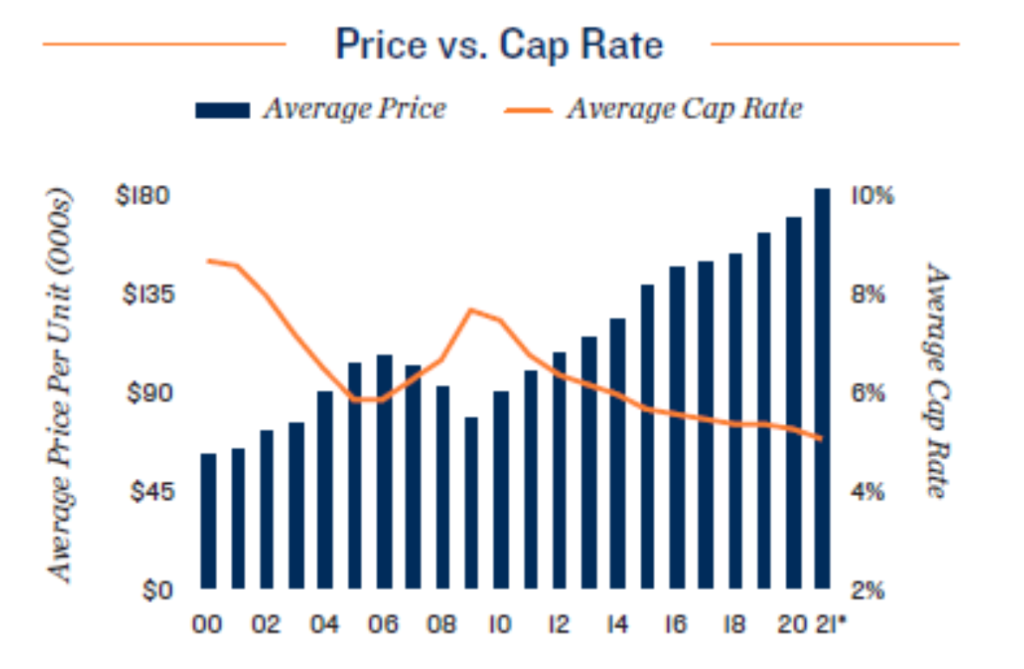
However, if one remarkable tailwind remains, it is all the dry powder out there. The Blackstone Property Fund, a non-traded Real Estate Investment Trust, surpassed $50 billion in assets last month and has been raising $2 billion per month from retail investors since the middle of 2020. $2 billion a month! Not sure that kind of inflow qualifies as “easy money,” but it is certainly a lot of capital to deploy. Meantime, M2 money supply (cash, checking and savings accounts, money market funds, time deposits), all earning negative real returns (after inflation), approximated $21.5 trillion at the end of 2021, another all-time high, and a decent chunk of those funds will likely end up being invested in riskier assets at some point. The only question is when and where these assets go.
In conclusion, I could really use a Ouija Board and some tea leaves to forecast 2022 with so much depending on what is challenging to predict or know: the pandemic and what happens post-Omicron, politics, the impact of changing Fed policy, inflation, interest and mortgage rates, and the employment picture. As an information junkie, it should be a very interesting year, and I will do my best to try and make sense of it all and hope you will stay tuned alongside me and the rest of the Clear Capital team as we endeavor to do so.
While the fundamentals for multifamily residential assets remain strong, we cannot ignore the impact that higher interest rates, slower economic growth, challenging collections, protective tenant policies, the changing employment market, and other uncertainties may have on rents and values
As alluded to above, I am often (and very appropriately) accused of repeating the same theme and beating the same drum every quarter, the “Gospel of Multifamily Investing.”™ I won’t plead the Fifth, but willingly admit guilt. For the last 20 years and more, I have preached that the future of housing in the U.S. is higher-density, multifamily housing, and that housing affordability would lead to increased relative demand for apartments, domestic migration (Manifest Destiny, in reverse, so to speak, as elaborated upon below), and multiple generations living under a single roof. These trends have come to pass, and I cannot see any reason as to why these macro-level realities will change any time soon, if ever.
However, to simply purchase assets indiscriminately, ignoring cycles, macroeconomic data, and geographic particulars (distinctions between various markets and submarkets), is not something we are ever going to do. The key is to recognize, appreciate, and evaluate the data, exercising even greater care and attention to detail while underwriting any potential investment opportunity. Obviously, we are not always right, but I believe our long-term track record speaks for itself.
Let’s start with some data from 2021 and the first part of 2022, which essentially tell the broad multifamily story. Rents and net absorption of units (net units rented) increased sharply during the year. Vacancies declined. In all markets. While the first graph is certainly eye-popping, the second may be more telling. Rents increased in every month of 2021 except December, when they declined ever so slightly. But the trend between the end of summer and year-end was telling, as rental growth moderated substantially during the latter half of the year. That is no surprise and was bound to happen, but is probative when thinking about 2022, when I expect rental growth to return to more normal levels, like those experienced prior to the pandemic.


To witness this sort of rental growth and a decline in the overall vacancy rate is quite remarkable, reflecting the economic and employment recovery, sharply higher single-family home prices, and moderating construction starts and units brought to market due to supply chain disruptions and a shortage of construction workers.


But it isn’t all peaches and cream, and higher rents, occupancies, and unit absorption can be deceiving, because all neglect to capture whether landlords are actually collecting the higher rents or whether tenants are moving and relocating as one would expect in a “normal” market. This is where the impact of the pandemic is clearly seen and skews the data. Collecting scheduled rents and evicting delinquent tenants remain challenges, even as eviction moratoriums burn off. In most jurisdictions, the courts are unable to process the backlog of unlawful detainer actions.
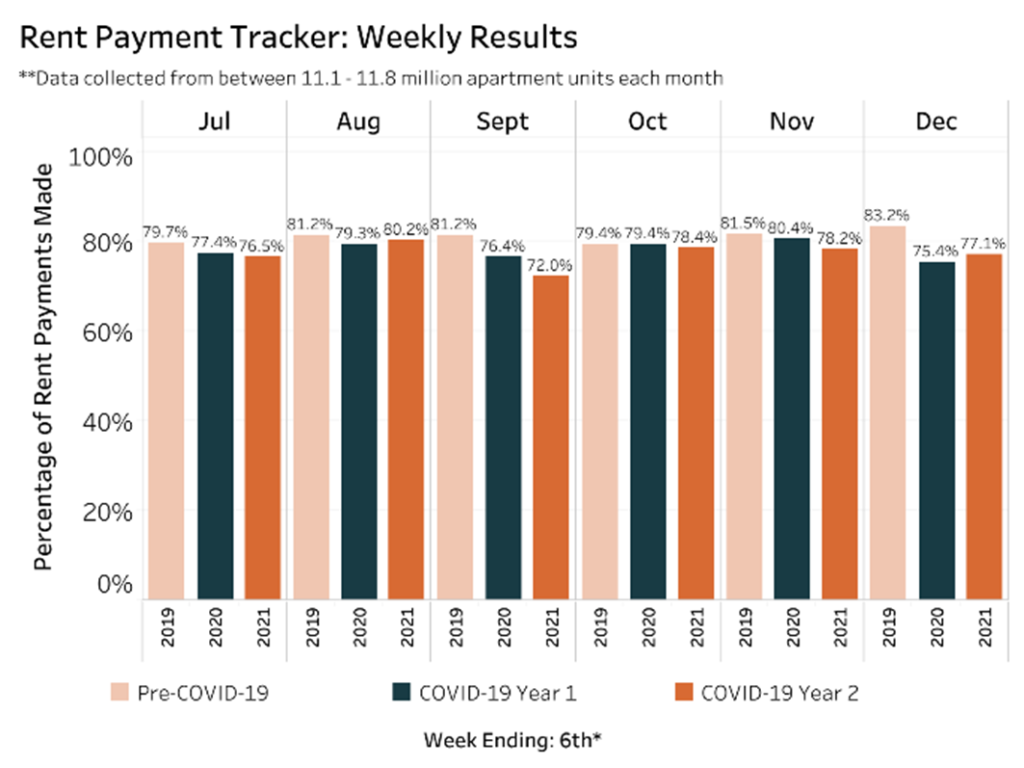
So, it is this sort of MMA battle between competing forces, as I so often describe. Demand is trickier to forecast because it depends on so many unknowns: changes in GDP and employment (which in turn are driven by everything from COVID to the future of remote work), the equity markets, interest rates, consumer sentiment, and household formation. There is no question that higher interest rates and elevated single-family home prices will increase demand for apartment units, all else equal. Otherwise, more precise demand forecasts are challenging.
Supply is a bit easier to forecast, if just because the amount of land available for development is essentially fixed and new housing units in the pipeline, whether single- or multifamily, can be quantified, at least to some degree. From my perspective, this has been and will continue to be the housing rub. We cannot construct enough units to catch up and keep up, and I cannot foresee that changing anytime soon, even with recent increases in multifamily starts. Besides, new units coming to market are virtually all “Class A,” focused on the higher end of the market, as opposed to workforce housing, the sort of assets that Clear Capital seeks to acquire.
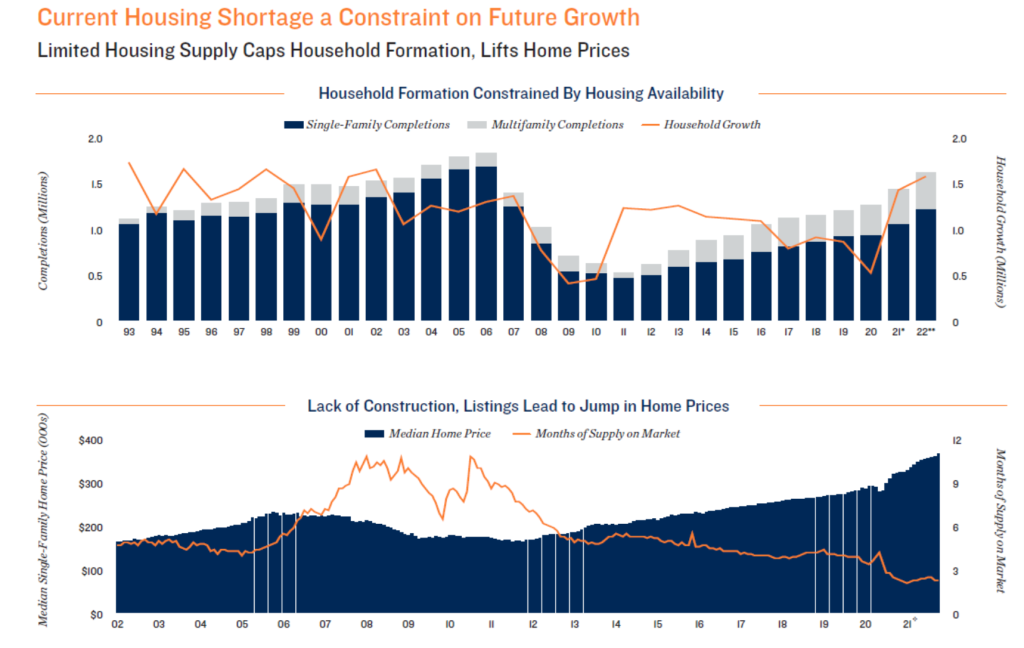

In summary, multifamily fundamentals remain solid and should benefit from an improving economy, labor market, higher interest rates (reducing housing affordability), and excess liquidity on the sidelines. But rental growth nationally this year will likely be quite modest, more like what occurred before the pandemic and during the latter half of 2021, while cap rates remain flat or even expand modestly.
So, what housing markets look best for 2022 and beyond? Where are potential apartment renters headed?
Location, location, location. Some may believe this platitude is the real estate equivalent of “Booyah,” but I don’t think so. It may be overly trite and simplistic, but we can all agree that there is a lot of truth to it. Not surprisingly, we spend a lot of time thinking about which markets in which we want to pursue opportunities, and then, in those markets we find attractive, the specific submarkets on which to focus. Consider our projects in Colorado Springs or Lakewood, both outside of Denver, or those in Gresham, Oregon City, or Eugene, Oregon, all essentially exurbs of Portland.
As we have discussed at length in previous quarterly updates, the U.S. population, like a fidgety child on a long car ride, has never sat still. For those of you are willing to head back to high school history for a moment (don’t worry, just a moment), we may remember being taught “Manifest Destiny,” the 19th century doctrine or belief that the expansion of the U.S. throughout the American continents was inevitable and justified. Perhaps not politically correct today, but the phrase “Go West, young man,” concerning our expansion westward, relates to Manifest Destiny.
Following World War II, as automobiles and highways became omnipresent, and so westward and southbound we went. To the suburbs we moved. To warmer locales, we flocked. My father did exactly that, moving from New York City (yes, the East Bronx for those of you interested in such things), to New Orleans for medical school, and then to Southern California for the opportunities it presented (thanks, Dad), including the opportunity to meet attractive and intelligent co-eds attending UCLA (thanks, Mom).

Fast forward to today, when we seem to have Manifest Destiny in reverse, at least in part. People are leaving the coasts, its high cost of housing, higher taxes, and crime, and heading to lower-cost states in the South, Southwest, Southeast, and parts of the Northwest. Data is a bit hard to come by, but according to the Federal Reserve Bank of Cleveland, about 1.1 million people moved from high-cost metro and coastal areas to either mid-size cities or rural areas since the start of the pandemic.
Texas, Arizona, Florida, Colorado, Montana, Oregon, and North Carolina all gained population according to the most recent census, while California and New York have lost residents. Not surprisingly, these population trends inform projections for rental growth in 2022 and beyond.



It is no surprise that the Sunbelt will likely see the greatest population growth in 2022, perhaps 250,000 new households. However, I am less sanguine about all these rosy rental growth forecasts, due to the uncertainties I have already discussed. As many of you know, we sold most of our Texas portfolio late last year because we were unable to achieve the sort of rental growth that we had predicted, in part because supply was able to mostly keep up with demand. In any event, many of the same locales that have been popular destinations in recent years from Phoenix to Vegas to Tampa to Atlanta to Sacramento will continue to be popular according to Freddie Mac. On a more macro-level, growth in the U.S. population continues to decline, a trend I have discussed for some time now, continually confirmed by new data.

This reality will have longer-term growth implications to be sure, perhaps another reason I don’t think Elon Musk has to worry too, too much about the need to colonize Mars, although I imagine numerous value-add investment opportunities await us there and elsewhere.
And single-family home prices in 2021? Wowza! But 2022 will likely look a whole lot different…
2021 was simply a remarkable year for the single-family residential market, with every single state realizing higher home prices. Just imagine that home prices in Arizona, Florida, and Idaho, rose 28.6%, 25.8%, and 25.5% in one year, respectively. “Wowza” really is the right word. One almost feels sorry for poor Alaska, which only experienced a 7.5% rise in home prices. The single-family market benefitted from an almost perfect storm of price drivers: record-low interest rates, increased household savings during the pandemic, a rising stock market, remote work, millennials entering homebuying years, institutional buyers loaded with capital, and reduced inventory and new supply.

However, these sorts of increases are not sustainable, and in the face of higher inflation and mortgage rates, slowing economic growth, the lingering pandemic, and broad uncertainty – economic and political –home prices are likely to remain flat this year, best I can foresee.
One impetus for higher home prices in 2021 was Wall Street and all the institutional i-buyers (e.g., Zillow, OpenDoor, and OfferPad) which were scooping up homes left, right, and center before they began to suffer some serious acquisition-related indigestion. Mark one in the “I got it right” column, as I have consistenly expressed pessimism about their strategies, basing purchase prices and home values on mathematical algorithms, while they forewent due diligence and purchased homes willy-nilly, for all cash and with quick closes. As though buying a home is like buying bubblegum at Walgreen’s. Even if their mathematical models were accurate, I could not detect a sustainable, scalable business model, especially in an economic downturn. It is equally likely that their models were a bit of GIGO, “garbage in, garbage out.”
Exhibit A for this colossal mess is Zillow, which announced a complete exit from the home-flipping business and is now offloading some 7,000 houses for $2.8 billion, on which it is expected to take a meaningful bath. Keep in mind that about 5.6 million single-family homes are sold in an entire year in the U.S. (plus about 700,000 condominiums). Whether their selling activity will depress prices in certain markets remains to be seen, but can we be surprised that they appear to have bought the most homes in Phoenix? From what I understand, a New York based investment firm has agreed to buy 2,000 of the homes from Zillow, so perhaps it depends on what this firm decides to do with them.


And sure enough, Zillow is not alone, as their competition is also starting to sell. Economics 100 tell us that this increased supply will negatively impact pricing, at least on the margin.

Meanwhile, more favorable longer-term trends in the single-family market persist, including a lack of buildable lots. Back in 2004 to 2005, homebuilders collectively generated new home sales of about one million units. And today? About 800,000. Will Rogers quote about “buying land because they are not making any more of it” was prescient. In a recent survey, about three-quarters of developers described the number of buildable lots in their markets as “low” or “very low”.
Meantime, supply chain and labor woes have provided and will continue to provide some downside buffers to single-family home prices. The cost to build a home is up about 20% over the past year, and most developments are at least two months behind schedule. I am sure more than a few of you have been experienced the supply chain challenges first-hand, perhaps a delay in the delivery of a washer and dryer or some other home appliance. We have. How long it takes for supply chains to return to normal is anyone’s guess, but given my penchant for cynicism, I am betting it will take more time than less.
In other single-family housing news, I recently read that Fannie Mae is going to increase the size of home mortgages that it is willing to back, to nearly seven figures, reflecting the obvious, that its previous ceilings were impractical in the face of higher home prices. As of now, the maximum loan limit is $647,200, so whether they follow through remains to be seen. Given that some 60% of single-family homes purchased in the U.S. are financed through Fannie, the change would be impactful.


Regardless, I believe home prices will be mostly flat this year or will trade in a modest range (up or down a couple of percent). I certainly don’t see a repeat of 2021, but on the other hand, I don’t see any impending collapse. The banks have been more prudent in their lending standards, supply remains low, and even with their recent rise, mortgage rates relatively low by historical standards.
Location, location, location? More like inflation, inflation, inflation….
Unless, you have been living under a rock (if you have, I hope it is not in the Sunbelt as it would get awfully toasty under there), rising prices and inflation have been on every consumer, investor, and policy maker’s mind of late, as we have recently witnessed inflation rates not seen for some 40 years. Consumer prices rose 7.0% in December, as compared to the prior year, even higher than November’s 6.8% rise, and levels not seen since 1982. One picture tells 1,000 words, and it’s not pretty:

Here’s the thing. After a year of brushing off these higher prices as “transitory,” it is proving anything but, and can we really be shocked? The Fed has printed money for over a decade like they would never run out of toner. Does anyone think that the bubbles we have witnessed in speculative assets (see November Clear Insights newsletter) and higher assets generally (including, yes, real estate prices) have strictly been based on fundamentals? Sure, those have been highly influential, too, but let’s not pretend that the accommodative Fed has not played its part.
Here are another couple of interesting pictures which tell the inflation story, and in ways that I found unique and interesting. The first summarizes – across various categories (i.e., housing, food, gasoline, new cars, wages) – just how many years it has been since inflation rates were as high as what we have recently witnessed. Let’s just say that it has been…a while.

The second presents similar data, in a different way, but with the same conclusion. Prices, wages, raw material prices, etc. are all experiencing well above normal price or rate increases.
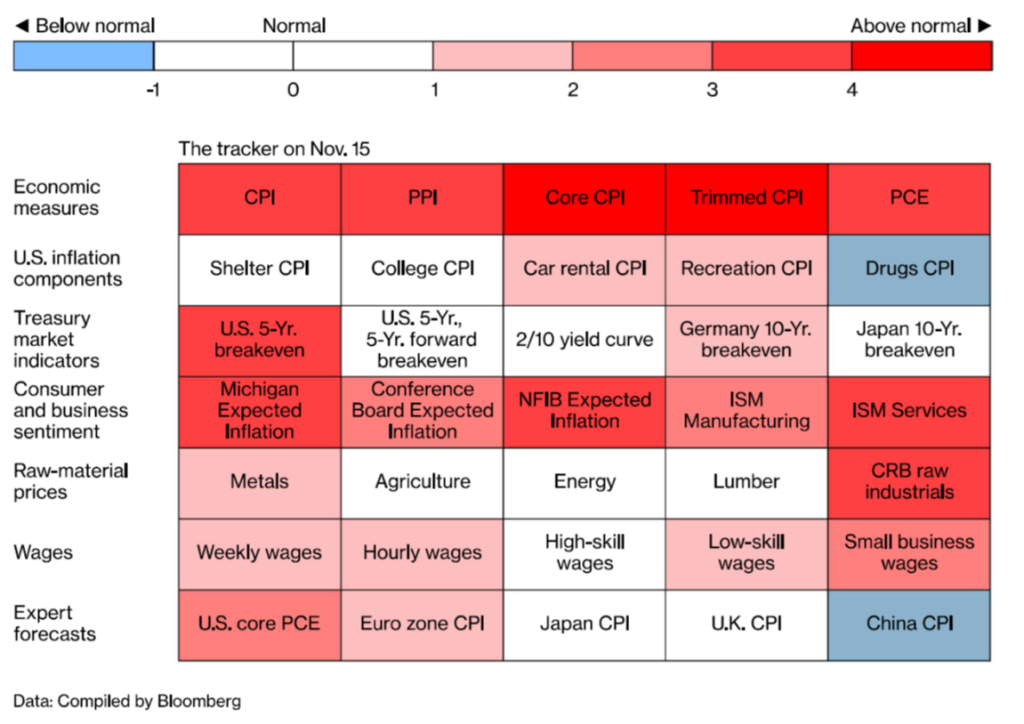
Perhaps the Fed mandate to promote maximum employment, stable prices, and moderate long-term interest rates is asking too much, as Jerome Powell and his predecessors are not Houdinis, and 2022 is most certainly not 1982, when the Fed Funds rate was 14.2% (that is not a typo), and “Quantitative Easing” (significant asset buying) was not in the lexicon. Today we have this unique situation where the Fed Funds rate is something like 0.08% and the Consumer Price Index over 7.0%, resulting in an inflation-adjusted, effective Fed Funds Rate of negative 6.96%, something never seen previously.

So, what is the Fed to do? Somewhere in the back of my mind, I am now hearing the Naked Eyes song from 1983 (no coincidence, perhaps), “Promises, Promises,” because just last week, the Fed announced that they will “tighten monetary policy” at a much faster pace than thought a month ago. Median forecasts are for the Fed to raise interest rates three times in 2022, starting in March, to 0.75-1.00% by year end, up from the two hikes forecast in December. We shall see.
What is interesting is that when the Fed made its last announcement and plans for two rate hikes in 2022, the markets essentially yawned. But not this time. If I have one other concern is if inflation, like everything else these days, becomes “politicized,” and blame for higher prices is placed on “greedy” corporations or “rigged” markets, instead of other obvious factors, like supply chain disruptions, pent-up demand, and the Fed’s money-printing ways. We should all be very wary of those calling for “price controls” as a policy response, because we must remember our economic history, like President Nixon’s predictably ill-fated efforts to freeze wages and prices back in the early 1970’s.
Because all this inflation talk can be fear-invoking and sobering, I would like to put one positive spin on the data, relating it back to what we do for a living. Thankfully, real estate has historically proven to be a good inflation hedge, something I wrote at length about in the August edition of our Clear Insights newsletter. Perhaps not surprisingly, those classes of real estate assets in which landlords are able to adjust rental rates more quickly in response to inflationary pressures do well. Historical data indicates that multifamily and industrial assets fare best in these environments, perhaps explaining, in part, their outsized performance in recent years.

In any event, higher inflation rates and a less accommodative Fed will act as significant headwinds to financial markets this year, and while multifamily investments will benefit from higher mortgage rates, making homes less affordable, these higher rates will impact asset underwriting and both purchase and projected exit cap rates.
While the employment picture has certainly brightened, folks are quitting their jobs in record numbers and who can blame them?
In one week, I read several articles which really captured what is happening in the job market. One was “The Great Resignation,” describing the record number of people, especially the young, leaving in their jobs due to everything from low wages, poor treatment, COVID, and new professional or personal opportunitites (e.g., education, cryptocurrency/NFT trading). As of year end, there were some 12 million job openings (including several openings at Clear Capital), as compared to about 7.5 million unemployed. In 2021, some 4.4 million left the workforce.

Another article that crossed my desk (or desktop) was “Companies Plan Hefty Raises for Workers.” While labor strikes at John Deere and Kelloggs were settled in November, the settlement terms spoke volumes. The Illinois manufacturer’s United Auto Workers voted in favor a new six-year agreement that included an $8,500 signing bonus and a ten percent wage increase, along with enhanced retirement and performance benefits. And then in following weeks, I read about strikes involving the Seattle Carpenter’s union, certain Denver-area grocery store workers, and some 17,000 BNSF Railroad employees. From Wall Street to Main Street, from London to Berlin to Los Angeles, wages are headed higher.

In the face of increases in food, energy, and housing prices, it is a necessity, and from my view, about time. I have long written about expanding wealth inequality and its perverse consequences. The graph below tells the story, and how we need to return to something more balanced when it comes to household wealth.

On the public policy front, there are just a couple newsworthy items from the fourth quarter
Somehow, some way, politicians here and everywhere provide fodder for these quarterly diatribes, usually suggesting, proposing, or implementing harebrained or shortsighted salves to address longer-term systemic issues. Here are a couple from the fourth quarter that fit the description:
- For all units subject to rent control (about 650,000 units, three quarters of housing stock), the city of Los Angeles decided to freeze residential rents until 2023. Yes, you read that right. No rent increases until 2023, decided upon at the end of 2021. How can this be sound economic policy, let alone Constitutional? Perhaps it was this story juxtaposed against another that broke on the same day that really got my goat, where a local anti-growth group is seeking to block a separate proposed housing plan by the city, which would allow for greater housing density and potentially add 500,000 units to the rental stock. What developer in their right mind would want to develop units in a city which is incessantly trying to rein in higher rents through price controls?
- From Los Angeles to the White House, from New Zealand to Ireland, politicians are mulling or implementing restrictions on who can purchase a home or adding taxes and fees to address housing affordability. Los Angeles City Council is supposedly considering a proposal that would not allow entities (e.g., corporations, limited liability companies) to purchase single-family homes, a completely impractical, if not unconstitutional policy. During the fourth quarter, New Zealand passed legislation eliminating certain tax breaks for property owners and investors and Ireland implemented a 10% tax on bulk buying of homes, which represent less than two percent of transactions.
None of these policies will meaningfully impact housing prices or rents. In this prediction, I feel pretty darn confident.
And despite this memo’s length, I will end with just a couple quick tidbits from the quarter that I found interesting or noteworthy
- By admission, I am always a late adopter when it comes to technology, and while I have an iPhone, I won’t tell you which model I own other than it is a few iterations behind. Anyhow, during the quarter, I read that Ukraine (of all places), may allow for Non-Fungible Tokens (NFTs) to signal proof ownership for certain financial assets or transactions, including the exchange of real property deeds, bypassing traditional intermediaries. I have always found title insurance and the entire recording process for deeds and real estate ownership to be inefficient, cumbersome, and excessively costly. I don’t know whether technology and real estate will finally meet, as they have been reluctant bedfellows. We shall see.
- In response to supply chain bottlenecks, CEOs are rethinking their global production playbooks, which could result in greater onshoring of manufacturing and distribution activities. If such comes to pass, the industrial market will receive another shot in the arm. Industrial rental rates have already doubled in the last 24 months.
In closing, I can’t say I am altogether unhappy to see 2021 in the rearview mirror, though the way 2022 has started, I am already longing for the good old days…all the way back to December. While I am a perpetual optimist, I am not one to simply don rose-colored glasses because my VSP insurance covers their cost. 2022 will likely present challenges, if just because higher inflation, a less accommodative Fed, the lingering pandemic, and the midterm elections increase uncertainty and present tailwinds. And let’s be candid. Financial and real estate markets have performed so well for so long, more modest expectations and returns ought to be in the cards regarldess.
What this means for Clear Capital is simple. We will have to be especially mindful and critical when underwriting potential acquisitions, stress-testing key assumptions and what-if scenarios. We will likely monetize certain assets in certain markets, where we have realized projected returns and see limited upside, perhaps entering new markets as we remember hockey great Wayne Gretzky’s simple message, that success is figuring out where the puck is going and not where it has been.
Finally, and as always, thank you. Thank you to our investors, partners, vendors, employees, friends, and the entire Clear Capital and Clarion Management teams for their support and extraordinary efforts during a challenging year. I remain grateful and feel very fortunate to work alongside such a talented and dedicated group of individuals.
Best,

Eric Sussman
“It’s no wonder that truth is stranger than fiction. Fiction has to make sense.”
– Mark Twain“You see, but you don’t observe. The distrinction is clear.”
– Sherlock Holmes (Arthur Conan Doyle)
As a kid, I devoured mystery and detective books, and might even have been considered a Hardy Boys groupie. I read every new release in the series almost as soon as a new one came out. In any event, no crime was too complicated or any mystery unsolvable for Frank, Joe, and the Hardy Boys’ high school chums, and they were coincidentally fortunate that their fictional hometown of Bayport, New York was so riddled with shady characters and crime syndicates. Perhaps if Bayport were a real place, Clear Capital might consider investing there as a contrarian, value-add play.
Fast forward to today, as I wade through and try to make sense of a barrage of complex, if not seemingly contradictory, third quarter economic data, I sure could use the Hardy Boys, Nancy Drew, Encyclopedia Brown, Sherlock Holmes, and their hangers-on to help answer the numerous questions and solve the mysteries that surround today’s markets and the economy:
- Is this recent bout of inflation we have experienced transitory or something longer lasting?
- Are we going to experience a repeat of the 1970’s “stagflation,” reliving the worst of two worlds, economic stagnation and higher prices?
- When will all the missing workers return to the workforce? At what cost?
- How much higher can asset values, including real estate prices, go?
- When will the Fed taper its bond-buying activities and/or increase interest rates?
- When will the bottlenecks surrounding supply chains clear?
- Will Evergrande and other Chinese developers go kaput, with the impact felt in our markets?
- Are we finally getting towards the end of the COVID-19 tunnel? What will the post-COVID workplace look like longer-term in terms of remote work?
- Will politicians at all levels actually and meaningfully legislate, and what impact might new laws and regulations have?
- Will there be a second season of Squid Game?
These are some weighty questions worthy of discussion, and though I recognize the limits of my psychic abilities, I will weigh in on each, with apologies in advance that I don’t have the Hardy Boys et al to lend an analytical hand or four.
Regardless of how these economic question marks and mysteries are solved and resolved, I remain confident that housing prices and rents – whether single- or multifamily assets – will be heading higher in coming months and years, with non-coastal markets continuing to outperform
I suppose it is a question of perspective of whether this prediction is a positive or negative.
For Clear Capital, investors, and others that own financial assets, including residential real estate, this prediction would certainly be welcome and positive. On the other hand, for those seeking to purchase their first homes and/or those concerned about housing affordability and homelessness (all of us, I imagine), this reality would also have certain perverse outcomes. It is truly a two-sided coin.
The third quarter was a very positive one for landlords and owners of residential assets, characterized by significantly higher housing prices and rents. Once again, several pictures tell the story, whether one is analyzing single- or multifamily markets. Prices and rents increased and increased sharply.

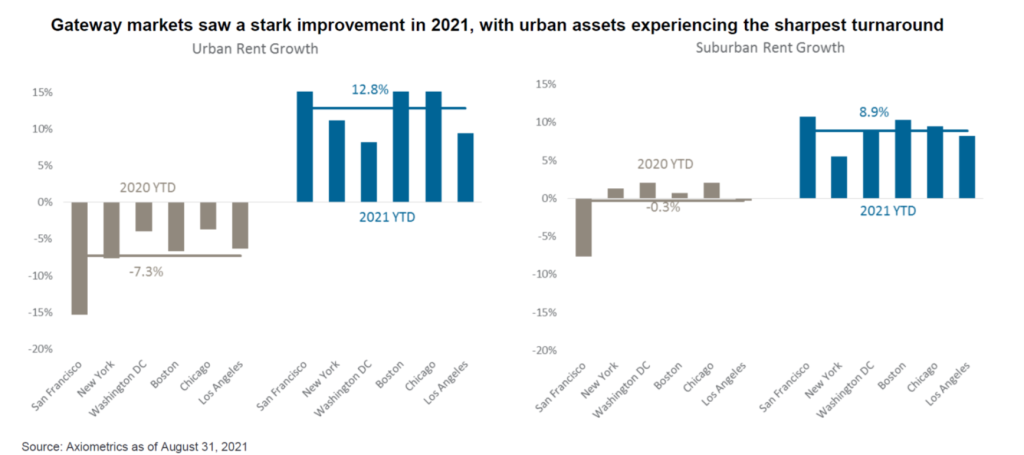
Nationally, home sales surged in September, with existing home sales up 7% (versus August), amidst already record-high prices, which were up another 1.4% from the prior month, and over 19% year-over-year. Here in Southern California, prices were up 1.3% in September, with the median sales price reaching $688,500, up 12.9% from the prior year.
In 182 of the 183 residential markets tracked by the National Association of Realtors, prices were higher year-over-year. In Austin, nearly 2,700 homes have sold for $100,000 or more above asking prices thus far in 2021. And in another telling anecdote, a Bay Area broker commented that she was not at all surprised that a home listed for $850,000 received six offers above its asking price, ultimately selling for seven figures, but that she was surprised that she received one offer below the asking price. I cannot recall ever hearing an agent being surprised at receiving an offer below its listing price.
And who is doing all of this buying? Well, in certain markets, it is institutions, the Zillows, OpenDoors, Blackstones, and Invitation Homes of the world, and amazingly enough, more institutions are entering the fray (e.g., Flyhomes, Ribbon, Home-Light). Literally two days after I put the finishing touches on my last quarterly memo, I read an article about Tricon Residential, Inc., a Toronto-based company which already owns and rents about 25,000 homes, which announced that it is partnering with a Texas pension fund to acquire another $5 billion of U.S. houses to convert them to rentals. That is not a typo. $5 billion, which will theoretically allow for the purchase of 18,000 more homes, plus or minus. Institutions have already bought between 15 and 20% of all single-family homes sold thus far in 2021.
I cannot fathom how these business models or trends are sustainable. In fact, Zillow just announced last week that it was suspending its homebuying activities after buying 3,800 homes in the second quarter, resulting in a little single-family indigestion. Keep in mind that Zillow had announced plans earlier this year to acquire 5,000 single-family homes each month by 2024. Oops. Now I just hope that Zillow is willing to share their residential Pepto-Bismol with Tricon and others. Certain institutional investors, so-called “i-buyers” are buying homes sight-unseen, based strictly on mathematical algorithms (think “Zestimates” from Zillow).

The tremendous imbalance between demand and supply for housing, exacerbated by the impact of institutional homebuying, unparalleled liquidity, low rates, higher construction costs (e.g., labor and materials), anti-growth sentiment, and political shortsightedness will likely ensure that even higher home prices are in our futures.
Another interesting tidbit that caught my eye was that the top-performing single-family residential markets in recent years have been those with longer commutes to job centers (read: urban cores), according to the Brookings Institution. For the two years ended May 2021, home prices in neighborhoods with 70-minute commutes rose over 30%, strongly outpacing the 9.2% price gain and 2.5% price decline for markets 20 minutes and 10 minutes from job centers, respectively. The growth in such markets has led to those “exurbs,” areas that have seen significant net migration. Keep in mind that these trends pre-date COVID, which only accelerated them.
These exurb-type markets are really the ones worth watching, as they attract companies and employees alike, all seeking lower-cost locales. Take South Carolina’s Berkeley County, about 30 miles northeast of Charleston, which saw its population grow nearly 30% over the past decade, and local officials predict that the county’s population of 230,000 will grow to at least 350,000 in the next 20 years. While we have looked at investment opportunities in Berkeley County, Clear Capital’s investment strategy is absolutely informed by such data points, as we invest in exurbs closer to home.
And multifamily markets? Asking and effective rents hit record highs, with asking and effective rents nationally increasing 7.5% and 7.9% nationally, according to Moody’s Analytics REIS, the highest quarterly growth experienced, at least since the firm began to track such data in 1999. Net absorption in the third quarter exceeded the first two quarters of 2021 combined, with third quarter demand representing record highs, resulting in the vacancy rate for the top 79 metros tracked by REIS dropping 60 basis points, to 4.7%. Household incomes for new renters reached a new high, at more than $70K/year. Data from Yardi Matrix provides additional color on the broader data:
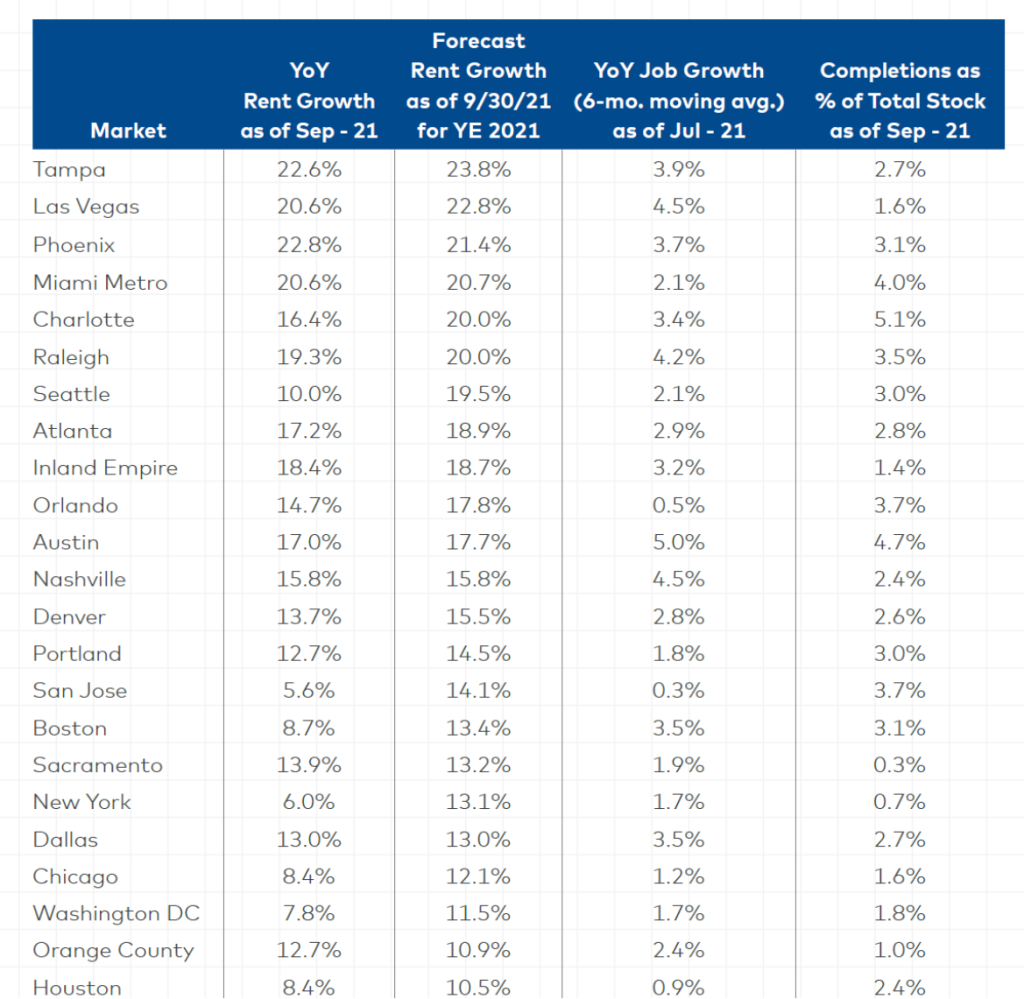

Meanwhile, rent collections post-COVID continue to lag, as the National Multifamily Housing Council found that 78.4% of apartment households made a full or partial rent payment through the first week of October, a one percent decline from the same period in 2020. Los Angeles landlords are owed at least $3 billion in back rent, according to a report co-authored by researchers at UCLA and USC. Across our portfolio, we are still owed significant sums in back rent, and we continue to await payments from the various rental assistance programs. For example, here in California, the State has disbursed less than 20 percent of the $1.4 billion in rental assistance aid that was given to the State by the Federal government, at least at last look.

Finally, as eviction moratoriums are lifted, what will the impact be? Will there be a tidal wave of defaults, foreclosures, and evictions? Some 2.8 million households, comprising nearly 7.5 million individuals, are behind in their rent. However, my sense is that a combination of financial aid, rental assistance, and lender/landlord forbearances will stymy any significant increase in foreclosures or evictions, but time will tell.

There is one final topic I thought I would mention briefly before I move onto other subjects. During a recent UCLA Anderson event, I was asked by a former student as to how climate change might impact real estate values looking forward. It is not something I have completely ignored, as I did check predictions about future sea levels when I purchased an income property for my own portfolio down in the Pacific Beach area of San Diego a few years ago.
However, his question made me think more broadly about not just rising sea levels, but about fire risks, and its potential impact on future development and insurance costs, the latter of which is something I have discussed previously. Sure enough, just a few days later, an article appeared in the WSJ about a proposed housing development in Colorado Springs, where we own some assets and are buying others. In this case, a proposed development, a 420-unit project, “2424 Garden of the Gods,” was shelved because of concerns surrounding wildfire evacuations in the area. Similarly, in August, a California appeals court blocked a planned expansion of a resort near Lake Tahoe after agreeing with concerns raised by environmentalists about fire evacuation risks.
Therefore, his question was not only timely, but important. Rising sea levels, in addition to increased levels of drought and associated fire risks, will meaningfully impact real estate. On the one hand, insurance costs are going to continue their upwards march, and in some cases, may be impossible to procure. I bet more than a few of you have received “Notices of Non-Renewal” from your insurance carriers because your property poses “excessive” fire risk. I have. On the other hand, anti-development activists will have another tool in their arsenal, as they argue, in some cases with justification, that certain projects should not be approved because of wildfire risks. Ironically, the decision to mothball the Colorado Springs project may be good news for us, at least marginally, because caps on supply translate to higher rents, all else equal, and we will own three assets in that market by year end.
Higher inflation will persist, at least when it comes to wages, commodities, housing costs, and asset values
As I wrote in one of my recent, more condensed (yes, thankfully), monthly memos, I have always marveled at how Costco has been able to sell a mammoth-sized hot dog and bottomless soda for $1.50, and $4.99 for an entire ready-to-eat roasted chicken, year after year after year. During my last visit a mere three weeks ago, I was profoundly relieved to see that those prices still have not changed. Yet, everywhere else one looks, and I mean virtually everywhere, prices are higher, if not much higher, than they were in the not-too-distant past.
Inflation, as measured by the Bureau of Labor and Statistics, increased 5.2% in August (versus the prior year), excluding food and energy, the third time in the last four months that increases in the consumer price index have exceeded five percent, well above the Fed’s two percent target.

While the Fed has indicated that annual inflation will return to two percent by 2022, that seems like a pipe dream, at least according to investors, who are predicting that the consumer price index will rise by an annual average of 2.64% over the next decade, based on recent pricing in the TIPS (Treasury Inflation-Protected Securities) market:

Meanwhile, there is simply too much liquidity on the sidelines for asset prices not to go higher: $20 trillion in M2 money supply and nearly $7 trillion in cash and investments on corporate balance sheets, mostly earning negative real returns. Much of that capital will eventually find its way into the economy and markets, driving real estate and equity markets higher. The impact of the unprecedented largesse of the Federal Reserve, perhaps borne out of economic and COVID necessity, will prove long-lasting, or at least for the next several years, as I see things. Two pictures tell a thousand words.
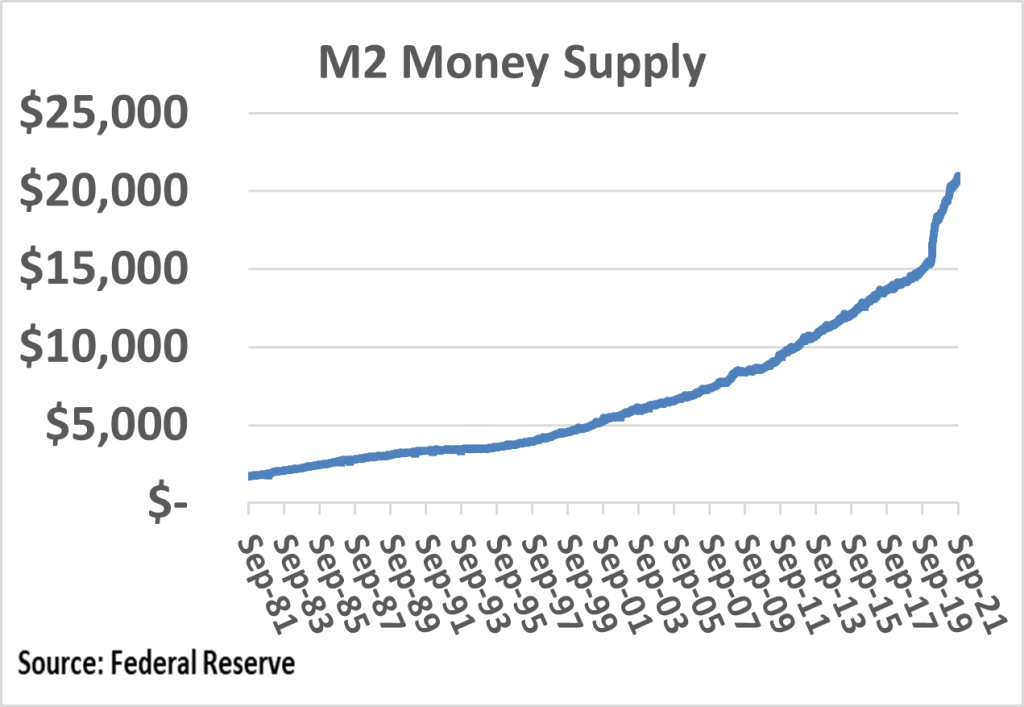

In fact, it can come as no surprise that Google recently announced it was purchasing a Manhattan office building for $2.1 billion, while in 2020, Amazon acquired the nearby former Lord & Taylor department store for nearly $1 billion and Facebook purchased REI’s office campus in Bellevue, Washington for $368 million. Expect more of the same looking forward.
Meanwhile, wages are heading higher, and materially so. Recent labor strikes experienced at John Deere and Kellogg’s are only the beginning, and the principal way to move workers off the sidelines and back into the workforce, is higher wages. In this new reality, Walmart recently increased its minimum wage to $15 across the entire company, and check out this Bank of America advertisement, which appeared in last week’s Los Angeles Times:

Although perhaps not a universally held view, I have long argued that wages need to be higher, and while I might be biased because higher wages will likely translate to higher residential rents, I believe that the widening gap between the haves and have-nots is economically and socially destabilizing. Since 2010, U.S. home prices have increased by a whopping 153.3%, compared to far more modest wage gains of only 14.2%, essentially matching annual inflation rates (about 1.25% per annum). The chasm between the haves and the have-nots has never been wider. Again, a couple pictures provide meaningful perspective.
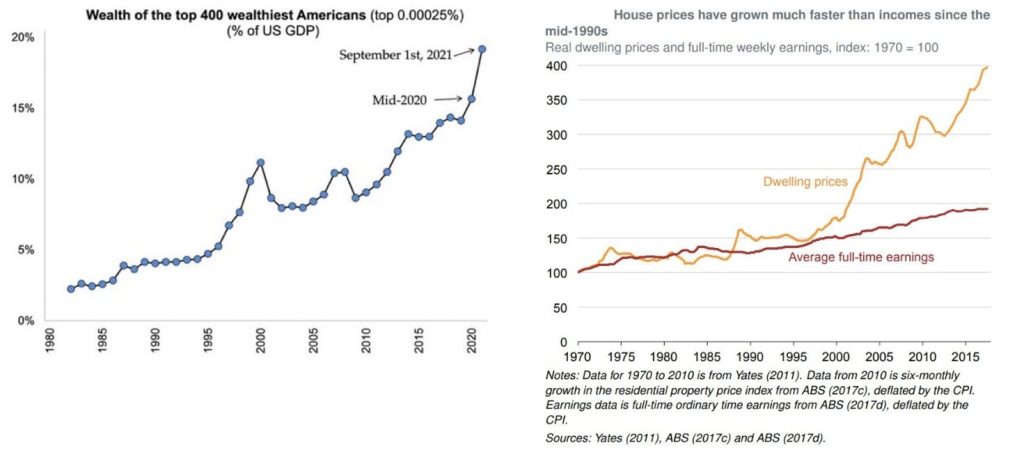
Obviously, the biggest concern is that we enter some sort of perverse time machine and head back to the 1970’s, when inflation averaged 6.8% per year. Disco, bell bottom jeans, Studio 54, and hour-long gas lines (my mother’s Dodge Dart, the affectionately nicknamed Red Bomber was a real guzzler) were bad enough, but a return to 1970’s-like inflation would be deleterious, to say the least.

Food prices globally are up 30% this year, and oil prices recently surpassed $80 a barrel, a price last seen seven years ago, almost to the day. And this chart is, perhaps most frightening, apropos of the Halloween season, where slowing growth and inflation become unwanted bedfellows.

While the three A’s (Amazon, automation, and artificial intelligence), low fertility rates, and other demographic shifts provide deflationary counterforces, and all that money supply should keep interest rates low (or lower than they otherwise would be), the excessive liquidity, upward pressure on wages, coupled with supply chain disruptions and pent-up demand, will provide more than worthy inflationary competitors. It’s truly an MMA battle of competing tailwinds and headwinds, and my money is on asset inflation, net-net.

However, if the bond markets are to be believed, the high inflation we have experienced in recent months will, in fact, prove temporal, and I, too, cannot foresee a return to the 1970’s, if just because unions lack the power that they had back then, automation is increasing, and policymakers have thankfully learned a thing or three in the last 50 years. That is not to say that the Fed’s two percent target will not be breached, given the factors we have discussed (e.g., excess liquidity, supply chain challenges) as the TIPS market is already predicting somewhat higher inflation, but even if that 2.64% annual inflation comes to pass over the next decade, it should not be worrisome. Stay tuned.
The Fed is walking a very precarious tightrope, as it tries to thread an economic needle
Taper and raise interest rates too quickly, and the Fed risks pushing the economy into recession and economic stagnation. Continue their $120 billion a month bond-buying spree and a near-zero interest rate policies, and they risk adding more fuel to the inflation fire, if not asset bubbles, something we are already witnessing in several corners of the markets. Exhibit A might be this past weekend’s headline from the WSJ: “Trump SPAC Swept Up in GameStop-like Frenzy.” Buying frenzies in everything from cryptocurrencies (yes, Bitcoin has raced to record highs recently) to certain SPACS (check out “DWAC,” the stock symbol for the new Trump social media SPAC) to single-family-homes makes me inherently uneasy. And as I have discussed at length previously, the Fed’s Balance Sheet has already experienced unprecedented expansion in recent years.

My sense is that the Fed is going to maintain the status quo for now, until there is clearer economic direction. As I mentioned, the bond markets don’t seem spooked by the specter of higher inflation or interest rates, and rates remain low, even with 10-year Treasury yields now trading at about 1.60% (versus 0.97% at the end of 2020).
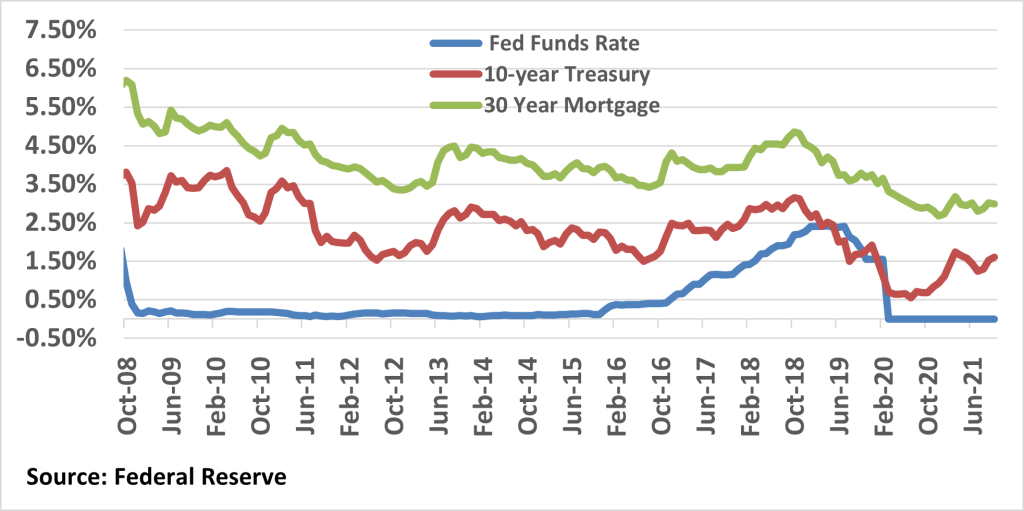
In recent Congressional testimony, Fed Chair, Jerome Powell agreed that “we are seeing upward pressure on prices, particularly due to supply bottlenecks in some sectors,” and stated that “these effects have been larger and longer-lasting than anticipated, but they will abate, and as they do, inflation is expected to drop back toward our longer-run two-percent goal.” His subsequent commentary was fairly generic, as he ambiguously stated that the Fed will respond to “market shifts,” whatever that means. We will just need to stay tuned, and we will.
Supply chain bottlenecks, resulting in dozens of ships anchored off our coasts awaiting delivery of goods and empty store shelves, will clear in time, but how long that takes is unclear
It is not merely a shortage of truckers, labor shortages generally, or new environmental regulations causing our supply chain bottlenecks, though they are certainly significant contributing factors. Frankly, COVID-19 and the economic dislocations it caused revealed longstanding risks and vulnerabilities of interconnected and geographically concentrated global supply chains. While the bottleneck should clear in the coming months, policy makers and businesspeople alike will need to rethink supply chains and how they procure goods and services to prevent future disruptions. The primary beneficiary in the real estate market will be industrial assets, which will benefit from the onshoring of previously outsourced goods.
Because the real estate sector accounts for such a significant part of China’s economy (20 to 25% of GDP, versus 15 to 18% here in the U.S.), China cannot afford widespread failures in the sector for fear of the resulting fallout
While Evergrande and its compatriots (e.g., Sinic Holdings and R&F Properties) are clearly over-leveraged ($2.8 trillion in debt, collectively), the Chinese government will likely bail them out in some way, shape, or form, having learned the lessons from Lehman Brothers’ collapse and the subsequent financial crisis. Perhaps we should think of the real estate tightrope China must deal with as analogous to the challenging balancing act our Fed must perform. I just don’t see China allowing a wave of developer defaults, and in fact, late last week, Evergrande made some outstanding and past-due interest payments.
But that is not to say it will be easy or painless. In fact, just last week, China disclosed that its third quarter growth in GDP was 4.9%, which hardly sounds unhealthy, but it compares quite unfavorably to 2020’s third quarter growth of 7.9% and higher analyst forecasts. With countless construction projects now being halted, China’s GDP data may be even more sobering in coming quarters. However, I don’t anticipate that China’s real estate challenges will spread to our shores in any meaningful way.
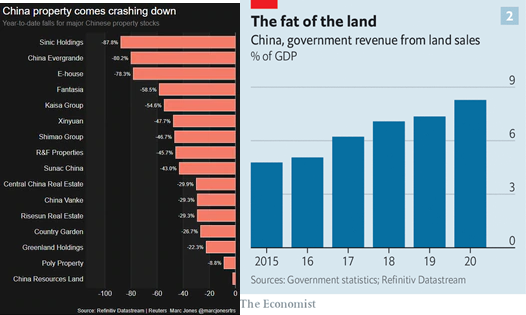
Remote work, or some sort of hybrid-work model, will persist, allowing some workers to live remotely indefinitely, with long-lasting impact on secondary and tertiary real estate markets and their suburbs
Just before the second quarter ended, Price Waterhouse announced that none of its 40,000 workers need return to the office, adding to the dozens of others companies that have made similar announcements (e.g., Adobe, Capital One, Coinbase, Dropbox), at least for a portion of their employees. As a result, the demographic shift we have seen over the last decade, with significant numbers of households relocating from urban cores to suburban secondary, tertiary, and quaternary markets will persist.
In fact, I recently learned a new word, “Exurb,” referring to suburbs of suburbs, which have experienced significant growth in recent quarters, in part due to the trend of relocating workers. Areas outside of Denver, Salt Lake City, Phoenix, Charlotte, or Nashville represent these new and growing exurbs. The shift to remote work will provide additional tailwinds to these markets, and Clear Capital’s strategy and acquisitions of assets in these markets is no accident.
Political paralysis will persist, minimizing the likelihood that meaningful legislative changes to public policy, spending, or taxes that might impact real estate markets are significantly reduced
A question I am frequently asked is what is likely to happen to tax rules surrounding 1031 transactions, in which gains realized from the sale of investment property can be deferred, so long as the sales proceeds are reinvested in another investment property (or properties) in a timely manner. You may recall that President Biden has on more than one occasion indicated that this provision of the tax code ought to go the way of the dodo bird. Well, I think we should rest easy. While the current version of Biden’s tax reform bill does cap 1031 transactions at $500,000, I see little, if any, chance that the legislation will be passed.
After all, the Administration is still focusing on the stalled $3.5 trillion infrastructure legislation, which has now been reduced to less than $2 trillion, and any vote on that legislation still seems out of view. The parties themselves can’t seem to agree on much, with political infighting providing meaningful legislative impediments, with numerous old-timers being “eliminated” in quasi-Squid Game style, as they decide not to run for reelection or lose primary battles. On a more local level, politicians will continue to address housing affordability and homelessness with their typical incompetence and myopia.
During the quarter, California Governor Gavin Newsom, having survived the recall effort, signed into law Senate Bills 9 and 10, which eliminates R-1 zoning, and allows for up to four units to be built on lots previously restricted to single-family dwellings. While perhaps a step in the right direction, the impact will prove marginal, likely adding less than half a million new rental units. The new law does nothing to address other impediments to new construction, from higher building costs, labor shortages, and the need for local officials to approve projects more expeditiously. For example, when Los Angeles passed an ordinance allowing detached garages to be converted to dwellings (Additional Dwelling Units or “ADUs”), the ordinance required that the city approve qualifying projects within 30 days. Well, approvals are now taking more than six months. Color me shocked.
Finally, there are two other public policy related tidbits I thought I would mention, one from across the pond, in Berlin, which you may recall enacted the most restrictive rent control policies I have ever encountered and described previously. Well, in late September Berlin’s voters decided to expropriate apartments from any landlord which owns more than 3,000 units in the city, a move akin to eminent domain. The referendum is not legally binding, so the next move belongs to city officials, which would need to acquire the properties from these landlords, requiring some 40 billion euros. Where it would find this sort of funding is beyond my knowledge. Perhaps it should just issue its own cryptocurrency and purchase the assets with a new “Berliner Coin.” Sarcasm aside, I don’t believe that the city will expropriate anything meaningful, but it speaks to just how deep divisions are between landlords and tenants in certain housing constrained markets, and radical maneuvers being considered to address them.
Lastly, I came across a story in the Los Angeles Times a couple of week ago, describing how a local judge struck down a previously approved 1,119 residential housing project in San Diego County (Otay Ranch), which would have included commercial stores, a new school, and a fire station. The project was consistent with zoning regulations, had been approved by the County Board of Supervisors, and was supported by local fire officials. However, the development was opposed by the Sierra Club and a group of other environmental groups, who raised concerns that the project did not do enough to address affordability issues, wildfire risks, greenhouse gases, and the potential impact on the endangered “Quino checkerspot butterfly.” Without commenting on the case specifics, the story reflects why housing supply cannot possibly keep up with demand…and won’t, in California, or just about anywhere else.
Where have all the workers gone and when will they return to participate in the labor force?
While the overall unemployment rate dropped in September, to 4.8%, some ten percent below where it was in April 2020, when some 23 million people were unemployed immediately following the COVID outbreak, we are experiencing near record-low rates of labor participation during an economic recovery. Is this going to be the latest installment in the Hardy Boys series, “The Mystery of the Missing Worker?” Well, according to the Department of Labor, there were nearly 11 million job openings at the end of July (seasonally adjusted), or 1.3 jobs for every person considered unemployed, records for both metrics, so perhaps the Hardy Boys could indeed have a meaningful mystery on their hands.


Is it really all about unemployment benefits, as some would have us believe? No. While certainly impactful, the labor shortage is multifactorial, as I have discussed previously, and we should all avoid simple singular narratives trying to explain complex topics like the labor shortage. Sure, enhanced federal and other unemployment benefits and government-sponsored assistance programs were impactful, but the causes are numerous, from a lack of childcare, lingering concerns over the virus, a reduced worker base in urban cores, increased automation, inadequate wages, and/or retiring Baby Boomers (and others, perhaps). Some may simply be fighting employee mask mandates or trading various cryptocurrencies.
In fact, the labor force shrunk in September, for the first time since May, indicating that lots of folks seem content with sitting on the sidelines. Despite record job openings, employers only added 194,000 jobs in September, below expectations for the second consecutive month. In August, the economy added just 235,000 jobs, less than a third of the 720,000 that was anticipated.
Finally, real estate developers are on the front lines of the labor shortage. In a recent poll conducted by the National Multifamily Housing Council, 50% of respondents said they had been impacted by the lack of available labor. Thus, contractors and real estate developers are being hit with multiple whammies, a shortage of labor and materials, along with higher prices for both.
And, as always, here are a few other tidbits I found newsworthy from the third quarter
- The 2020 Census data is out. Initial details from the 2020 Census were released in August, revealing a few noteworthy data points. One is our increasing diversity, as our non-Hispanic, white population declined 2.6% over the last decade, while the country’s total population grew only 7.4% during the decade, the second slowest on record, second only to the 1930’s, the period of the Great Depression. Meantime, the under-18 population decreased, by 1.4%. I find our slowing and aging population growth to be concerning, as it will translate to slower economic growth and deflation. We do not want to repeat the mistakes of our Japanese friends, who have suffered with the consequences of unfavorable demographics – slow population growth and an aging populace – for decades.
- The corporate diaspora continues. Over the last few years, I have written extensively about population moves away from the coasts. Frankly, this reality has driven much of Clear Capital’s acquisition strategy, as we pursue opportunities in the Southwest, Northwest, and Mountain West regions of the country. However, the population shift is both a cause and effect of corporate migration, which has also been occurring, as large, multinational companies relocate from the coasts to less expensive locales. In mid-August, AECOM, the large infrastructure, construction management, and engineering firm with deep and long-standing roots in Southern California announced that it is relocating its headquarters to Dallas. About three weeks ago, Tesla officially announced that its new headquarters will be in Austin, a move from Fremont, in Northern California. These two companies are now part of a fraternity that includes Hilton, Northrop Grumman, Occidental Petroleum, Nestle, Toyota, CBRE, and hundreds of other companies who have relocated over the last decade or so.
- Household debt continues to soar. U.S. household debt soared to nearly $15 trillion in the second quarter, increasing by $313 billion (2.1%), the largest nominal jump since 2007. Mortgage balances – the largest component of household debt – rose by $282 billion, while auto loans, credit card balances, and student loans increased by $33 billion, $17 billion, and $14 billion, respectively. Mortgage originations (including refinancing of existing mortgages) reached $1.2 trillion, surpassing volumes in the preceding three quarters combined. The data is likely skewed by COVID and pent-up demand, but low rates, an improving economy, higher asset prices, and all that liquidity are impacting household borrowing and leverage. While I do not see excesses or the sort of reckless lender behavior witnessed before the last financial crisis, I am watching the data carefully. We all should.
In closing, it has been a newsworthy quarter, such that the Summer Olympics and Afghanistan withdrawal debacle seem eons away, like distant memories. Many challenging questions remain, and I don’t think even a consortium of Sherlock Holmes, the Hardy Boys, and the Psychic Friends Network can provide definitive answers as to what lies ahead. Regardless, I remain convinced that higher asset prices, longer-lasting inflation, higher wages, and anemic economic growth will characterize the remainder of this year and next, while politicians continue to spend more time talking to news outlets and any microphone in front of them than legislating in any meaningful way. Let’s hope I am wrong in a few of my predictions.
As always, I would like to express my sincere appreciation and thanks to you, our investors, supporters, and friends as well as the entire Clear Capital and Clarion Management teams for their extraordinary efforts over a challenging period. I remain grateful and feel very fortunate to work alongside such a talented and dedicated group of individuals.
With that being said, I would be terribly remiss if I did not end this missive by acknowledging the loss of one of our own, Clear Capital’s very first employee, Dan Lukes, Director of Asset Management, who passed away from COVID last month. Dan’s contributions to the firm were immeasurable, and he will be profoundly missed, personally and professionally. Our sincere and heartfelt condolences go out to his colleagues, friends, and family members. May his memory be a blessing.
Best,

Eric Sussman
“Inflation is when you pay fifteen dollars for the ten-dollar haircut you used to get for five dollars when you had hair.”
– Sam Ewing“Money can’t buy you happiness, but it does bring you a more pleasant form of misery.”
– Spike Milligan
As I watched Richard Branson, the eccentric billionaire and founder of the Virgin Group, rocket to the edge of space last weekend, I felt profoundly mixed emotions. On the one hand, I marveled at the achievement that the first suborbital passenger flight to space represents, and human ingenuity, generally. Although I have absolutely zero interest in traveling to Mars (just getting to the office in Los Angeles traffic or fighting for a parking space at Costco are exciting enough) or starting an interplanetary real estate fund (not yet, but stay tuned!), the launch was thrilling to witness. Perhaps the flight was not quite as dramatic or significant as Apollo 11’s historic moon landing, but it certainly represents a significant milestone.
At the same time, however, Mr. Branson’s flight reminded me of the significant challenges we face back here on planet earth, and whether the billions being spent on these space-seeking endeavors by Branson and his billionaire brethren, Elon Musk and Jeff Bezos, could help address problems we face closer to home: increasing wealth inequality, a lack of affordable housing and homelessness, the private sector’s encroachment on and need to assume what were previously public sector responsibilities, the challenges businesses are facing to fill job openings, concerns about inflation, the lingering impact of the pandemic including a recent resurgence in cases and hospitalizations, and record heat waves and drought in some parts of the world and record flooding in others. And to think I did not even mention the toxic political environment, the tragic collapse of the Surfside condominium complex, or Brittany Spears’ conservatorship troubles.
I suppose it is a question of perspective as some of these realities present opportunities for Clear Capital and investors generally, who benefit from higher real estate values, rents, and stock prices, fueled in part by the impact these challenges create: a material undersupply of housing (both single- and multifamily), persistently low interest rates, and record levels of liquidity and household wealth. While we continue to face challenges with regards to rental collections, the lingering effects of the pandemic (past due rents across our self-managed assets exceed $4 million), and the uneven economic recovery, operating metrics (e.g., economic occupancies, rental rates) across our portfolio have improved substantially in recent months.
Thus, despite so many broad social, political, and economic challenges, the underlying fundamentals and outlook for Clear Capital and housing markets is very positive. As a result, we remain optimistic as we look out to the remainder of 2021 and beyond. Perhaps not surprisingly, we have been very busy of late, having acquired the following four assets (461 units) since my last update:
- Urban Park (Aspire Midtown), 104 units, Phoenix, Arizona
- Mountain View (Aspire West Valley), 96 units, West Valley City, Utah
- The Preserve (Aspire Oregon City), 135 units, Oregon City, Oregon
- Landing Point (Aspire Salt Lake City), 126 units, Salt Lake City, Utah
We anticipate presenting you with additional offerings shortly and hope one or more might interest you. I imagine we will also entertain offers to sell some assets, especially those where we have implemented our value-add strategy, captured higher rents, and can take advantage of favorable market conditions. With all this being said, highlights and relevant tidbits from the second quarter are as follows:
- Housing prices continue to skyrocket, while apartment rents have mostly recovered from pandemic-related declines (and then some), at least in most markets.
Perhaps the most common question I am asked is: “Are we in another real estate bubble?” The short answer is “no,” though it is easy to think so given recent headlines and countless tales about “all-cash, non-contingent offers above asking prices” for single-family homes in markets from Boise (ID) to Bethlehem (PA), to Tulsa (OK) to any Rust Belt City near you. Some buyers are acquiring homes, sight unseen, relying solely on video tours.
Anywhere one looks, data points confirm that we are in a strong bull market when it comes to housing prices. According to Zillow, the price of a single-family home in the U.S. increased approximately 15% during the past year (through June), with the median price nationally rising 24%, to over $370,000.

However, as much as significantly higher single-family home prices bring back memories of the period preceding the Great Recession, this time is indeed different, at least as I see it. Bank balance sheets are in far better shape, lending standards have not been materially relaxed, and average credit scores of borrowers are higher. Historically low interest rates, record levels of liquidity, anachronistic zoning regulations, institutional buyers (according to the WSJ, 20% of homebuyers are investors, including Blackstone, which reentered the single-family rental business after previously exiting it), a lack of buildable lots, higher commodity prices, and pent-up demand provide substantial market tailwinds.
And as sobering as it might be, many of these drivers of higher housing prices will persist indefinitely, such that lower single-family home prices are not likely anytime soon, as I have discussed in detail in prior newsletters and my podcast (“Focus on Facts”) several months ago. Meanwhile, a sampling of recent headlines captures the market sentiment surrounding home prices, and I could have cited dozens and dozens more, from nearly any news outlet or newspaper:
“The Housing Market is on Fire,” Bloomberg Business Week (June 14)
“Real Estate Frenzy Hits Small Towns,” Wall St. Journal (May 20)
“The East Bay Real Estate Market is So Hot, Housing are Selling for More than $1M over Asking Price,” SFGATE (May 5)
“Austin housing market sets new record as median home price hits $575,000,” Culture Map Austin (July 16)
“Long Island Home Prices Hit Record High Due to Insatiable Demand,” Newsday (July 15)
As if demand were not already strong enough, the Federal Housing Administration (FHA) recently announced that it is changing how it factors in student debt when assessing a prospective homebuyers’ creditworthiness and eligibility to qualify for FHA assistance. Clearly the change is intended to allow more borrowers to qualify for loans backed by the FHA, namely that superhero duo, Fannie Mae and Freddie Mac. The change will result in lower debt-to-income ratios for prospective borrowers with student loans, increasing the eligibility of certain prospective homebuyers for FHA-based loans. Perhaps increased competition from large debt funds and life insurance companies for some of FHA’s customers are compelling the change. Regardless, the competition and tremendous liquidity are compressing spreads, reducing borrowing rates, and increasing demand just as one would predict, although I am not sure the market needs any more demand drivers.
However, even if demand were to soften due to an economic downturn or increases in interest rates, neither of which I foresee, a systemic and persistent shortfall in supply remains the real culprit, as I have described previously, and I cannot foresee how that reality will reverse course anytime soon. The current supply of homes for sale represents less than 2.5 months of inventory versus 3.6 months one typically sees at historic cycle peaks. In many “hot” markets in the Southeast and Southwest, less than one month’s inventory is currently available. Earlier this month, Bank of America estimated that only 65,000 “starter homes” were completed in 2020, less than a fifth of what is typically built.

Sure enough, a new National Association of Realtors study reported that construction of new housing during the past 20 years fell 5.5 million units short of longer-term needs, requiring a “once-in-a-generation response.” Unfortunately, however emphatic their urging, it will go unheeded, but not because of a failure to acknowledge or recognize the problem. Political paralysis and the complete inability of competing factions to compromise and appreciate the most basic of principles, pitched back in the 18th century by the British philosopher, Jeremy Bentham, that the true measure of any “right” policy is that which provides the “greatest good to the greatest number” remain the culprits.
I even read that the U.S. is short of homebuilders themselves, which may, in part, also help explain the chronic undersupply of new housing. In 2007, the Census Bureau indicated that there were over 32,000 “spec” builders in the U.S. And today? Less than half that figure. There has certainly been some consolidation in the industry, while large, publicly traded homebuilders (e.g., D.R. Horton, Lennar, PulteGroup) have significant, if not insurmountable, scale and cost advantages over local or regional players.
Meanwhile, rents have continued to recover from their pandemic swoon. Nationally, apartment rents increased 2.3% in June and are up 9.2% for the year. In 38 of the largest 50 metros, rents hit new peaks during the quarter. One pattern arising during the pandemic perpetuated, as suburbs led in rental growth. Among the markets that witnessed rent increases of more than 15% during the quarter include Riverside (CA), Memphis (TN), Tampa (FL), Phoenix (AZ) and Sacramento (CA). Even rents for single-family homes were up sharply during the quarter, up over 5% year-over year.


Moreover, the number of occupied apartments in the largest 150 metros increased by nearly 220,000 units in the quarter, the largest quarterly increase since the early 1990’s when such data was first tracked. Here, markets in the Sunbelt and previously hard-hit urban coastal markets led the way. However, national figures mask significant regional variations, as many markets, mainly coastal, continue to see rents well below pre-pandemic levels. For example, rents in San Francisco and New York City remain nearly 15% lower than those witnessed in March 2020, though they have rebounded sharply, up 17%, since the start of the year.
Perhaps the biggest challenge remains collections, or differences between physical and economic occupancies. However, while tenants continue to struggle to pay rent on time, before the end of the first week of any given month, they are mostly paying and meeting obligations.

- Secondary, tertiary, and quaternary single- and multifamily markets continue to outpace coastal competition.
You may recall that I mentioned that the “hottest” single-family real estate market during the first quarter of 2021 was Fresno, California, according to the Wall Street Journal. However, I may need to offer a mea culpa because I subsequently read articles elsewhere that claimed the hottest market might have been either C’ouer D’Alene (ID); Glendale, (AZ); or, Kendallville, (IN), depending on the news source.
Perhaps we are merely splitting hairs and getting lost in the trees, while missing the forest, that the market leaders – whether Fresno, C’ouer D’Alene, or Glendale – are an unlikely bunch of tertiary markets, not nearly primary or coastal. Even Harry Potter and his wizardry would find affordable housing in Hogwarts hard to find. I am not sure Clear Capital will be pursuing opportunities in any of these markets, especially Hogwarts, though the graph below indicates that perhaps we should, if the multifamily fundamentals and price changes in these same markets are like those impacting single-family home prices.

Perhaps a different view, data from Allentown (PA), where they may have “closed all the factories down,” according to Billy Joel, indicates that even that particular market has not experienced tempered housing demand, at least recently.

The story is precisely the same in the multifamily market, as alluded to above and discussed in previous quarterly memos, and precisely why Clear Capital continues to pursue opportunities in markets like Colorado Springs, Salt Lake City, and Phoenix. Pictures do indeed tell a thousand words.
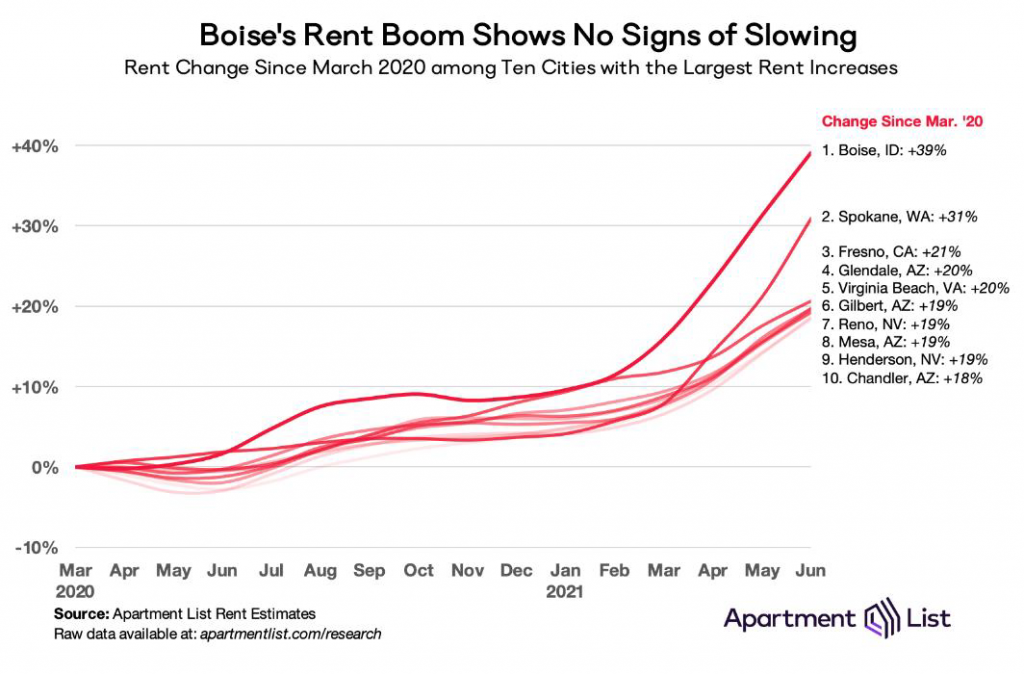
- While concerns about inflation remain widespread and the topic of countless news articles, the bond market is telling us such worries are overblown.
It is truly remarkable how the focus of reporters can change on a dime (or perhaps a quarter these days?). For years, I saw few articles that raised the specter of higher inflation, even as the Federal Reserve was printing money at record rates and asset prices continued to grow. And now? Nary a day goes by without one economist or another raising the prospect of systemically higher inflation.
It is really no wonder, as just last week the Labor Department reported that the Consumer Price Index rose 0.9% in June, the largest monthly increase since June 2008, and increased 5.4% over the last twelve months. Core inflation, which strips out volatile food and energy prices, rose 4.5%, the largest increase in that measure since September 1991. Everywhere one looks, whether it is your local Chevron, Home Depot, or Chipotle, higher prices are on the menu (the menus at Chevron and Home Depot might be worth avoiding).

And if companies are not increasing prices, they are accomplishing the same objective by shrinking the sizes of their products, something NPR creatively called “shrinkflation.” For example, Bounty may be the “quicker-picker-upper,” but it recently has been a “quicker-paper-shrinker,” reducing its package sizes by nearly ten percent.

And the market’s reaction to these higher inflation figures? Pretty much the same as the reaction I often get from students during one of my Zoom-based classes (and perhaps even the in-person ones), yawwwwn, if recent yields on ten-year Treasury yields – 1.17% at last glance – and other bonds are any indication. Keep in mind that ten-year Treasury yields were 1.75% at the end of the first quarter. Meanwhile, rates on high yield (read: junk bonds), averaging approximately 3.9% today, have fallen below inflation for the first time.
Plummeting bond yields are as strong as indicator as any that the market seems profoundly
unfazed by recent inflation data.
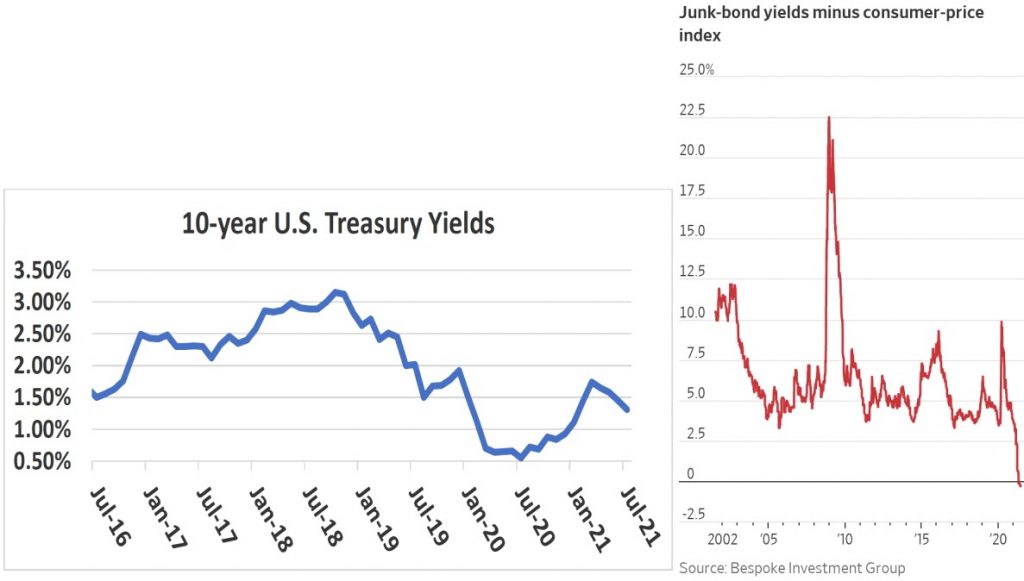
However, while headline inflation figures may have significant shock value, they become less
concerning when one realizes that more than a third of the inflation figures came from
increases in the prices of used cars. Yes, used cars. So long as Costco continues to charge
only $1.50 for a hot dog and drink, I maintain that inflation is not a longer-term systemic
problem. Rest assured, I will also be watching whether Costco’s hot dogs experience
“shrinkinflation” and will report back as needed.
Seriously, whether higher inflation is here to stay may be the most significant debate
between economists and market pundits these days. It is really an MMA battle between
competing forces. Supply chain disruptions caused by COVID will ease, as will pent-up
demand, both of which have created inflationary pressures. Meanwhile increased
investment in automation and unfavorable demographic changes (i.e., lower fertility rates,
later marriages) provide inflationary headwinds.
Perhaps one promising sign is the sharp reversal seen in lumber prices, which had risen to
record levels in May ($1,670.50 per 1,000 board feet on May 7th), only to drop more than
40% in June. You may recall that significant increases in virtually every commodity, from
oil to copper to aluminum to steel, had raised the cost of constructing a single-family home
by some 25% in a mere twelve months.

Obviously, Jerome Powell and the Fed are monitoring the data closely and they recently indicated that the discount rate may be raised earlier than expected, by late 2023. We will need to see how the Fed responds should higher inflation figures persist, and as usual, my popcorn is at the ready.
- While the employment picture continues to brighten, countless businesses are unable to fill open positions, adding to the uneven economic recovery.
Following questions about future inflation, the second greatest economic uncertainty involves jobs and wages. While employers added 850,000 jobs in June, the unemployment rate rose to 5.9%, from 5.8%, as more folks began to look for work (remember that people not looking for work are excluded from unemployment figures). Overall wages increased 3.6% in June.

One significant uncertainty is whether recent wage increases portend a longer-term trend, and my sense is that they do. McDonalds recently announced that all 36,500 of its personnel (in-facility) will receive raises averaging ten percent, that entry-level hires will see wages increase from $11 to $17 an hour, and average wages for all staff paid hourly will reach $15 by 2024. Olive Garden and Chipotle have also recently announced wage increases.
However, countless businesses remain unable to fill open positions, with some 2.4 million job openings available in both the leisure/hospitality and manufacturing sectors. Those of us who have returned to in-restaurant dining have likely experienced understaffed locations. I recently visited a local mountain resort, Big Bear, and several restaurants were clearly short waitstaff and bussers, with the lack of affordable housing in the area receiving most of the blame when I raised the subject. A recent WSJ article, “Factory Jobs Go Begging as Wages Fail to Keep Up” indicated that increases in pay for factory jobs has been so anemic that they cannot even compete with fast food operators. That will need to change.
Many blame unemployment benefits (including the $300 federal benefit supplement) as the culprit, pointing out that they act as a disincentive for workers to return to their jobs. For some, this is likely the case. However, the true causes for labor shortages are far more numerous and complicated, and include everything from those enhanced unemployment benefits, a lack of affordable housing, increases in remote work, fear of (re)infection, a shortage of available childcare, and the pandemic-compelled exodus from urban cores to the burbs. Some workers may have used the pandemic to pursue other alternatives, everything from real estate brokerage to trading meme stocks and cryptocurrencies.
However, the reality is that real wages have stagnated in recent decades and have simply not kept up with increases in corporate profits or housing costs, even as labor markets tightened. As a share of GDP, worker compensation is lower than at any point in the second half of the 20th century, resulting from corporate consolidation, shrinking labor unions, automation, and Amazon. One data point that caught my eye and highlights the issue is that the average S&P 500 company CEO made 299 times the average worker’s salary in 2020, according to AFL-CIO’s annual, “Executive Paywatch report.” Executives received $15.5 million in total compensation on average, representing an increase of more than $260,000 per year over the past decade. At the same time, the average production and non-supervisory worker in 2020 earned $43,512, up just $957 a year over the same time period.

However, I believe these trends are going to change, and must change, to paraphrase Bob Dylan. First, just like the pandemic disrupted supply chains generally, labor supply was similarly impacted. However, challenges in labor supply may not be quite as easy to fix without significant additional incentives provided to workers. Second, thanks to the extraordinary rise in asset prices, including homes, some older workers are likely to retire sooner, perhaps also taking advantage of low rates to secure one of those reverse mortgages peddled by Tom Selleck. Third, lockdowns may have impaired some workers’ ability to return to their jobs due to health issues or a lack of childcare. And finally, while unemployment benefits will eventually burn off, they will create additional employment headwinds. Collectively, these factors suggest less labor force slack than is usual at this stage of a recovery, and higher wages are in our future.
Finally, wages need to increase to allow workers to afford housing in the communities in which they work. Several years ago, I was having dinner with two friends up in Seattle, and I asked them where they thought the busboy lived. They had no idea. I responded that we need to understand the answer to that question if we are not going to experience labor disruptions in service businesses located in tight housing markets. The math is simple, as reflected in the map below, that wages far above the minimum wage are required for workers to afford the rent in most communities.

- The pandemic materially accelerated the domestic diaspora, a population exodus from the coasts to less expensive locales.
Over the past several years, I have written extensively about the population exodus from the coasts further inland, a sort of Manifest Destiny in reverse, as people sought more affordable housing, lower taxes, and perhaps places with less red tape and bureaucracy. However, one significant driver of this domestic diaspora that I have not discussed is how the Southwest has emerged as the country’s new factory hub.
Five states – Arizona, New Mexico, Texas, Oklahoma, and Nevada – added more than 100,000 manufacturing jobs from the start of 2017 to beginning of 2020, representing 30% of US. employment growth in the sector. As Silicon Valley’s influence becomes more widespread and fragmented, markets like Phoenix, Denver, Austin, Henderson/Las Vegas, and other cities should see increased tech-based jobs, and along with those high-paying jobs, greater demand for housing.
For example, Taiwan Semiconductor Manufacturing Corporation, the world’s largest contract chip manufacturer, whose products are in significant demand, selected Arizona as the site for a new $12 billion factory, which will employ some 1,600 workers. Intel is already active in that market and is expanding there. From Tesla to Lucid Motors to Steel Dynamics, numerous firms are expanding from traditional manufacturing hubs and coastal markets to places like Nevada, Arizona, and Texas. COVID and the supply chain disruptions it brought have only accentuated the trend.
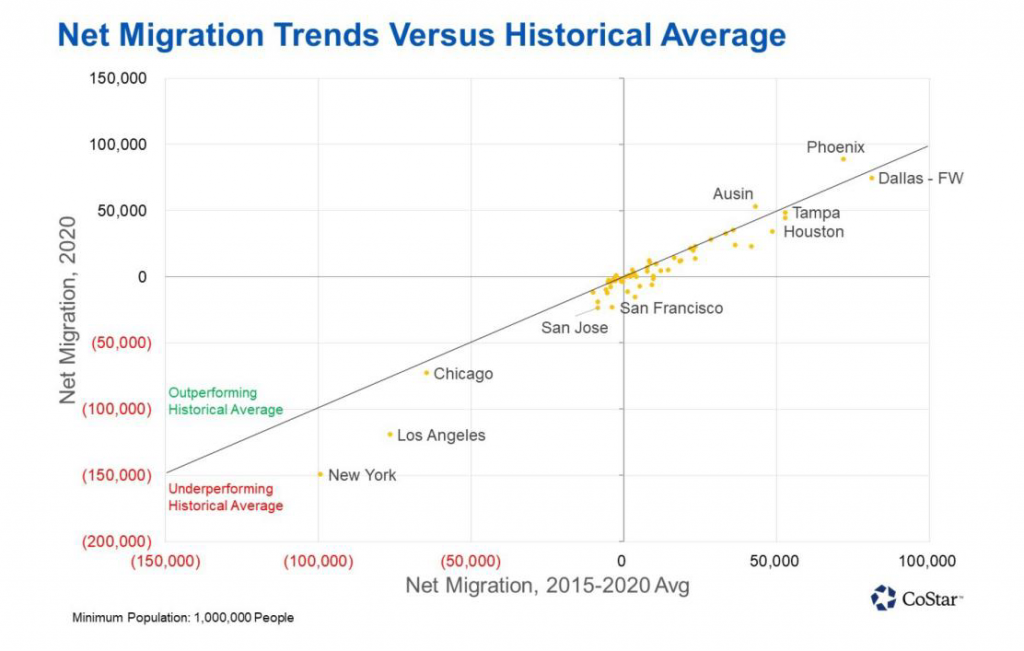
- Governments at all levels – local, state, and federal – continue to wrestle with how to minimize evictions of tenants delinquent on rents and homeowners behind on mortgage payments.
One significant uncertainty and concern of politicians (and others) is what will happen to tenants behind on their rent or homeowners delinquent on their mortgages when various moratoriums and/or forbearance agreements burn off later this year. During the last week of June, the Biden Administration announced a one-month extension of the CDC eviction moratorium, which was set to expire, and that the government will expedite the distribution of the $46 billion in emergency rental assistance established by Congress as part of the last stimulus bill. They also indicated there would be no further extensions, though whether they follow through on such an assurance remains to be seen. George Bush taught me long ago not to trust everything politicians say, even when you read their lips.
Meanwhile, California extended its eviction moratorium through September and has proposed paying landlords all missed rent for low-income individuals and families, a proposal that would cost a mere $5.2 billion. We hope California follows through on this proposal given how much we have at stake given the delinquencies we have experienced across our California-based assets. New York has extended its moratorium until the end of August. Most other states have let their eviction moratoriums lapse but are offering other rental assistance programs.
We continue to work with tenants when possible and have received payments for delinquent rents from various programs, but it is a slog as governments have not been exactly speedy (shocking, I know) in processing claims.
- As usual, before I wrap up this edition of our quarterly update, there are a few other noteworthy data points to consider.
- Biden Tax Proposals and 1031s: I am often asked whether 1031 transactions are going to go bye-bye if Congress decides to close an invaluable loophole that has been available to commercial real estate investors for nearly fifty years. If Biden has his way, 1031s would be eliminated or be significantly curtailed, closed to investors with pre-tax real estate profits over $500K. But political realities being what they are, I do not believe any meaningful tax reform is forthcoming. Heck, bipartisanship cannot even be found to pass an infrastructure bill.
- Office Space Outlook: Last week, as I was driving past downtown Los Angeles, I noticed three large cranes putting what appear to be the finishing touches on three separate high-rise office buildings. I imagine all three are going to suffer significant losses, as they struggle to find tenants in a post-COVID world. Office vacancy rates have increased sharply since last spring, and I cannot foresee any forthcoming respite. It will be interested to see if some office projects are converted to alternative uses, but I imagine that will be no easy task, and certainly not an inexpensive one. Obviously, the outlook has improved in recent months, but I still foresee a very challenging office market looking forward.

- IPOS, Corporate Debt, and Rising Zombies: Since the end of Great Recession, corporations have added trillions of dollars in debt, much of which is investment grade or lower. Globally, corporations owe over $80 trillion, nearly a quarter more than they did in 2008, with one long-lasting legacy from the pandemic being the sharp increase in corporate debt. Non-financial firms issued a record $1.7 trillion in bonds in the U.S. last year, some 30% higher than the previous record. By end of the first quarter of 2021, total debt for such firms reached $11.2 trillion, with some of the biggest borrowers being those hit hardest by the pandemic: Carnival Cruise Lines, Boeing, and Delta. Low rates are hard to resist, and while corporate bankruptcies have been few and far between as a result of government largesse and the willingness of investors to fund “zombie” companies, I don’t see this trend being sustainable.

- Governmental efforts to increase fertility rates: One concerning trend I have mentioned many times in recent years has been the decline in fertility rates because of its longer-term impact on the economy and housing. At end of April, the Census Bureau reported that decade ended 2020, U.S. population grew at slowest rate since the Great Depression and second-slowest rate in any decade since our country was founded. However, declining fertility rates are a global phenomenon and governments are doing their part to stimulate reproduction rates (insert joke here). I recently read that China is now “allowing” families to have three children and two weeks later, I saw another article that said that China is poised to “lift all childbirth controls.” China clearly recognizes that policies limiting family sizes might have significant demographic and economic impacts looking forward. However, without associated economic incentives, I cannot see how such a policy will have any meaningful impact. After all, having children costs a lot, and is not getting any less so. Closer to home, the American Rescue Plan passed earlier this year increased the child tax credit to $3,600 for each child under 6 and to $3,000 for each child up to age seventeen. The Biden Administration has also proposed the expansion of paid-leave programs and improved childcare access. Regardless, I do not see any of these policies having any meaningful impact.
Overall, as the length of this update indicates, the second quarter had plenty of data to consider and evaluate, and while the outlook for housing – both single- and multifamily – is very positive, significant uncertainty surrounding everything from inflation, employment, and COVID variants remain.
Between the U.S. Department of Defense confirming that certain sightings by naval pilots were, in fact, UFOs, Richard Branson rocketing off to the edge of space, and an unidentified individual bidding $28 million to accompany fellow billionaire astronaut wannabe Jeff Bezos’ on a similar journey, the second quarter truly included news that was other-worldly. Oh, and by the way, the winning bidder for the Bezos space flight ultimately decided not to go, forfeiting the $28 million they paid for the ticket. If anyone happens to know their identity, would you be kind enough to pass along the name to our Investor Relations personnel?
Here, back on earth, there are many areas of concern, but perhaps ironically, nearly all provide foundational support and tailwinds for housing prices and rents. That is not to say that there are not areas of concern: elevated asset prices, continued speculation in meme stocks, cryptocurrencies, and SPACS (Special Purpose Acquisition Companies), high levels of corporate debt, the bloated Federal Reserve balance sheet, and the specter of higher inflation are all areas of concern, and I will be paying close attention to all of these issues, like many investors.
Meanwhile, the confluence of record-high values in single-family homes, equities, and virtually all commodities, coupled with record-low interest rates and tremendous liquidity has compelled investors to assume greater risk in the search for higher yields and returns. A recent WSJ article focused on how certain real estate investors, including Blackstone, are placing greater and greater sums into niches like data and research centers and life science labs.

While such a shift by Blackstone and others may prove prescient, I am always mindful of when investors – whether retail or institutional – shift strategies and move further along the risk curve. My experience is this tends to occur towards the end of cycles. Rest assured that Clear Capital will resist the temptation to move away from our core strategy that has proved well over decades and shifting market cycles.
Finally, I wanted to express my sincere appreciation and thanks to you, our investors and supporters, as well as the entire Clear Capital and Clarion Management (our captive management company) teams for their extraordinary efforts over a challenging period. I am beyond grateful and feel very fortunate to work alongside such a talented and dedicated group of individuals.
Best,

Eric Sussman
“What a Long Strange Trip It’s Been”
– Grateful Dead“It is often said that there are two types of forecasts…lucky or wrong”
– Anonymous
During this past quarter, there were more than a handful of times that I read a particular headline and did a double take, just to make sure that I was actually reading the Wall Street Journal, Bloomberg, or other article from the mainstream news and not the Onion or similarly satirical news source.
In March, the Los Angeles Times had an article captioned: “Hottest Housing Market? It’s Fresno.” With no disrespect to Fresno, located in Central California’s San Joaquin Valley, the words “hot,” “housing market,” and “Fresno” do not usually appear in the same sentence. Yet, Fresno is just that when it comes to real estate prices and rents. Hot. The median rent in Fresno was up 12% during the last year, one of the top markets in the nation, and a modest single-family home that recently went up for sale there received over 100 offers, many offering all cash. In fact, Fresno, and cities like it throughout the Southwest, Sunbelt, and Mountain West – from Fresno to Boise to Gilbert (Arizona) to Riverside (California) – have been some of the strongest the past year, all benefitting from the pandemic, low interest rates, and more modest housing costs.
Then there was this doozy from CNBC in early April: “Paris Hilton is Fascinated by NFTs and Very, Very Excited About Bitcoin.” I have previously joked that when your Uber driver, barber, or gardener shares an investment idea with you, we just might be at a market top. However, I am sure Paris Hilton’s interest in Non-Fungible Tokens (digital art) and cryptocurrency is different, a uniquely bullish sign. #sarcasm. Then again, a digital collage – a Non-fungible Token – sold for a record, $69 million during the quarter, so perhaps Ms. Hilton is really onto something.
And then there was this classic from Bloomberg, which appeared a couple of days ago, “Everyone Loves the $100 Million Deli, Except David Einhorn,” about a rural New Jersey deli, which went public (symbol, “HWIN”) and, despite less than $14,000 in 2020 revenues, sports a market capitalization of over $100 million (actually $102 million at last glance, and if you include its outstanding warrants, over $1 billion), capturing the attention and cynicism of Mr. Einhorn, a well-known value investor and fund manager. Clearly, his value focus fails to appreciate the growth opportunities and potential in pastrami and corned beef. Imagine if this deli accepted Dogecoins or Bitcoins, or was acquired by a SPAC (Special Purpose Acquisition Company), its current valuation would seem like child’s play.
In fact, I think I could probably spare the time it usually takes you to read my less than pithy quarterly updates by simply providing you with a bunch of other headlines from the last few months, which really articulate the state of the real estate market, at least when it comes to single-family homes:
- “A $400,000 House Got 122 Offers in Two Days,” Wall Street Journal
- “Home Prices in Southland Rise 14.5% Amid Feeding Frenzy,” Los Angeles Times
- “Home-price Surge Hits 15-year High,” The Real Deal
- “More Real Estate Agents Than Homes for Sale,” Wall Street Journal
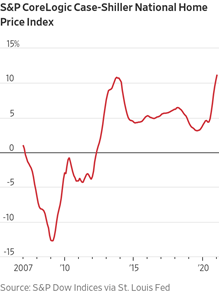
Meantime, multifamily real estate brokers echo similar sentiments when discussing the apartment market. One Georgia-based broker told us that they had received 25 “serious” offers on one project and the “winner” was a group out of the Pacific Northwest, which outbid all competing offers by some $2 million, surprising even the brokers themselves.
In Arizona, deals are trading anywhere from five to 15 percent above asking price. Brokers are consistently receiving at least 30 offers on projects, with over 10 invited to the “best and final” stage. Such offers routinely include large (e.g., “7-digit”), non-refundable deposits. I recently visited Phoenix and virtually every apartment project I visited had no vacancies whatsoever. If the two-hour wait time to rent a car from Thrifty Car Rental is an indication, Phoenix’s attractiveness as an investment destination will persist for some time.
The story is the same elsewhere, from Idaho, to Utah, to Colorado, to Texas, to North Carolina. These anecdotes reflect why we are so interested in acquiring assets in these markets, but at the same time we must be especially thoughtful and conservative in our underwriting and negotiations. It is really not surprising that we routinely find ourselves left at the altar and unsuccessful in those “best and finals.” For every project in which we successfully reach the finish line, there are countless other times in which we are simply outbid.
Then again, to show how unique individual markets are, anyone who acquired residential rental property in New York City in the last 10 years is probably under water, likely having lost anywhere from 40 to 50% of their equity because of sharp declines in rental rates and increases in vacancy rates over just the past 12 months. I can almost hear the lyrics to that Eagles’ song from many moons ago: “In a New York minute, everything can change. In a New York minute, things can get pretty strange.”
While perhaps a bit of an “eyechart,” I found the following to be very informative, summarizing rent and vacancy statistics and changes across many cities in the U.S. between January and November of 2020, consistent with the perspective I just expressed:
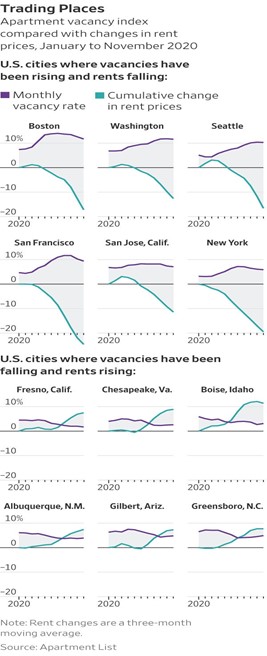
Overall, the apartment market has stabilized in the past few months, but delinquencies remain stubbornly high. While applications, move-ins, and lease renewals are rising, nearly six percent of residents across the U.S. have rent balances outstanding in excess of one month, and on average, such residents are behind some 3.5 months on their rent. Nearly two percent of apartment residents are five or more months behind in their rent. Across the Clear Capital portfolio, we are experiencing similar results, though not surprisingly delinquencies vary across projects and locations. The following summarizes overall collections across the country, according to the National Multifamily Housing Council:
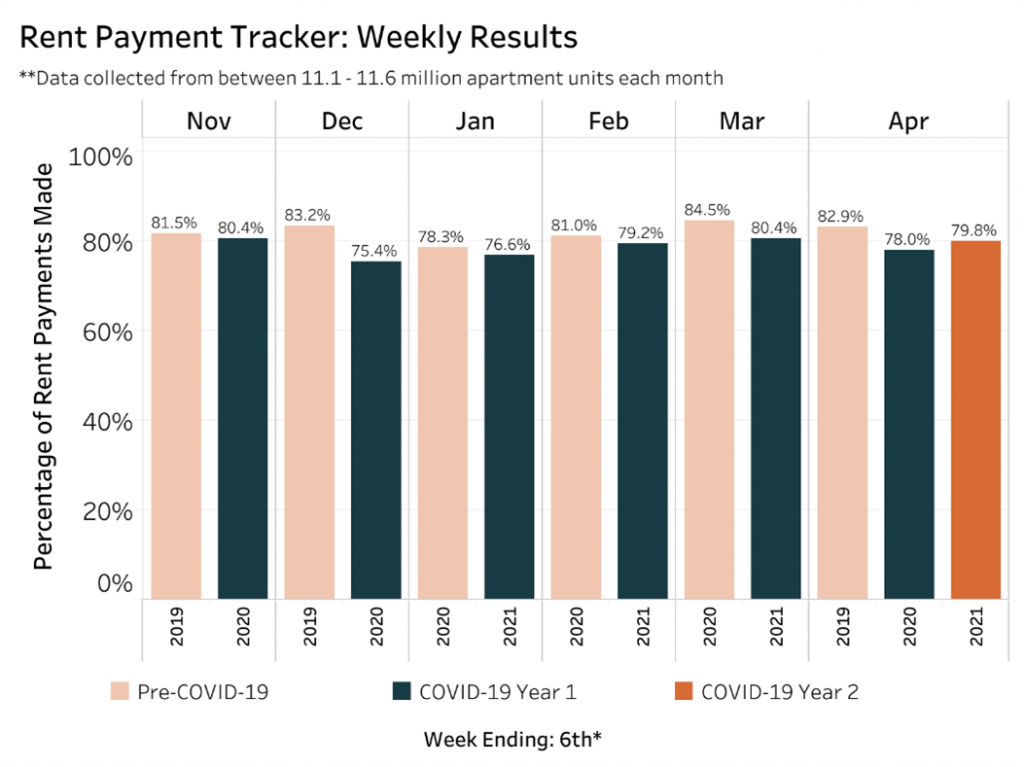
In any event, I have not seen any market quite like this, which shares distinct similarities to 1998 to 1999 and 2005 to 2007, when certain asset prices seemed profoundly disconnected from underlying fundamentals. How else can one justify the values of Dogecoin (a cryptocurrency competing with Bitcoin), GameStop, many SPACs, or that now world-famous New Jersey deli, among numerous other examples?
However, with a post-COVID economic recovery under way, historic levels of government stimulus (including the $1.9 trillion COVID relief plan passed this quarter), 10-year Treasury yields below 1.60%, record-levels of liquidity, and bank balance sheets in seemingly decent shape (a total of about 20 banks have failed in the last five years versus over 300 between 2010 and 2013), this time feels quite different from those two other auspicious timeframes, and I am more concerned about inflation than I am about a broad market downturn, as I have written about previously. In fact, consumer prices rose sharply in March, up 2.6%, which hardly sounds alarming, though it represents the largest increase since August 2018, so stay tuned.
In summary, the first quarter was extremely eventful, with some very wild market moves, even capturing the attention of investment stalwarts like Paris Hilton. Residential real estate prices increased sharply, which may be one of the most significant stories of the quarter, whose impact will reverberate for some time to come. Oh, and did I forget to mention that UCLA’s men’s basketball team made it to the Final Four in the NCAA Tournament, before losing at the buzzer on a 45-foot bank shot? In overtime? As a double-digit underdog? Or the Capitol riot of January 6th and the inauguration of President Biden?
Indeed, it was that kind of quarter.
Secondary and Tertiary Markets, Especially Those in the Southwest, Sunbelt, and Mountain West, Continue to Lead
Continuing a trend which has persisted for some time, the hottest real estate markets include markets like those mentioned above: Boise, Fresno, Greensboro, Gilbert, Riverside, Albuquerque, Tucson, and Memphis, where rents have increased anywhere from nine to 12% over the past year. Across the entire country, in the 134 markets in which data is available, rents were up very modestly in the past year, some 0.6%, and 0.8% during the quarter. Of course, these higher rents are not completely uncorrelated to both resident delinquencies and the inability to evict such residents, which artificially reduced available supply.

However, the demographic diaspora from the Coasts to less expensive and more suburban markets has been impactful. According to Zillow, some 10% of Americans relocated during the pandemic, with Phoenix, Charlotte, and Austin leading the top destinations. As one Austin homeowner put it, “They just keep coming. The fleece vests, the tech bros. That’s definitely imported from California.” Austin has been the fastest growing city in the last decade, growing 30%, with half of the growth representing Texans relocating from other parts of the State to Austin.
Home prices increased in all of the 100 largest metros in the U.S., according to Zillow. However, in some of the wealthiest, tightest residential markets – San Jose, Seattle, NY, Boston, Austin, SF, DC, LA, Chicago – rents declined, in some cases by more than 10%. The dichotomy is noteworthy, where home prices have increased while rents declined, both by double-digits. I am not sure this has ever occurred, certainly not in my memory.
Perhaps another anecdote may be illustrative, this time involving a close friend, who relocated from West Los Angeles to Lexington, South Carolina, a quiet suburban neighborhood about 15 miles outside Columbia, the state capital. As a personal trainer, the pandemic forced him to provide services remotely, and with products like Peloton and other products (e.g., the “Mirror” from Lululemon) providing in-home, yet interactive, workouts, it is clear that personal trainers and the like can live virtually anywhere and still engage with clients. Not only are all gyms at great risk (that may be an understatement), but suburban housing markets have found a new source of demand. COVID has made it clear that certain jobs can be performed almost entirely via FaceTime or Zoom. His brother, a local realtor, is receiving dozens of offers on every home he lists, and on one transaction, he received a most unusual proposal, which offered to pay “$1,000 above any other offer received,” all cash, with a quick close. Again, I had never heard of an offer quite like that one, and this is for a single-family home in Lexington, South Carolina, population of less than 23,000.
A recent article in the Wall Street Journal noted that some suburban homebuyers are actually foreign investors, stating that “blocks of families are sending monthly rent checks to ventures backed by Canadian pension funds, European insurers, and Asian or Middle Eastern government-run funds.” Supposedly up to a third of institutional investors in single-family residential properties are foreign. In fact, just last week, the German insurer, Allianz SE, said that it is investing $4 billion in U.S. rental homes, as if prospective homebuyers need additional competition.
In short, I anticipate continued growth in the same markets that have been leaders in recent years, those secondary, tertiary, and even quaternary locations (yep, including red-hot Fresno), with the biggest unanswered question whether supply can keep up with demand. As discussed in more detail below, my sense is that it will be a challenge (read: perhaps impossible) to do so in many of these markets.
With Substantially Higher Commodity and Construction Costs, Widespread NIMBYISM (Not in My Backyard), Poorly Construed Public Policies, and Broadly Insufficient Supply, Housing Prices – Both Single- and Multifamily – Are Not Likely to Moderate Anytime Soon Even if Demand Moderates
In a recent memo and/or podcast episode I recorded (“Focus on Facts, available at Spotify and Apple Podcasts, admittedly some shameless self-promotion), or perhaps both, I indicated that those hoping for lower home prices would be “waiting for Godot” because of the severe imbalance between demand and supply in nearly every market. According to Freddie Mac, the U.S. housing market is nearly four million homes short of what is needed to meet demand, a 52% rise from 2018, when they first began to estimate and quantify the shortfall.
Historically low rates, unprecedented liquidity, COVID and related stimulus, institutional and foreign purchasers, record number of Millennials (30 to 39-year-olds) in search of permanent housing and perhaps experiencing FOMO (Fear of Missing Out) are driving unprecedented demand for homes. Imagine that on nearly every successful transaction, there are anywhere from ten to 150 bridesmaids or groomsmen, unsuccessful bidders who will likely be bidding on the next home available for sale. With personal savings having accumulated over the past year of COVID, significant dry powder awaits both increased consumer spending and investment.
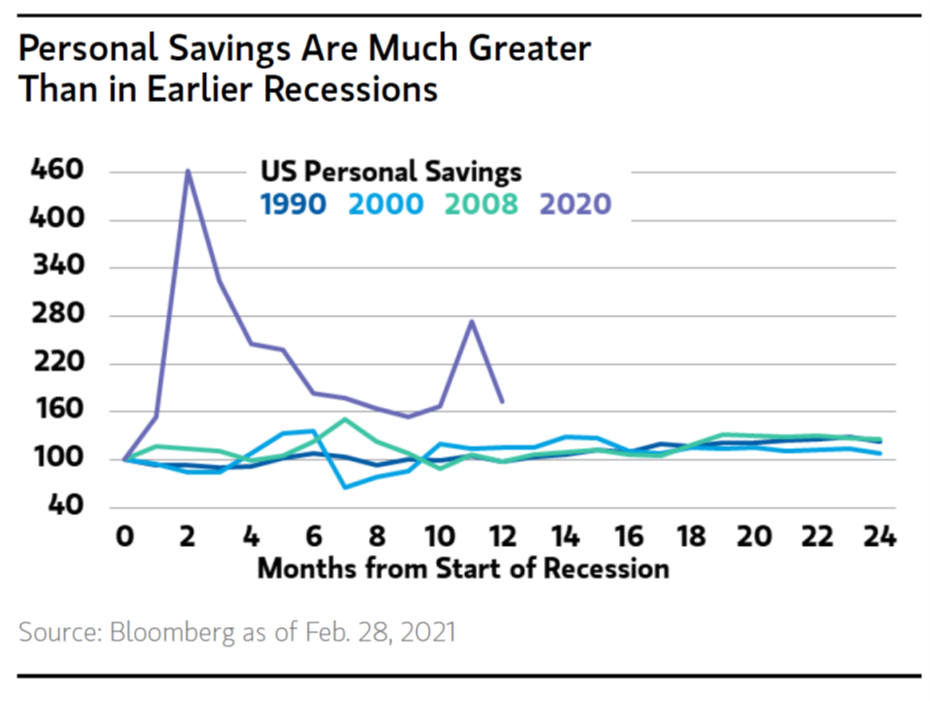
Meanwhile, the supply of homes for sale remains at record lows. For example, there were about 1.3 million homes available for sale at the end of 2020, representing about 2.3 months of supply, down 22% from the prior year. Perhaps my very favorite (if not sobering) statistic revealed this quarter, in late March, was that real estate agents outnumber homes for sale nationwide. At the end of January, one month later, some 1.04 million homes were available for sale, down 26% from the prior year and the lowest on record since 1982, while there are 1.45 million licensed real estate agents nationwide, up nearly five percent from the prior year.
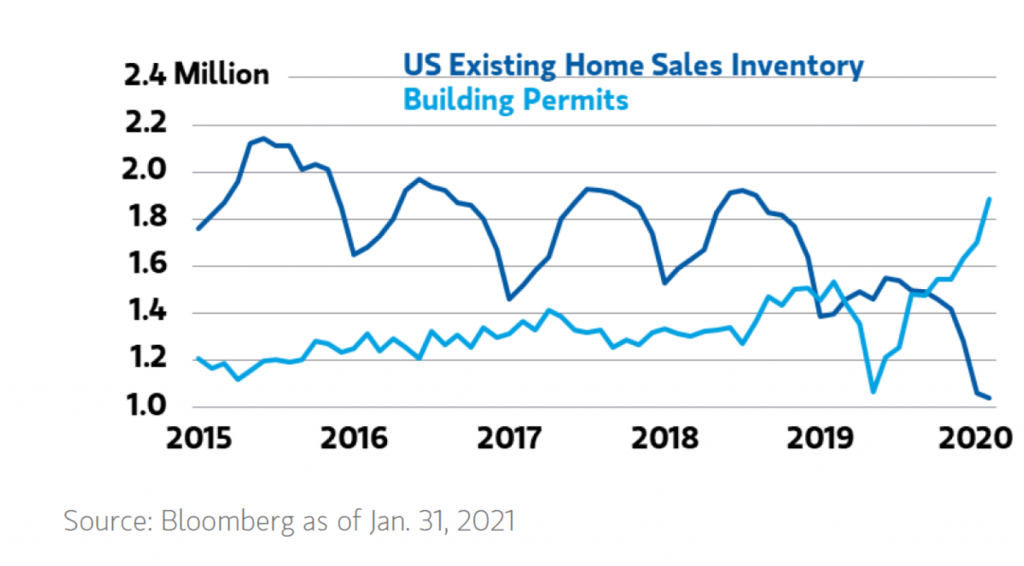
While countless renters have relocated during the pandemic, homeowners are mostly staying put, especially Baby Boomers with their $10 trillion of equity, impacted by COVID and unfavorable tax policy (capital gains). According to Redfin, the typical homeowner in 2020 had remained in their homes an average of 13 years, up slightly from 12.8 years in 2019, but far longer than in 2010, when homeowners had lived in their homes an average of 8.7 years.
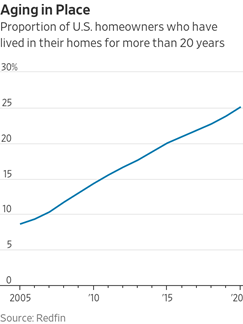
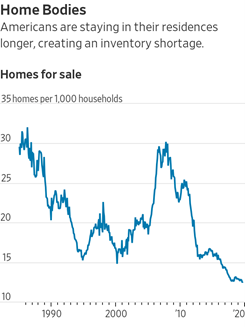
While not concerned about increased debt levels in the short-run, as mentioned, I do fear the higher inflation and asset values they will likely fuel in the intermediate to longer-term. I don’t think for a second that the Fed’s “easy” monetary policies and elevated equity values are unrelated. However, at this point, the markets are not forecasting significantly higher inflation. It may just be that inflation in financial assets (including real estate) will be offset by broader deflation in everything from energy to consumer goods to office and retail rents.
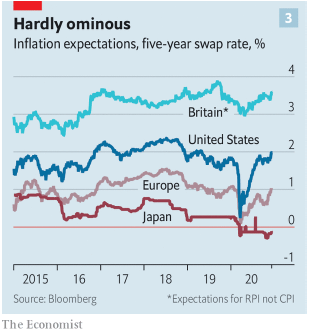
A recent Los Angeles Times article highlighted the challenges, perhaps particular to California, noting that not a single of the more than half dozen bills introduced last year to address the state’s housing crisis was passed, in large part “because of campaigns waged against them by the state’s powerful construction-workers union.” Union opposition is one of the principal reasons politicians have been unable to pass legislation streamlining and accelerating construction approvals and easing zoning restrictions. The irony is not lost on me. The sorts of individuals who would probably benefit significantly from lower rents and housing prices – blue-collar individuals who work in the construction trades – stymy new construction and exacerbate the problem. Is it any wonder that it costs as much as $700K to construct an “affordable” unit, perhaps double what it costs to build a comparable market-rate unit?
Meanwhile, local opposition to building is so commonplace and the approval process so cumbersome, time consuming, and expensive, even when a proposed project complies entirely with requirements, approvals are not forthcoming, at least in an expeditious manner and needed supply is simply not provided. Recently I heard of a new acronym to add to my vocabulary: CAVE, Citizens Against Virtually Everything, to be added to NIMBYISM and BANANA (Build Absolutely Nothing Anywhere Near Anyone).
Finally, commodity prices continue to climb, or “go through the roof,” as it were. Crude oil, the key component of everything from paint to drain pipes to roof shingles to flooring, has increased 80%, yes 80%, since October. Copper, used extensively in both plumbing and electrical work, costs roughly a third more now than it did a mere six months ago. Prices for everything from insulation, granite, concrete, and brick reached record levels this year, according to the Bureau of Labor and Statistics. Drywall and ceramic tile prices have also increased, while significantly higher lumber prices have added something like $24,000 to the cost of an average home and $9,000 to an average apartment. Ouch. According to PulteGroup, Inc., one of the largest homebuilders, the average cost to construct a home in the fourth quarter alone was up 7%. American Homes 4 Rent, which constructed some 1,600 units last year and plans to build another 2,000 in 2021, said it spends between $20-25,000 per unit for lumber, more than double what it spent last year.

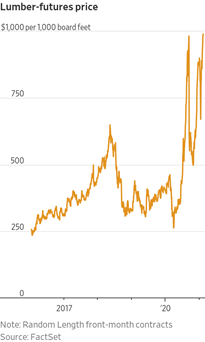
Lest you think this is merely a U.S. phenomenon, it is not. In the 37 countries in the OECD (Organization for Economic Cooperation and Development), home prices hit a record last year, up five percent, the most in nearly 20 years. From Bicester in the U.K. to Omaha, Nebraska, to Berlin, home prices are rising, up 11% year-over-year here in the U.S., 8% in the U.K., and 9% in Germany.
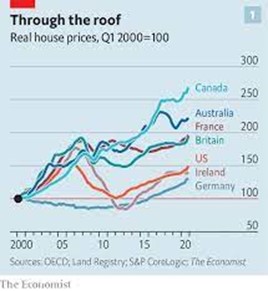
While Treasury and Mortgage Rates Rose During the Quarter, They Remain Low by Historical Standards. However, Higher Inflation Remains a Real Risk
During the first quarter, interest rates increased, and not insignificantly, at least in relative terms. At the start of 2021, the yield on ten-year U.S. Treasuries was 0.93%, and at last glance, 1.56%, while average 30-year mortgage rates had increased from about 2.7% to nearly 3.1% today. However, the increase has negligibly impacted demand, best I can discern.
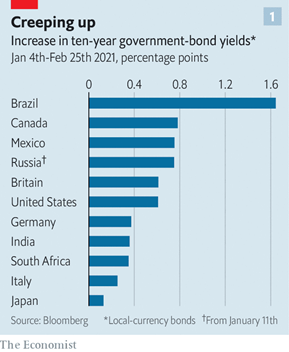
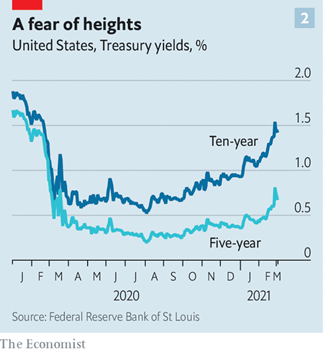
One big question mark is how long the Federal Reserve can wait before it decides to raise rates. According to Morgan Stanley, recent data implies a rate hike in 20 months or so, which essentially comports with Fed Chair Jerome Powell’s public statements.
Clearly some increase in inflation was inevitable given the collapse in consumer spending and demand following the COVID outbreak, but March’s increase in inflation to 2.6%, up from February’s 1.7%, represents the most significant rise since 2009. Inflation will soon surpass the Fed’s two percent target (it uses a different index), but the Fed will truly be engaging in a tricky balancing act worthy of Cirque d’Soleil.
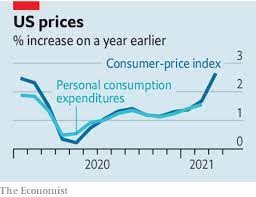
Economic recoveries produce price pressures and the impetus for higher interest rates and the post-COVID recovery will certainly be no different. On the other hand, higher interest rates can and will dampen economic demand for capital investment and other goods and services, and could threaten any economic recovery, so the Fed will be trying to walk a fairly narrow tightrope between now and the next 12 months.
Even in Quarantine, Elected Officials Have Been Busy
One of the things that will be fascinating to watch, and track is how governments at every level and across the globe continue to intervene in housing markets, as they try and protect renters from eviction, homeowners from foreclosure, all while trying to increase the stock of affordable housing and address ever increasing homelessness. However, their efforts seemed doomed, at least in the longer-term, as they lack the political will and financial resources to do so.
Meantime, the CDC has extended its eviction freeze through June 30 and state and local governments will be moving aggressively to shore up their fiscal deficits, resulting from significant declines in tax revenues because of the pandemic. Nashville instituted a 35% surcharge on property taxes last year, and Lord knows how New York City plans on dealing with its $9-10 billion projected budget deficit. Knowing politicians, they will likely choose some profoundly suboptimal policies, but those that are palatable to constituents. Let me go out on a proverbial limb to predict that higher local and state taxes are likely coming down the pike.
As moratoriums surrounding the eviction of residents and foreclosure of homeowners behind in their mortgage payments expire, we will have to see how landlords, lenders, and the Courts respond. I imagine many landlords and lenders will work with residents and homeowners to minimize losses and manage vacancy rates, while working aggressively to collect delinquent rents and mortgages. On March 11th, the latest COVID relief bill, the “American Rescue Plan Act” was passed into law, a $1.9 trillion relief package that includes $50 billion in housing resources, including some $27 billion for rental assistance. Combined with $25 billion in rental assistance provided by Congress last year, over $50 billion is available to assist struggling renters and landlords who have also been impacted, including Clear Capital. How quickly these funds will be distributed by individual states remains to be seen, and Clear Capital, like nearly every landlord, are understandably eager to collect as much of the nearly $2.5 million in delinquent rents we have experienced across our entire portfolio as we can.
Meanwhile, across the Pond, you may recall that Germany passed a five-year freeze on residential rents back in 2019 that prevented owners of any property built before 2014 from raising rents, the most onerous rent control regulation I have ever seen. And the preliminary results are in. According to German Institute for Economic Research, rents for units built before 2014 are in fact down 11% as compared with those that are not regulated, but, as any economic analysis would have predicted, the Country’s housing shortage has worsened. The number of units available for rent has declined by more than 50%, as tenants are hanging on to their rent-regulated units with both hands, while in other cases, landlords are using units for themselves, selling them, or keeping them vacant in hopes that the Courts determine the law is unconstitutional. All these outcomes were entirely predictable to anyone with even the most basic training in fundamental economics.
Finally, and as usual, a few other noteworthy tidbits have caught my eye during the quarter
As usual, I would be remiss if I neglected to mention a couple other tidbits or relevant data points that might be of interest.
- Significant Office Vacancies are Likely to Persist for an Extended Period of Time: Not surprisingly, office vacancies are piling up and in historic fashion, and I believe the slump will be long-lasting. From Houston to San Francisco to Los Angeles to Manhattan to Chicago to D.C., things are particularly ugly. In the ten largest metros, office occupancy is only 26% of pre-pandemic levels, according to Kastle Systems, whose electronic access systems are found in thousands of office buildings throughout the U.S.
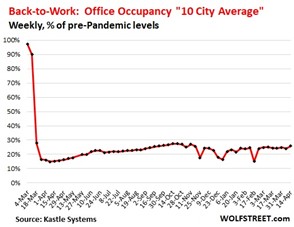
- While hotels focused on leisure have already seen a modest recovery, convention-reliant hotels are in a world of hurt and won’t bounce back for some time: For the first time in nine months, I traveled recently, to Phoenix, as I mentioned earlier, to visit a new project we are acquiring, Urban Park, and an asset we acquired a couple of years ago, Aspire Glendale. Both LAX and Sky Harbor, Phoenix’s airport, were fairly busy, at least the Southwest terminals. The flights were entirely, or nearly entirely, full. Activity at the rental car counters was what I would have expected to see before COVID, and in fact, busier.
According to recent data from the Bureau of Labor and Statistics, the leisure and hospitality industry led last month’s job gains, adding 280,000 jobs in March, following the addition of 355,000 jobs in February. A recent poll indicated that some 87% of households plan to travel in the next six months, up from 60% just a couple of months ago. Obviously COVID hit the travel and tourism industry with a stiff uppercut, but the industry is in recovery mode and pent-up demand, significant. Full recovery is still a couple of years away, I would think, especially in international travel. And leisure hotels will fare far better and recover far more quickly than those that rely more heavily on conventions and conferences.
A couple of specific data points may be probative. Hilton had reopened 97% of its hotels as of February 10th. Of the 989 licensed casinos in the U.S., 935 have now reopened. However, it should also be noted that Nevada is limiting occupancy at reopened hotels to 35% occupancy until June 1st, when the State intends to completely reopen. In California, rules vary by county, but the State intends to reopen on June 15th. We shall have to wait and see, but fingers and toes are crossed. I can tell you that Clear Capital intends on holding its annual staff meeting in-person this year, in October, if all goes to plan.
In any case, I don’t foresee substantial foreclosures in the hotel/hospitality space, as lenders don’t want to take back these assets and have learned their lessons from prior downturns. It is usually best to work with borrowers to maximize recoveries and outcomes.
- The Retail Industry is the One that May Never Recover, at Least in Some Segments: It is a secret to absolutely no one that retail faced significant challenges and headwinds before COVID, and I have routinely, if reluctantly, provided data on store closures and retail bankruptcies in nearly every quarterly memo. 2020 saw a record of permanent retail closures, with over 12,000 stores closing their doors.
So what’s the post-COVID retail reality look like? That remains a big question mark, as I can’t imagine how large indoor malls, anchored not just by “big boxes,” but movie theatres will fare. We have all gotten used to watching everything, including first-release films, from the comfort of our couches. Between higher-quality, large screen, smart TVs, surround sound, and decent homemade popcorn, we are more willing to enjoy movie fare at home. I just don’t see movie theatres being able to remain open for some time. I recently read that Los Angeles-based Pacific Theatres, parent company of ArcLight, announced that the company has decided not to reopen any of its theatres. And larger chains like AMC, and the malls in which they operate? I think they face profound headwinds, and sadly, I anticipate that I will be reporting additional sobering statistics on retail assets looking forward.
While the Next Six Months Will Bring a Much Stronger Economy, the Recovery will be Uneven, with Anticipated Fits and Starts. Residential Real Estate Will Continue to Fare Well, but Cautious and Conservative Underwriting Must Accompany Any Acquisitions
The last 13 months seem almost surreal, and somehow, I could not have said it any better than Jerry Garcia and the Grateful Dead, “What a Long Strange Trip it’s Been,” even though the trip is not quite over. However, we are certainly over the hump, though there will be fits and starts, and perhaps a spike here or spike there, a variant there, and variant here. That is not to make light of any sort of possible resurgence, and I am sure the media will do its part to engage (read: scare) us during this period of time. But the reality is that the next six months will bring significant increases in economic activity, travel, and employment, terribly uneven as they might prove.
Meanwhile, residential real estate, both single- and multi-family assets, will continue to perform very well, as delinquent rents are recovered, evictions resume, the job market recovers, and a slew of 20-35 year olds vacate their parents’ basements or old bedrooms, and enter the rental market. The demand-supply imbalances I discussed above and in previous missives will persist for the foreseeable future, and the private sector can only do so much to address a widespread public policy challenge.
Finally, you may have already received information about our latest offering, a 104-unit project in Phoenix, Urban Park Apartments, which offers compelling cash flows and upside as we increase rents to market and execute our value-add strategy to the Project. I hope you might join us in the opportunity. Meantime, we anticipate other offerings in short order, as we scour the Southwest, Sunbelt, and Mountain West regions for opportunities. Stay tuned!
Thank you for your continued support of our firm and its endeavors.
Best,

Eric Sussman
People ask me to predict the future, when all I want to do is prevent it. To hell with more of the same. I want better.
—Ray BradburyPrepare for the unknown by studying how others in the past have coped with theunforeseeable and the unpredictable.
—George S. Patton
“Auld Lang Syne,” the poem by Scotsman Robert Burns, set to folk music, and routinely sung on New Year’s Eve to bid farewell to the year just passed, essentially begins with a rhetorical question: “Is it right that old times be forgotten?”
Should auld acquaintance be forgot,
And never brought to mind?
Should auld acquaintance be forgot,
And auld lang syne?
Well, unless you own a lot of stock in a videoconferencing company, bought Bitcoin early in the year, or have the last name Bezos or Musk, the answer is very likely “yes,” and you are overjoyed to say goodbye to 2020. Then again, with the way that 2021 has started, with an insurrection in our Nation’s Capital, along with sobering employment and COVID news, I am beginning to wonder whether December is holding January hostage.
Regardless of the year’s auspicious start, I anticipate that 2021 will mark a turning point, as vaccines become more widely available, people slowly revert to their old ways, and the Washington political scene (hopefully) returns to more boring norms. However, it will take some time before people become completely comfortable dining at restaurants, traveling widely, or fighting over free food samples at Costco. I have often joked that inertia is the most powerful force in the universe, which not only explains the B- I received in AP Physics, but why a “V”-shaped recovery was really never in the cards and why I disagreed with those who made such rosy forecasts.
At the same time, I maintain my cynicism that “this time is different” or that 2020 represents the permanent start of a “new normal.” That is not to say that certain trends I have written about previously (i.e., automation, Amazon, AI, domestic migration) were not accelerated by COVID and won’t persist, and our divided electorate will present substantial challenges going forward.
However, people will soon shed the Lulu yoga pants and head back into the office, though perhaps spending fewer days or hours there. Schoolchildren and college students will eagerly head back to campuses and live instruction, though perhaps engaging in more hybrid courses, integrating distant and in-person learning, creating opportunities and challenges in all levels of education. Young adults will leave their parent’s homes (can I get a hallelujah?), rent apartments, and return to urban cores, where social life is a tad more exciting than in the burbs. People will return to shopping malls, restaurants, bars, and even movie theatres; in time, and perhaps wearing masks all the while.
If history is instructive, and it so often is, the economy will bounce back sharply towards the end of this year and into 2022. My colleagues at UCLA Anderson recently predicted that we will reexperience the Roaring 20’s, Part Two. There certainly are eerie parallels between 1920 and 2020. Warren Harding, who won the presidency in 1920, following World War I and the Spanish Flu pandemic, campaigned on a platform that seems all too familiar, that “America’s present need is not heroics, but healing; not nostrums, but normalcy; not revolution, but restoration.”
Yet I am not quite as bullish as my Anderson colleagues, if just because of how we have so profoundly bungled our response to COVID and the vaccine rollout. While Biden and the Democratic-controlled Congress will pass significant stimulus legislation ($1.9 trillion, they say) shortly after the inauguration, the economy and job market will take time to recover. Certain markets, especially Los Angeles, San Francisco, San Jose, Seattle, and New York will recover more slowly, as their relative high living costs create consequential headwinds. Meanwhile, the IMF issued a more subdued global outlook in October, predicting next year’s U.S. real GDP growth to be an uninspiring 3.1% (globally, 5.2%), following projected a 2020 decline of 4.3% (globally, 4.4%).
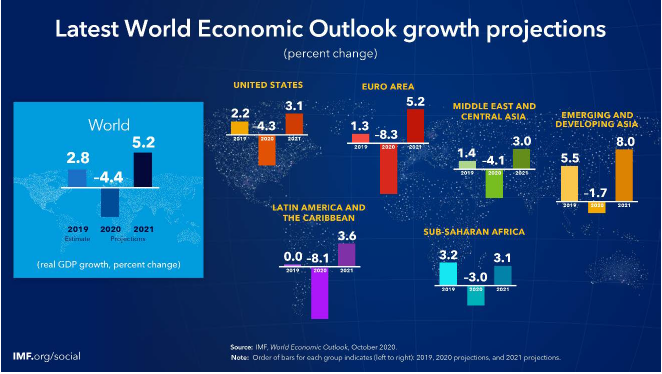
Regardless, it seems like the Roaring 20’s, if not 1999, have already reappeared in some parts of the financial markets. The initial public offering market is on fire, with the first day trading in stocks like DoorDash (up 85.7%), AirBnb (up 212.8%), and Poshmark (up 241.7%) providing 1999-like whiplash. These sorts of price movements, the record number of SPAC (Special Purpose Acquisition Company) or “Blank Check” public offerings, and values of certain equities completely detached from underlying fundamentals (e.g., Tesla) make me very uneasy. I have told many a class that significant increases in public offerings, including unique and widespread financial machinations – and SPAC public offerings certainly qualify – often mark market tops. In 2020 alone, non-financial firms globally raised nearly $4 trillion from public investors, including record levels of junk bonds, in the face of COVID and global recession.
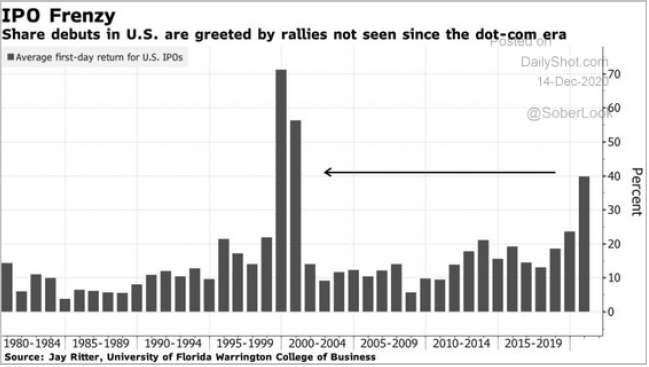
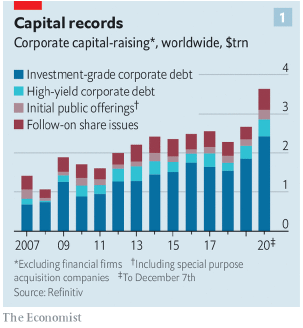
And commercial real estate? Industrial and multifamily properties, which have been the strongest performers, should continue to be stars of the show. That is not to say that either asset type is immune to broader economic challenges. However, the continued shift to e-tailing, last-mile distribution, and on-shoring of certain manufacturing activities will provide strong tailwinds for the industrial real estate, while high, if not unaffordable, single-family home prices, reduced housing starts, low supply of homes for sale, and an improving job market should provide strong foundational support for multifamily assets. Apartment cap rates should remain below five percent. Distressed retail, office, and hotel/hospitality markets may attract significant institutional capital seeking higher returns, but these opportunities will come with commensurate risk.
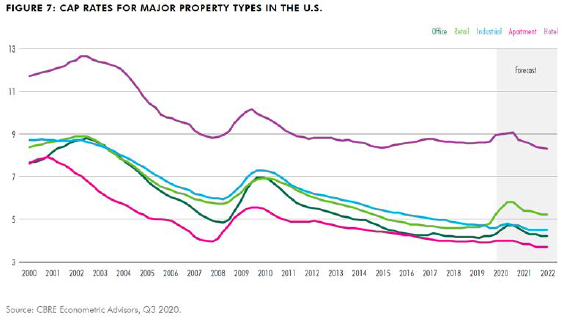
A couple of other data points in the multifamily markets are worthy of mention before I get much further. One, the national apartment vacancy rate increased to 5.2% in the fourth quarter, up slightly from 5.1% in the third quarter and 4.7% in the fourth quarter of 2019. Apartment rents declined 1.4% in the fourth quarter and over 3.0% during the year, with major metros like Boston, Seattle, Chicago, New York City, San Francisco, San Jose, and Washington D.C. suffering double-digit declines, while more affordable markets (e.g., Boise, Albuquerque, Bakersfield) actually saw higher rents (increases of 6.0 to 8.0%), so national figures mask significant variances in individual submarkets.
Finally, while overall rent collections nationally remain high, collections are down year-over-year and more payments are being made during the latter half of any particular month. Our overall portfolio has experienced similar collection patterns. Presumably, stimulus checks and an improving job market later this year should help, though we will have to see how the second quarter shapes up, once the next round of stimulus checks goes out and most people await their turn in the vaccination lottery.

In summary, it is a mixed economic bag, with the promise of widespread vaccinations providing room for optimism and an economic recovery in the latter half of 2021 and into 2022. The record high deposits at U.S. commercial banks ($16 trillion), all realizing negative real returns, will continue to provide substantial support for financial and tangible asset values. With real estate collateral underpinning something like 60% of the U.S. banking system, monetary policy will also likely continue to support asset prices and economic growth.
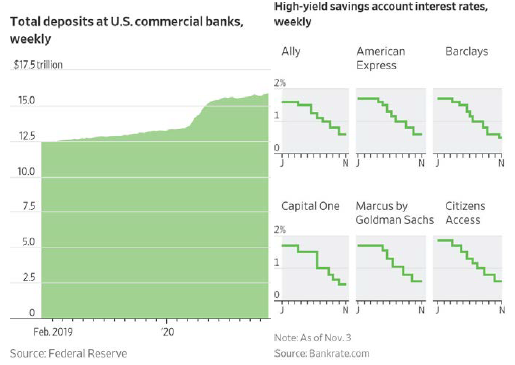
Meanwhile rich equity valuations (if not speculation in some corners of the market), increased deficit spending, burgeoning government borrowing (at all levels), higher household debt, and political divisiveness create uncertainty. On the other hand, the contrarian in me is not disappointed with some uncertainty, as we seek to identify and acquire investment opportunities.
While I usually minimize political discussions in these quarterly missives, the November elections will prove very impactful and cannot be ignored
Now that it is clear that the Democrats will control both the executive and legislative branches through 2022, performing a Georgia miracle along the way, we can expect a flurry of significant legislation and executive orders regarding taxation, infrastructure, healthcare, immigration, housing, and the environment. In the short-term, Congress will be preoccupied with a second round of impeachment proceedings and the proposed stimulus package, but our elected representatives will be busy bees during the next 24 months. Expect significantly higher corporate and individual income taxes (for those earning in excess of $400K per year) and less favorable tax policy for commercial real estate investors, including the likely elimination of 1031 tax-deferred exchanges.
How influential the progressive side of the Democratic Party will be remains to be seen, but I expect President-elect Biden to promote bipartisanship and balance, if he is true to his word…which I realize may be an oxymoron when it comes to politicians. However, in this case, I expect it to be true. And while I am concerned about deficit spending and increased levels of government debt, I have never been much of a believer in “trickle-down” economics, as I made clear in my memo from 2018 following the Tax Cuts and Jobs Act of 2017. I have since expressed my profound concerns about growing wealth inequality, so it may simply be the lesser of evils. I don’t know how our Republic can survive without a solid middle class, and higher taxes may be the bitter pill to be swallowed to accomplish this objective.
In any event, I found the following effectively captures the impact of the proposed Biden platform and the $5.4 trillion in additional spending it would compel over the next decade, only partly offset by higher taxes:

Clearly, the U.S. Treasury will also be busy bees, issuing greater levels of debt to fund these ambitious plans, with debt to GDP ratios likely reaching all-time highs by 2025.

While not concerned about increased debt levels in the short-run, as mentioned, I do fear the higher inflation and asset values they will likely fuel in the intermediate to longer-term. I don’t think for a second that the Fed’s “easy” monetary policies and elevated equity values are unrelated. However, at this point, the markets are not forecasting significantly higher inflation. It may just be that inflation in financial assets (including real estate) will be offset by broader deflation in everything from energy to consumer goods to office and retail rents.

In short, while I am not projecting a return to the 1970’s and the 10 percent inflation it brought, the after-effects of monetary stimulus, deficit spending, and corporate investment may catch investors off guard in 2022 or 2023.
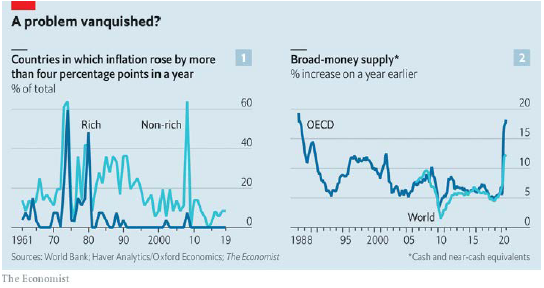
History is full of surprises and when consumers see the light at the end of the COVID tunnel, significant increases in spending and prices may follow. Perhaps anticipating increases in government stimulus, deficit spending, and government borrowing, interest rates have begun to creep upward during the last few months.
While the Fed has indicated that it will keep interest rates “at or near zero” until 2023, yields on 10-year Treasuries have been creeping up as of late, to 1.10% at last glance (end of second week in January), versus 0.68% at the end of the third quarter. They began 2020 at 1.88%. While short-term moves and 50-basis point increases in short-term rates may seem insignificant, they can materially impact borrowing costs tied to both residential and commercial mortgages. For example, 30-year mortgage rates for single-family homes averaged 2.84% this past week versus2.67% at year-end.
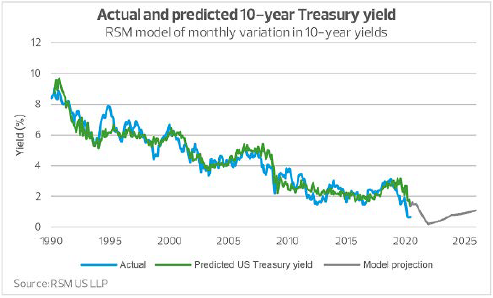
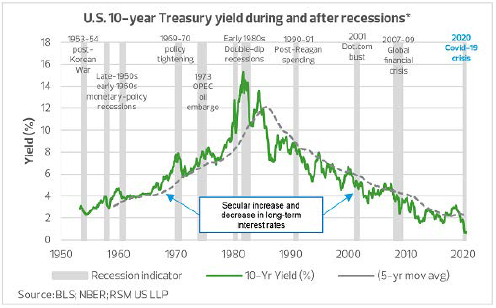
In short, I expect interest rates to move in a narrow range during the first half of the year, as the economic recovery proves sluggish and uneven, but to rise during the latter half of 2021 and into 2022, as economic growth and consumer spending resume and the Fed’s money-printing endeavors result in greater financial and real estate asset inflation.
Meanwhile, the multifamily market should remain solid in coming years, with physical occupancies remaining high and rental growth resuming later this year
With slightly increased national vacancy, modestly lower rents, and collection challenges caused by COVID, 2020 was a tougher year for multifamily assets, following years of strong performance. Regardless, multifamily assets certainly outperformed other classes of investment real estate (e.g., retail, office, hotel/hospitality).

However, not all multifamily markets are created equal, and national-level data obscures significant local and regional differences, as mentioned above. For example, overall rents dropped in all 10 of the most expensive cities for renters during 2020, with San Francisco, Seattle, Boston, and New York rents declining 20% or more between March and year-end. Yes, 20% or more. Eighteen of the 30 largest U.S. cities saw more renters departing, as opposed to 2019. With the option to work from home, many renters fled these larger, dense cities for suburbs, mid-sized cities, and even vacation rentals, resulting in higher rents in many locales.
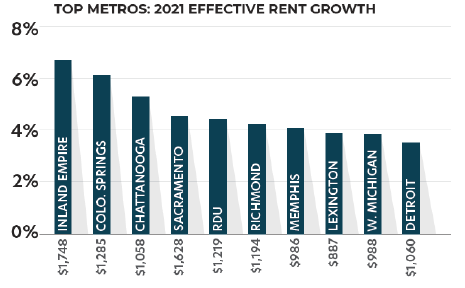
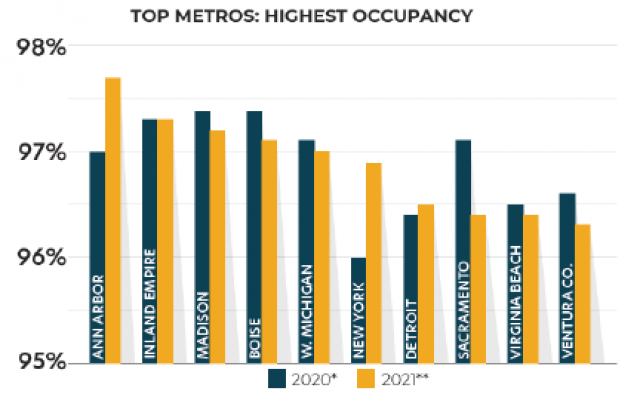
Before the pandemic, remote work was already expanding in the U.S. In 2019, work-from-home employees accounted for nearly 12.0% of the total labor market, but in response to the pandemic, that figure shot up to 35%, according to a recent report from Newmark. While most of these workers will return to the office once the pandemic ends, it is clear that the remote-work segment of the market will grow significantly, perhaps evolving into an office-remote hybrid model. As a result, many apartment units are being reconfigured to better accommodate work-from-home needs, by creating indoor workspaces, adding balconies and more outdoor space, and providing high-speed internet and cellphone coverage throughout particular properties.
Meanwhile, the U.S. is becoming a “renter nation” yet again. According to RENTCafe.com, an estimated 45 million Gen-Zers (people born in late 1990’s or early 2000’s), will have entered the housing market by 2025, most of whom are likely to rent. Overall, renters still comprise 33.6% of the U.S., up from 33.0% in 2010. The reality is that renting remains more affordable than purchasing a home in 18 of the 25 most populated counties in the country, and in 29 of 44 counties with populations exceeding one million, assuming that potential homebuyers have the funds to meet down payment requirements.
Between the high cost and lack of supply of buildable lots, high land and infrastructure costs, volatile material prices (i.e., lumber, copper, brass, steel), a challenging labor market, and excessively lengthy entitlement processes and regulations, single-family residential home construction lags substantially below longer-term historical averages and the supply of new homes declined again last year. These trends are likely to persist longer-term, which may be mediocre news for prospective homebuyers, but good news for apartment owners and investors.
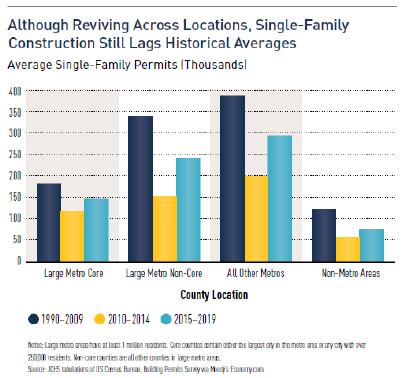
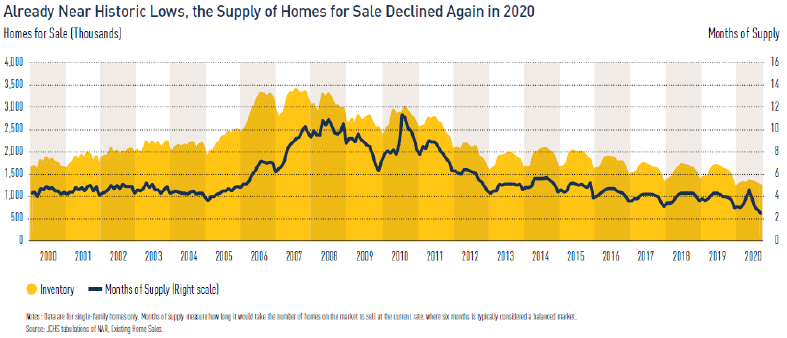
The combination of low supply of homes for sale and record-low interest rates (30-year mortgages under 3.0%), it can’t come as any surprise that home prices nationwide increased 8.2% between November 2019 and November 2020, according to CoreLogic, with virtually every region sharing in the fun. But with the median home price in the U.S. hovering around $320,000, affordability remains a challenge in many markets, providing additional foundational support to the multifamily markets.

Meanwhile, developers are poised to add over 300,000 apartment units in 2021, down slightly from 2020, as construction delays caused by both the pandemic and economic slowdown push some projects into 2022.
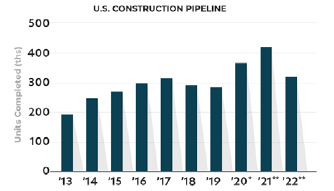
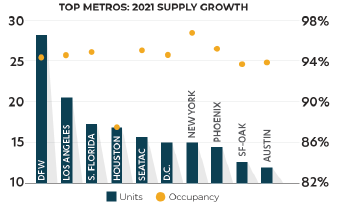
Finally, if you are interested in reading more about our housing markets and find yourself with substantial free time, I might refer you to this year’s “State of the Nation’s Housing,” published by the Joint Center for Housing Studies of Harvard University, which you can find here: https://www.jchs.harvard.edu/state-nations-housing-2020. The Report echoes many of the same themes from prior years: a lack of affordable housing, unequal access to homeownership, and calls for “comprehensive re-envisioning of national housing policy.”
Clearly, we need to watch the job market very closely to gauge the strength and sustainability of any economic recovery
In the absence of government stimulus, a resurgence in COVID cases (including a more contagious variant), and the fractious discourse voiced from certain politicians and their supporters, the job recovery has stalled. Employers cut 140,000 jobs last month, the first net decline in employment since last spring, and initial claims for state unemployment claims exceeded one million during the second week of January, a figure last seen in July.
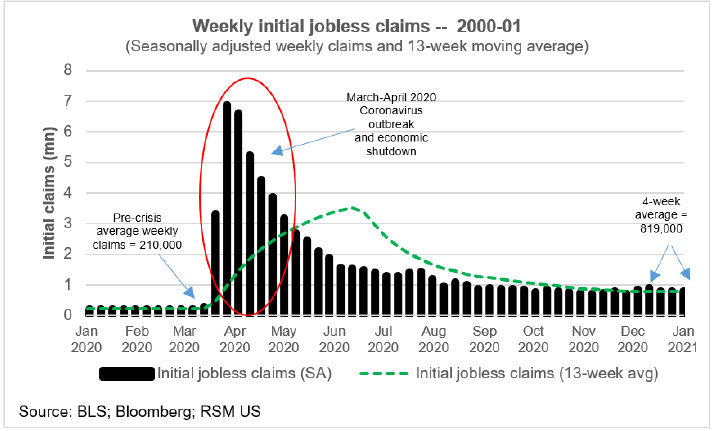
Until we reach herd immunity from COVID and the Biden Administration settles in, I don’t think we will see marked improvement in the unemployment rate, which remains at 6.7%. The job losses have been especially hard on people of color and the younger demographic. In fact, as of the end of September, some 25 million young adults were living with their parents, two of whom happen to be cohabitating with yours truly. The silver lining is that these young adults will likely become renters in short order.

Overheated equity markets may represent the greatest economic risk beyond COVID-19
While calling market tops in the stock market may be a fool’s errand, recognizing when equity values become detached from underlying fundamentals is not. Having lived through a few market cycles, I am concerned by the recent flurry of initial public offerings, which have soared on their trading debuts, the widespread issuance of unique securities (e.g., SPACS, cryptocurrencies), increased speculation by retail investors (welcome to Robinhood), and substantial growth in margin debt. As I have stated before, significant liquidity and near-zero interest rates can create serious fuel for financial dislocations.
If a picture tells a thousand words, equity market returns have diverged from changes in real GDP in recent years, especially in 2020.

Meanwhile, “zombie” company debt is at an all-time high, exceeding $1.3 trillion. These are firms whose interest expense exceeds their operating income, whose survival depends on financing (and refinancing) with cheap debt. These firms comprise some 19% of the Russell 3000 Index, or 571 companies, employing more than 800,000 people. While recessions generally act – in Darwinian fashion – to restrict these companies and their operations, a combination of cheap and readily available debt and equity capital, along with government largesse (e.g., PPP loans), have allowed these firms to continue operating.

And margin debt? It recently hit an all-time in November 2020, a record $722.1 billion, topping the previous high of $668.9 billion and representing a 28% increase from the prior year, according to the Financial Industry Regulatory Authority (FINRA). I would note that March 2000 and July 2007 represented prior near-term highs in margin debt. Perhaps “this time is different” because interest rates are so low, but color me a cynic.
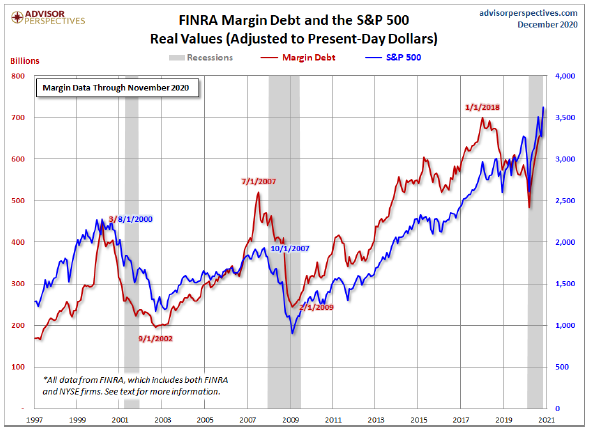
Finally, I should not neglect to mention the significant concentration in equity valuation, represented by large-cap technology companies. At the start of 2020, Alphabet (Google), Amazon, Apple, FB, and Microsoft were worth approximately $5 trillion, collectively, and comprised about 17.5% of the S&P 500. Fast forward to today and the figures are $7 trillion and 22%, respectively. While these firms are truly outstanding, and anything but zombies, this amount of market concentration simply makes me a tad uneasy.
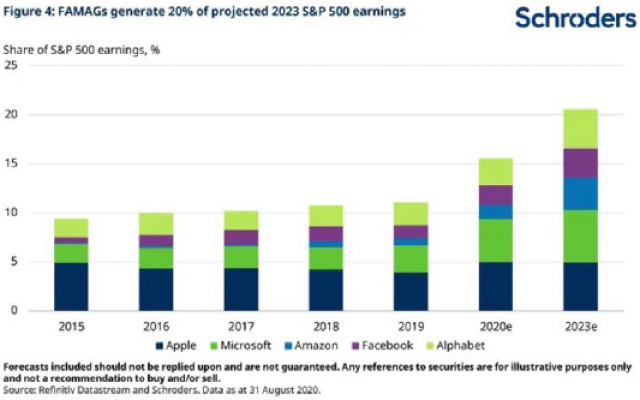
And, as usual, if you will indulge me, there are always additional tidbits I think are worthy of discussion
- Private Sector Assuming Public Sector’s Failures re: Affordable Housing: In a recent WSJ article, Amazon indicated that it would commit $2 billion to “create and preserve affordable housing in three of its employment hubs: Seattle, Arlington, and Nashville.” You may recall that I described in prior memos how Alphabet/Google, Apple, and Microsoft had previously made similar pledges of $1 billion, $2.5 billion, and $750million, respectively. Therefore, in sum, four of the largest tech companies I just described as representing such a substantial percentage of our equity markets, have committed $6.25billion to affordable housing. However, it is not clear how these “commitments” will translate into actual housing given broader market realities I describe elsewhere. Regardless, $6.5 billion is not really impactful, either to these firm’s bottom lines or overall housing affordability. However, these actions reflect how the private sector is trying to assume responsibilities normally tasked to the public one.
- The Baby Bust Continues: Contrary to many predictions that quarantining and isolation might lead to a “baby boom” (one can only watch so much Queen’s Gambit, I suppose),analysts now expect up to half a million fewer babies in 2021 (3.3 million) versus 2019 (3.8million). My sense is that concerns about the economy are the principal driver, though COVID and the worries it has brought are not exactly aphrodisiacal.
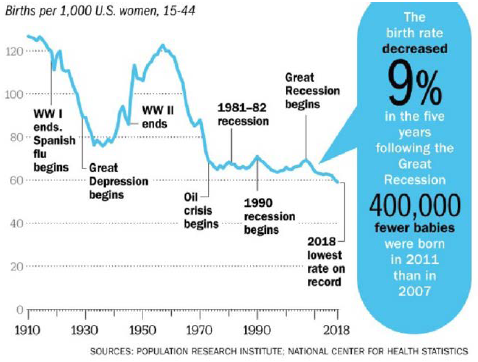

Here is the upshot. The U.S. population is approximately 330 million today and growing only 0.5% per year, between sharp drops in fertility rates and immigration. Therefore, the country is likely within 10% of its peak population and may never reach 400 million residents. While there is a growing number of seniors living to 85 and beyond due to healthcare advances, the number of people in the U.S. under 60 is decreasing every day. Therefore, many metros will see no changes in their populations for the foreseeable future. Others will see population declines. These demographic shifts do not bode well for future economic growth (see Japan).
So follow the Baby Boomers, the growing cohort of those over 65, who are affluent and tend to favor cities in the South and Southwest, such as Phoenix, Vegas, Tampa, Orlando, Austin, Dallas, Nashville, Charlotte, and Raleigh-Durham. These markets ought to fare relatively well, while Millennials flock to some of these same cities, but also to Denver, Seattle, and Portland.
- Domestic Migration Continues: Over the past several years, I have written extensively about domestic migration, how California, for example, has experienced population declines every single year between 2010 and 2019, a trend most certainly continuing into 2020 and beyond. New York City lost 376 residents each day in 2019. Previously these population outflows were offset by international arrivals and domestic migration. Not any longer. In some cases, the wealthy are moving to more tax-favored states (e.g., Nevada, Texas, and Washington). In others, corporate residents (and presumably a large number of their employees) are relocating. Oracle, HP Enterprises, and CBRE recently announced that they were moving their headquarters out of California to Texas. COVID has clearly accelerated the trend, as 18 of the 30 largest US cities saw more renters leaving compared to 2019. It should come as no surprise that we are mostly underwriting and evaluating investment opportunities in these “destination markets.”
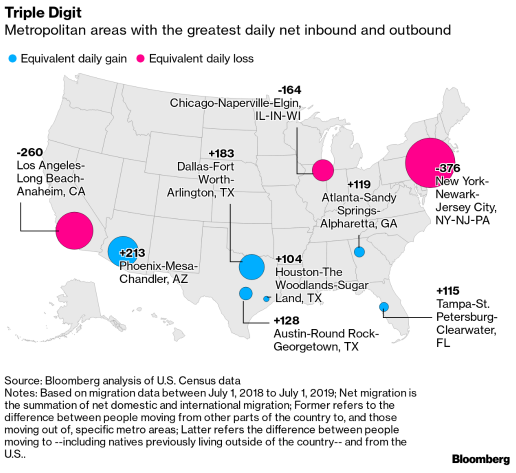
- 2020 Was, Unfortunately, a Banner Year for Bankruptcy Lawyers: As the economic repercussions from the COVID pandemic continued to unfold, corporate bankruptcies piled up. According to S&P Global Market Intelligence, 630 companies declared bankruptcy during the year, their worst levels since 2010 when 900 companies did so. By comparison, 578 and 513 companies declared bankruptcy in 2019 and 2018, respectively. High-profile bankruptcies included Neiman Marcus, J. C. Penney, Ascena Retail Group, Tailored Brands, and Chesapeake Energy. Some 23 companies sought bankruptcy protection during just the last two weeks of 2020.
As COVID forced lockdowns across the country, many retailers suffered terribly. According to Coresight research, retailers shuttered 8,400 locations through the third quarter of 2020, putting the year on track to surpass 2019’s record of 9,302 closures. Nearly 20% of all restaurants closed permanently last year. If a single graph indicates just how bad the retail apocalypse is in some locales, take a look at what has happened to asking retail rents in Midtown Manhattan. I think a 55% drop in rents qualifies as something between brutal and ugly. Amazingly enough, even with these far reduced rents, vacant storefronts still lurk on every block.

In closing, while the first half of 2021 will be challenging, I am optimistic the latter half of the year will represent a significant turning point and that the economy in 2022 will strengthen considerably
When I find myself with downtime (something of a rarity), I often reach for one of my favorite books, the “Complete Works of Calvin & Hobbes.” In fact, I believe that fictional “Calvin” is among my three favorite philosophers (as opposed to John Calvin, the 16th Century theologian). And if you are wondering, the other two are Yogi Berra and Dilbert. Anyhow, the very last published Calvin & Hobbes strip, released on December 31, 1995, made me think about 2021, and its message of hope, optimism, and the future:

We have been through an awful lot this past year, and perhaps it is darkest before dawn. With recent events in D.C. and sobering data and news on COVID, it can be hard to muster optimism, but I am certain that brighter days lay ahead, and with adversity and uncertainty, always comes opportunity.
The entire Clear Capital team wishes you and yours a healthy and prosperous 2021, and we look forward to sharing both our thoughts and investment opportunities with you throughout the year. For those of you who participated in our recent offerings in Carrollton, Texas, and Victorville, California, thank you. We appreciate your collective support of our firm and its endeavors.
Best,

Eric Sussman
Founding Partner
I figure lots of predictions is best. People will forget the ones I get wrong and marvel over the rest.
—Alan CoxThe best qualification of a prophet is to have a good memory.
—Marquis of Halifax
I must be off of my rocker to try and make sense of profoundly mixed economic data and provide economic forecasts immediately preceding a presidential election, especially this particular three-ring political circus. However, before you have me committed to Bedlam, please note that I strongly considered delaying this memo until after November 3rd, when we will all know who will control the Executive and Legislative branches of our federal government, and therefore be better able to predict what may be forthcoming as a result. I could have very easily blamed the delay on the hours I spent trying to get through this election’s War and Peace-sized California Voter’s Guide. Seriously, 112 pages? However, perhaps against my better judgment, I have decided just to get on with it. Time is money, after all.
In short, November’s election will likely and very consequentially impact future economic, fiscal, and tax policy. While I generally avoid political discussions here – Lord knows that we get plenty of that elsewhere and I care not to offend (any more than usual, anyhow) – the significance of this election cannot be overstated, if seen only through a fiscal and economic lens. COVID-19 is still wreaking havoc on the global economy, disrupting nearly every facet of life. Ten states reported their highest level of new cases just this past Friday. With the timing, availability, and efficacy of a vaccine unclear, when and how the economy and our way of life return to “normal” remain uncertain. While the economy will recover, the pandemic will leave deep scars, creating difficult policy choices and trade-offs no matter who emerges victorious in November.
Should Biden prevail and the Democrats take control of Congress, we should – at a minimum – expect impactful tax reform, reversing much of the Tax Jobs Creation Act of 2017 and substantially increasing taxes on wealthy individuals, estates, and corporations. I anticipate that some very favorable commercial real estate related tax laws (e.g., 1031 transactions, bonus depreciation, reduced taxes on real estate related LLCs) will go the way of the dodo bird. Additional and significant economic stimulus (read: trillions) will arrive, with aid directed to families, schools, restaurants and small businesses, airline workers, and those blue-collar workers particularly impacted by COVID-19. Government borrowings and our deficit will grow substantially, at least initially, expanding upon 2020’s already daunting $3.1 trillion budget deficit.
Should Trump prevail and Congress remain divided, the next four years will experience continued legislative gridlock, with the courts and judges playing an increasingly outsized role in interpreting, if not implementing, policy. Additional economic stimulus will be delayed and may never arrive. Late-night comedians, political pundits, former White House staffers turned book writers, and cable news personalities will continue to thrive. Much else is harder to predict, if just because political and other divisions will fester and likely produce unpredictable outcomes.
With this being said, it is not surprising that this has been the most uneven economic recovery in modern U.S. history, which some have aptly described as a “K”. White-collar workers and those owning financial assets are faring well enough, while the working class and those owning few financial assets, struggle. Consider that Wall Street experienced its best back-to-back quarters since 2009, with the S&P 500, DJIA, and NASDAQ up 8.5%, 7.6% and 11%, respectively, during just the third quarter alone. Domestic equity markets are up more than 50% since spring, with indices trading at or near all-time highs on both an absolute and relative (price-earnings ratio) basis. The median home price (asking) in the U.S. climbed to $350,000 in September, up over 11% from the prior year, according to realtor.com, an all-time record. Again, those who own equities and real estate are relatively happy campers.
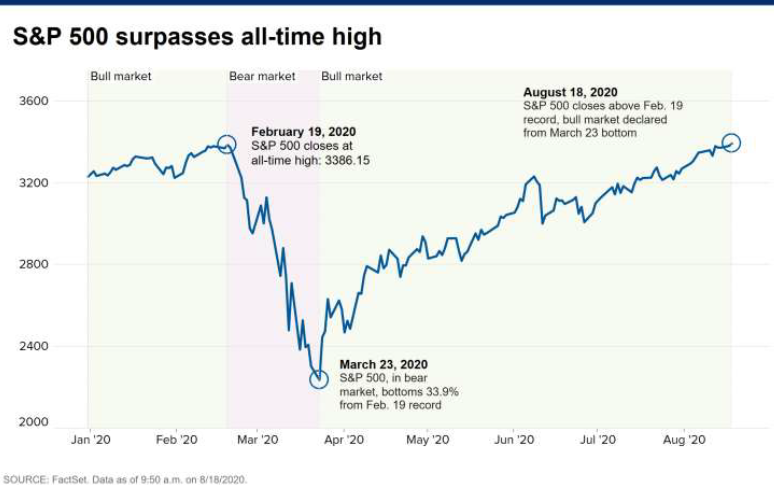
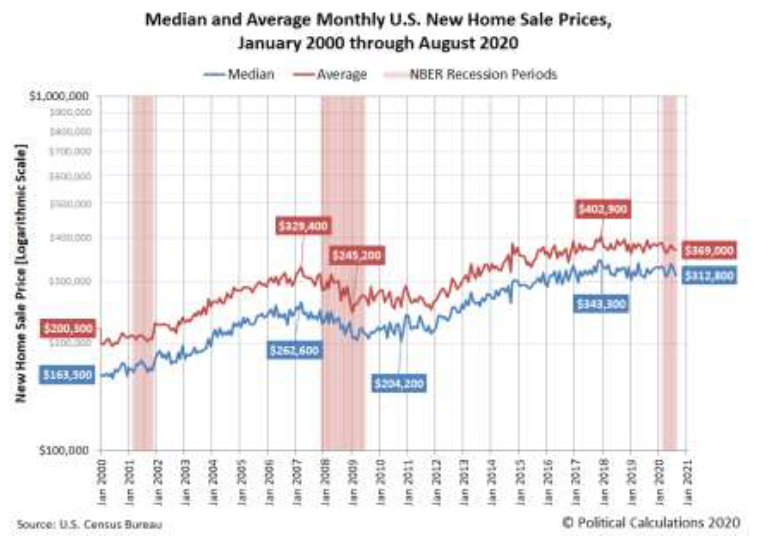
Meanwhile, the labor market has stagnated, with the national unemployment rate sitting at 7.9%. While perhaps a noteworthy improvement from the double-digit unemployment rates experienced earlier this year, unemployment has more than doubled from pre-pandemic levels, and there are gloomy clouds on the horizon. Jobless claims have jumped yet again, with first-time claims for the week ending October 15th, hitting their highest levels since August (898,000), while some 700,000 workers have left the workforce. In addition, a number of large companies have recently announced new rounds of layoffs: Disney (28,000 across its U.S. theme park division), Royal Dutch Shell (9,000), and Boeing and several of the major U.S. airlines (as many as 100,000, collectively). The National Restaurant Association said that some 100,000 restaurants have closed over the past six months, putting three million employees out of work. Again, it is a tale of at least two economies, for those that have, and those that do not.
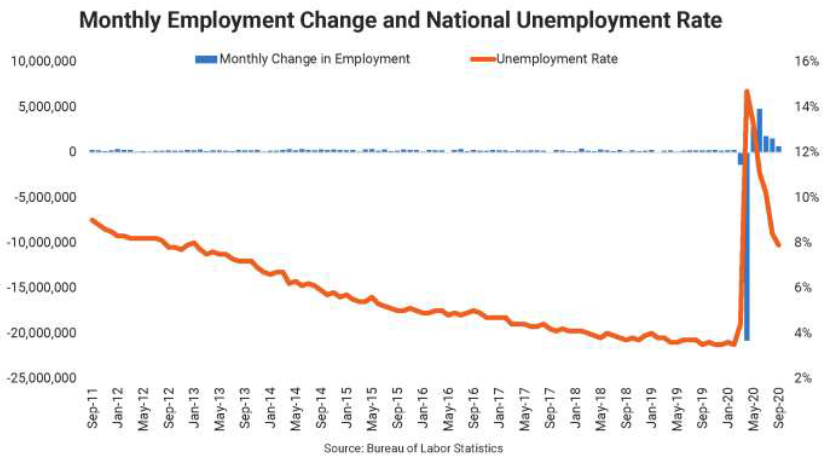
In this economic dichotomy, the multifamily market continues to perform fairly well, though headwinds and tailwinds are engaged in a fierce tug-of-war, providing mixed results. Overall, physical occupancy remains high, over 95.0% nationally, though rents have softened. Occupied apartments climbed by nearly 147,000 units in the third quarter, nearly four times second quarter figures. While over 90% of apartment households paid full or partial rent in September, these results reflect declines (about two percent) from the prior year, and in the absence of further government largesse and marked improvement in the job market and unemployment claims, I see more downside to these results, especially in certain markets.
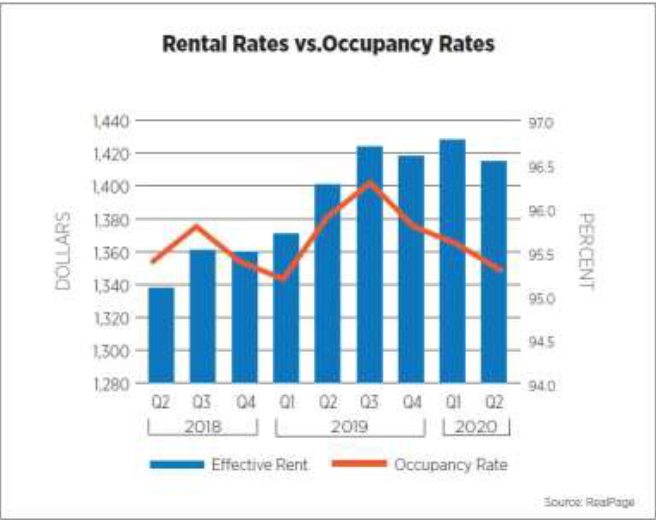
However, as I have discussed previously, different market segments and geographies are witnessing different results. For example, New York and San Francisco have experienced double-digit percentage rent declines over just the past six months. I recently read that there are some 16,000 empty apartments in New York City, the highest level since the 1970’s, nearly tripling the vacancy rate. Meanwhile, other markets (e.g., Albuquerque, Colorado Springs) are achieving rental growth, albeit modest, and attracting residents from more expensive (read: California) locales. It is not surprising that it is these markets – principally in the Sunbelt – where Clear Capital is focusing its acquisition and underwriting resources. Our recent offerings in Lakewood, Colorado, and Carrollton, Texas reflect our views and perspective. Even with our principal focus on the Sunbelt, our primary focus is always on the upside of real estate. As such, we are seeking opportunities in the Golden State that we call home. While this is somewhat of a contrarian approach, we believe there are good opportunities in California – mainly in the Inland Empire region and in workforce housing assets.

In summary, I don’t anticipate the economy and employment to return to pre-pandemic levels until 2022, with a double-dip recession quite possible between now and the end of the first quarter of 2021. However, much depends on the upcoming election and what government stimulus programs arrive…or not, and whether lenders continue to work with borrowers and forbear delinquencies to prevent a wave of foreclosures and forced sales. Presently, some 3.5 million home loans (about 7.0%) were in forbearance as of September 22nd, according to the Mortgage Bankers Association, and commercial foreclosures have been creeping upwards.
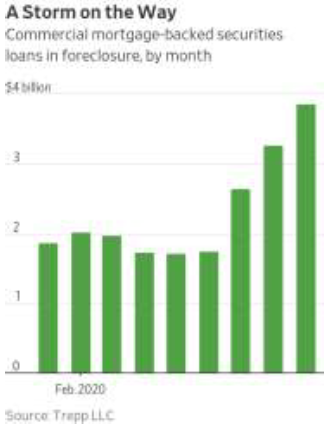
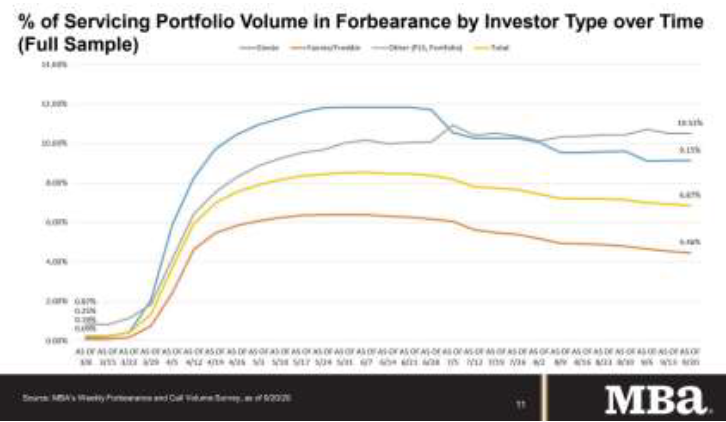
Low interest rates and substantial liquidity will continue to provide critical foundational support to markets and asset values, and while we continue to believe strongly in the multifamily story, conservative underwriting and sensitivity analyses are a must.
While apartment fundamentals remain intact, transaction volumes have dropped sharply, and bid-ask spreads, have widened. Meanwhile, the single-family residential market has surged in the face of record-low supply and interest rates
Commercial real estate transaction sales volume (including apartments) dropped by two-thirds in the second quarter from the same period last year, and while data for the third quarter has yet to be released, I anticipate that it will reflect similar declines. According to CoStar, some $35.5 billion in transactions closed in the second quarter, down 69% from the nearly $114 billion in sales during the same period last year. Meanwhile, property listings dropped 15%.

Yet, apartments are still attracting significant investment capital. In one noteworthy transaction, CIM Group, a local institutional player here in Southern California, purchased a 2,346 unit portfolio in Alexandria, Virginia, for over $500 million. Closer to home, Clear Capital listed one of its assets for sale in the third quarter, an affordable project in Azusa, California (Iris Gardens), and attracted multiple bidders. Reduced rent headwinds are being offset by lower interest rates, liquidity, and certain demand tailwinds.
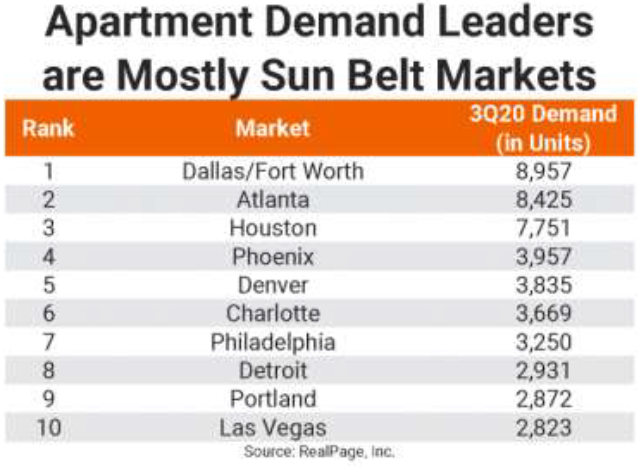
However, the pandemic has certainly shifted what renters seek in units. One is space. Prospective tenants want larger units and common areas. Bachelor, single, and studio units are not nearly as popular in the era of COVID as larger two- and three-bedroom units, and with good reason. Previously, tenants placed great value on swimming pools, gyms, and flexible common areas. Now, with so many residents working from and eating at home, balconies, package lockers, and HVAC/air filtration systems have become relatively more appealing. Record numbers of young adults (18-29) have returned to the nest as a result of COVID, university closures, and stubbornly high rents. Ultimately, these youngins will return to the rental market, so when the economy more sustainably recovers, these prospective renters should provide additional tailwind to the multifamily market.
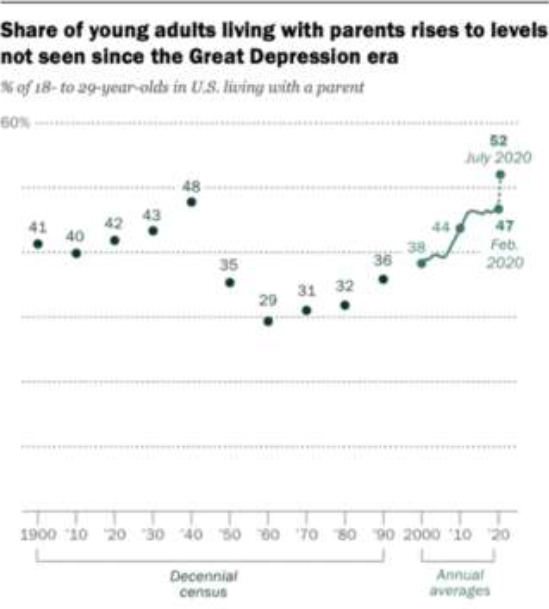
Meantime, the single-family residential market continues to shine, reflecting pent-up demand, relocations to the suburbs from urban cores, record-low numbers of homes for sale, a dearth of new construction, and cheap debt, with fixed-rate, 30-year home loans available in the 2.9% range (if not lower).
Nationally, inventory of homes priced under $100,000 was down 32% in July from a year earlier, with homes priced between $500-700,000, down 9%. Baby boomers with some $10 trillion of equity in their homes are not selling or moving, certainly not in the midst of a pandemic. Finally, institutional home-rental firms like Invitation Homes (the country’s largest rental-homeowner, at 80,000 homes), Tricon Residential, American Homes 4 Rent, and Roofstock have been snapping up large swaths of homes in certain markets. Invitation Homes has been spending some $200 million each quarter in new acquisitions. A few graphs, capturing Case-Shiller housing data (threemonth lag), total volume of home sales, and national homeownership rates, tell a thousand words:
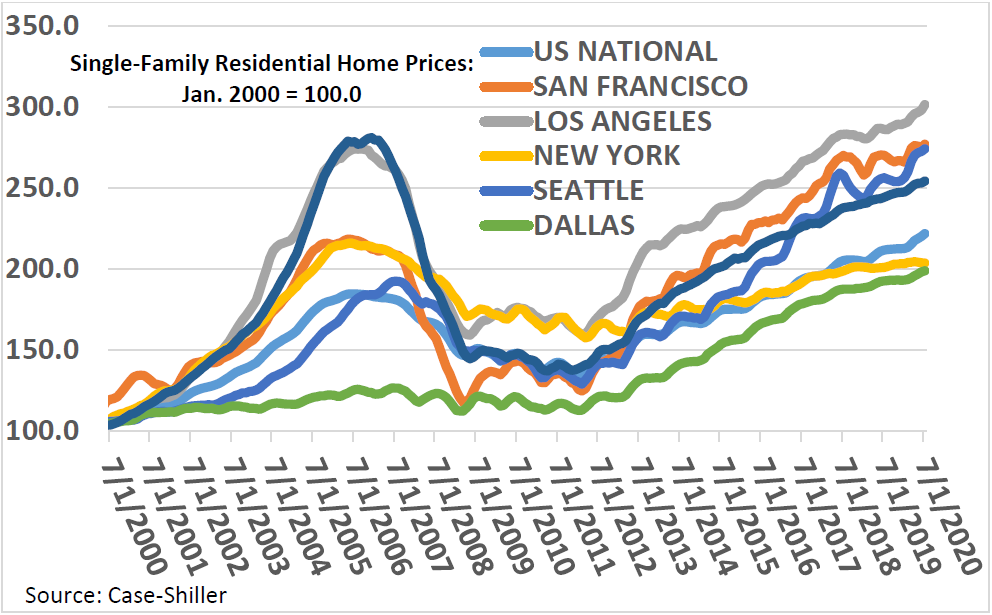
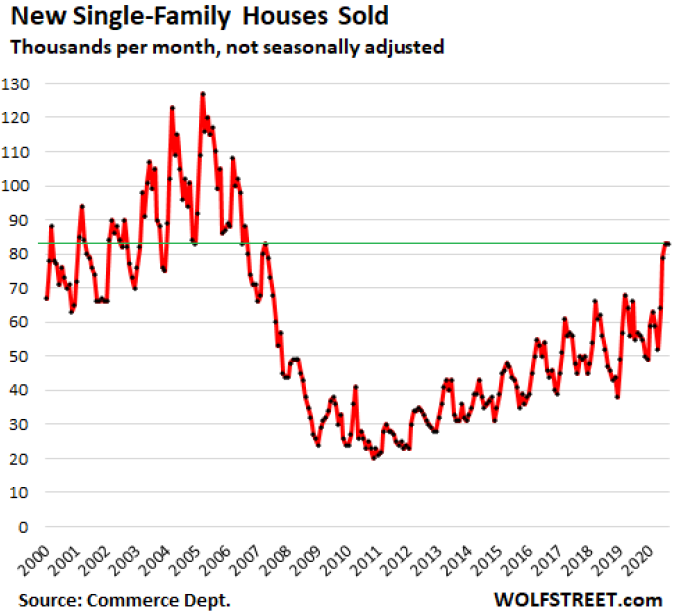

At this point, I see house price increases moderating in the absence of further economic stimulus or real gains in employment levels or wages, as mortgage rates have likely reached a near-term floor. The multifamily market should continue to attract tenants and maintain high occupancy rates, but rental growth will be harder to come by, and we are underwriting prospective opportunities with this perspective in mind.
With 10-year Treasury Yields hovering around 0.70%, mortgage rates under 3.0%, and Fed assurances that low rates are here for the foreseeable future, asset values have significant foundational support
If I had told you any number of years ago that you would be able to secure a fixed-rate, 30-year home loan at a rate of between 2.50% and 3.0%, you might have accused me of having inhaled or consumed a little of California’s most infamous herb (no, not kale). Yet, here we are. 30-year mortgage rates hit a record low just last week, averaging 2.81%, the lowest rate since Freddie Mac began publishing such data back in 1971. For comparison’s sakes, the 30-year mortgage rate averaged 3.69% a year ago.
If you think mortgage rates are strictly low on single-family residential properties, I am presently refinancing an existing commercial loan on an industrial portfolio here in Southern California at a fixed rate of 3.05% for ten years. You could have pushed me over with a feather when I received that LOI. Low rates are global and even real corporate bond yields (after inflation) recently turned negative.
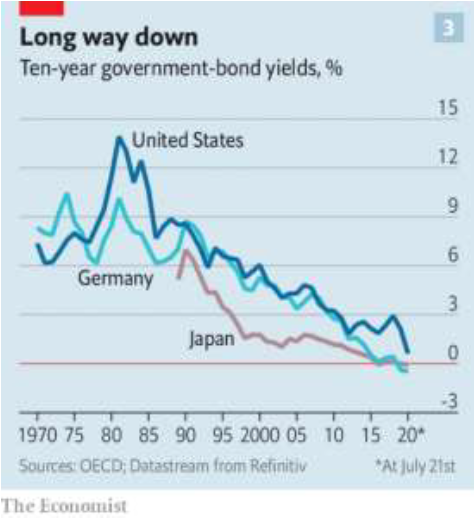

Many moons ago, as an undergraduate economics major, I had to learn my John Maynard Keynes macroeconomic framework (“The General Theory of Employment, Interest and Money”) and views that the government had a significant role in managing economic or business cycles, through its power of the purse. Over time, Milton Friedman and the monetarists, who emphasized a focus on inflation through control of money supply, found their voices in the stagflation, high unemployment, and high inflation of the 1970’s. Paul Volcker, Chair of the Federal Reserve in the 1980’s, crushed inflation by constraining money supply, but in the process, the economic downturn worsened and unemployment increased.
In the last 20 to 30 years, it seems that a sort of marriage of the two disciplines evolved, with both monetary policy and fiscal policy being used to manage federal spending, economic growth, interest rates, and “reasonable” debt levels, based on an overall two percent inflation target. That is until recently, anyhow, perhaps because fiscal policy has become overly politicized, leaving the federal government with fewer options in its toolkit.
Sure enough, in an August speech, Fed Chief Jerome Powell, indicated that the Fed would ease inflation targets (read: can the 2% goal) and no longer necessarily raise rates preemptively to curtail higher inflation. Such a policy shift is not likely to be impactful in the short run, but looking back, the Fed probably would not have raised rates in the last five years as the economy recovered and fears of inflation arose. Essentially, the Fed is telegraphing that it wants core inflation above two percent to counter low growth in GDP, and that we should anticipate longer periods of lower rates and accommodative monetary policy (through 2023 at least). With core inflation presently running at less than 2.0%, and numerous economic headwinds still present, deflation remains a greater risk at the moment than any sort of significant or runaway inflation.

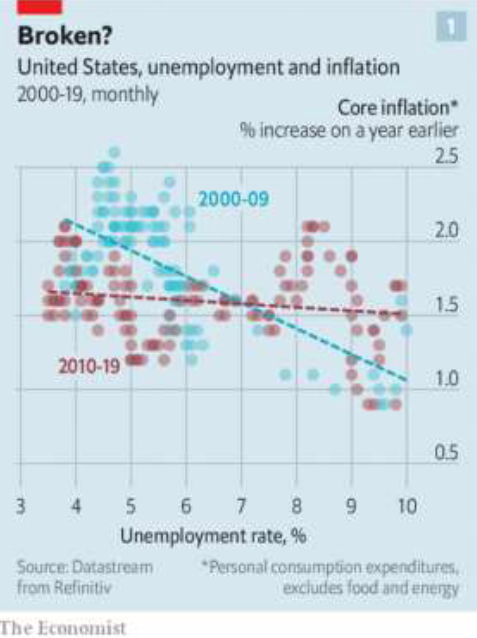
The punchline is clear. Low rates are here for the foreseeable future, which will provide some support for asset prices: equities, bonds, and real estate. Those seeking high yields are going to find few alternatives, and cap rates on commercial real estate investments will remain compressed. Couple low rates with excessive liquidity and you have a recipe for stubbornly high, and in certain cases (read: certain technology-related stocks), inflated asset values.
GDP and a fragile job market present the biggest risks to economic recovery and asset prices
In the face of lingering COVID infections, inconsistent policy responses across all levels of government, the absence of additional governmental intervention and stimulus, and yes, political uncertainty, the recovery in the U.S. job market has stalled. While the published principal unemployment rate improved to 7.9%, a 0.5% improvement over August figures, and half of the jobs lost since the start of the pandemic have been regained, some 700,000 workers have since dropped out of the labor force (as mentioned above), signifying that actual unemployment is far higher than 7.9%. While nonfarm jobs increased 661,000 in September, weekly jobless claims remain persistently elevated.
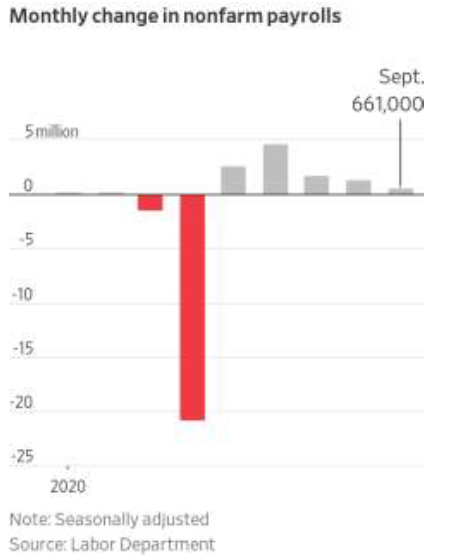

While third quarter GDP is expected to increase over 30%, that growth comes on the heels of a record-setting second quarter decline of 32.9%, both records since record-keeping began 70 years ago. Keep in mind that 30% growth following a nearly 33% decline still means that GDP is down more than 10% since the pandemic began. The question is what happens in the fourth quarter and beyond. At this point, I think the likelihood of a double-dip recession is significant, especially in the absence of additional federal stimulus. Without stimulus, herd immunity, or a vaccine, we will remain in an extended period of economic malaise. That is, even if we don’t experience a double-dip, hopes of a “V” or “U” recovery become significantly less likely.
Speaking of which, it’s unfortunate that government stimulus proposals have become so heavily partisan, when the economy might very well benefit from a kick in the pants
I recognize that many believe the government should take a hands-off view towards the economy and leave markets alone to their own devices, while others believe Uncle Sam and state governments ought to take a heavier hand in providing one form of economic stimulus or another. Frankly, it seems that individuals within their own political parties don’t necessarily agree on how much stimulus should be provided, if any, and/or to whom it should be directed. I fall in the middle of these two camps and believe that some form of stimulus will aid in accelerating economic recovery. One proposal that seemed eminently reasonable and logical to me was put forth from Senator Michael Bennett of Colorado, who wanted to link federal unemployment benefits to local unemployment rates. Of course, this means it has absolutely no chance of passing.
I know that growing national debt levels scare the pants out of many, though conservatives are far less focused on this issue today than they were four years ago. By 2021, if not sooner, our outstanding national debt will likely exceed the size of our entire economy for the first time since World War II.
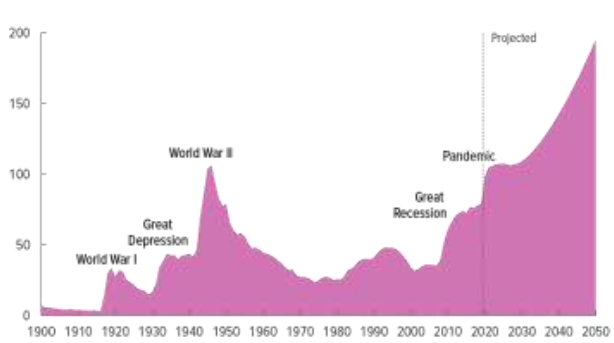

The question becomes when are our national debt levels truly excessive? There simply is no consensus. Keep in mind that Japan’s gross debt is over 237% of its GDP, so one can argue that we have a long way to go before we are truly excessively indebted. Then again, knowing that we are quickly catching up to Portugal and Italy hardly gives me the warm and fuzzies.

So, should the government pass stimulus legislation or not? I guess it is the lesser of evils and risks in my view, and I believe some stimulus is necessary, while we can certainly debate how much and to whom the largesse should be directed. I suppose we will know soon enough. I wonder if Vegas is taking odds on whether it will happen, and if so, before or after early November.
If November’s California Ballot Measures are any indication, the public sector real estate creep is here to stay
Earlier in this memo, I half-joked about the length of the California Voter’s Guide, which includes no fewer than three very material real estate related measures: Propositions 15, 19, and 21. Proposition 15 represents the largest potential tax increase in California history. If passed, commercial properties (all residential properties are excluded) would be reassessed at least every three years, and taxed accordingly. Presently, property taxes are based upon a property’s last sale price, increased no more than two percent each year. Proposition 19 would modify property tax benefits accorded certain inherited properties, while Proposition 21 would significantly expand rent control. At this point, all three measures appear on their way to lose, and I am shedding no tears about that. While I willingly acknowledge that property tax reform is badly needed, these propositions are too onerous, and will have long-lasting negative repercussions for business and employment in the State, while failing to provide more and less expensive housing.
Meantime, any number of other ballot measures, laws and regulations across the U.S. are addressing evictions for both residential and commercial tenants, generally seeking to balance out the needs of both tenants and landlords. However, as I have said many times, there are far more tenants who vote than landlords who do so. The CDC has barred evictions for as many as 12.3 million renters through the end of the year, mostly tenants in buildings financed with federally-backed mortgages, extending protections provided by the CARES (Coronavirus Aid, Relief, and Economic Security) Act passed in late March. Those protections expired in July. While these measures generally do not relieve tenant obligations to pay rent and are arguably unconstitutional (“private property shall not be taken for public use without just compensation”), it is very unclear how landlords will be able to recover delinquent rent or pursue damages from regulations ultimately determined illegal.
This is not some theoretical issue as our firm – across our nearly 4,000 units – has a number of delinquent tenants, some of whom appear to merely be taking advantage of the situation, and we are hardly finding it easy to pursue any sort of meaningful recourse against them. Moral hazard is real. We are expending significant resources to collect delinquent rents and to work with tenants as best we can, within the confines of legal and political realities.
And, of course, there are a number of other interesting tidbits and trends which impact markets, the economy, and commercial real estate
Every quarter, there are a few other relevant and material data points, trends, or tidbits that are worth mentioning and discussing. The third quarter of 2020 was certainly no exception, so without further ado, here goes:
• The brick-and-mortar retail apocalypse continues: I know you don’t need me to tell (remind) you about what is happening to traditional retailers, who were being Amazoned (a new verb) and e-tailed before the pandemic, which accelerated the trend. The impact on just the job market alone is remarkable, and many of these retail-related jobs will not be returning anytime soon. 2020 is shaping up to be a banner year, and not in a good way. Here’s the sobering reality:
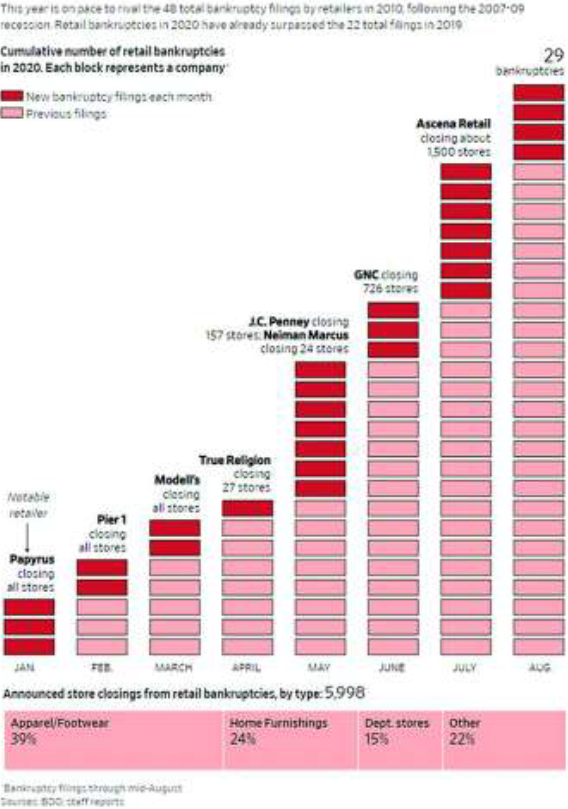
In time, will some of these jobs return and/or other retailers or uses occupy vacated leaseholds? Perhaps. But I don’t see any sort of “V-” or “U-like” recovery here.
• Expanding wealth inequality may be our single greatest economic and social threat: Over the years, I have repeatedly expressed concerns about the increasing chasm
between the “haves” and “have nots” in the U.S., and the impacts it has on housing, the economy, markets, and even our social fabric. In parts of California, and frankly, throughout much of the country, we may need to modify the list to the “haves,” the “have-nots,” and the “homeless”. I drive by entire homeless encampments each and every morning here in west Los Angeles. I am certain that some of the social unrest we witnessed this past summer, some of which persists to this day is based, in part, to wealth inequality. Perhaps some will disagree with me, but I believe it is not good for the stability, if not sustainability, of our economy, neighborhoods, and political system. If there is any silver lining tied to our business, it sure is creating demand for affordable housing, and we are actively looking for investments in that space, such as our present offering in Carrollton, Texas and our upcoming attainable workforce housing offering in Victorville, California. But I am not blind to the broader potential significance and import of this disturbing trend.
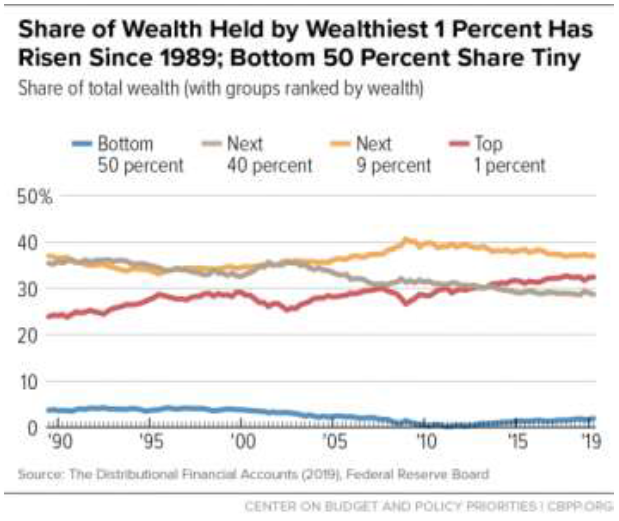
I do hope that whatever comes of the upcoming election that we – politicians and voters from all sides of the aisle alike – address the wealth disparity and homelessness issues, or
expect increasing social unrest and divisiveness to become recurring realities, and I can’t see any positives in that.
• Foreign investment in our real estate markets has declined sharply over the past year: It should come as no surprise that foreign direct investment in U.S. real estate
has dropped sharply in 2020, declining by nearly 40% during the first half of the year as compared to the same period in 2019. A recent Wall Street Journal, “Foreigners Buy Fewest U.S. Homes in Years,” says it all, though it is just not single-family homes, but all types of residential and commercial real estate for which foreign buyers have lost some appetite.
Obviously COVID is playing a role, but travel restrictions and constraints on capital outflows in places like China, have certainly not helped the cause.

While many predict a bounce in foreign investment next year – we are invariably an optimistic lot, after all – I am not nearly as sanguine, though I believe the U.S. will remain a
relatively safe and attractive place for foreign investment capital. I merely think CBRE’s anticipated 2021 bounce will be less robust.
• Higher property and casualty insurance premiums are a-comin’: Between the California and Colorado wildfires, hurricanes in the Atlantic, rain and flooding in the Midwest, and COVID-19, significantly higher property and casualty insurance premiums are coming our way, and all of us will be likely impacted, certainly any and all homeowners and investors in investment real estate. According to an industry report I just read (https://www.usi.com/content/downloads/2020_PC_Market_Outlook.pdf), premiums will increase by at least 10% for most standard coverages, while properties located in areas more prone to natural disasters or “catastrophic loss,” may see premium increases of anywhere from 25 to 40%. We are seeing premium increases across our portfolio, and these higher costs are not able to be passed onto our residential tenants. Meanwhile commercial tenants under triple-net leases are going to see far higher common area charges in 2020 and beyond.
• All that glitters is gold, and it’s not just Led Zeppelin who thinks so: Since the start of the pandemic, gold prices have surged, up some 25% in 2020, hitting an all-time high of over $2,067 an ounce in August, before falling back to around $1,900 an ounce where it presently trades. The decline in the U.S. dollar, the increased federal deficit, and lower interest rates (reducing carrying costs) have all played a part in the move.

Meantime, gold is not the only commodity that has “shined” of late. Lumber futures have more than doubled since early April, and prices reached the highest level seen since record
in spring of 2018. Prices have risen because producers idled plants and saw mills in US and Canada in March, beetle infestation, and, of course, the wildfires. Lennar, the largest U.S. homebuilder (by revenue), said that it is intentionally curtailing construction and sales to avoid higher material costs, hoping to make up difference in higher future sales prices.
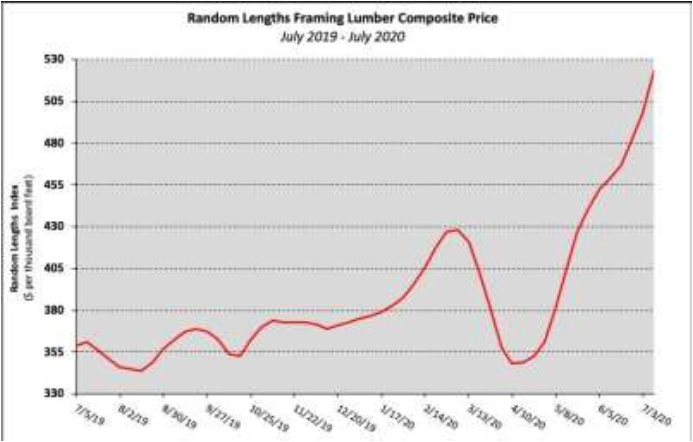
If homebuilders truly cut back on construction and new starts as a result of these higher commodity prices, the supply of new home inventory will be further constrained, putting
additional upward pressure on pricing of existing homes for sale.
In closing, while the next few months will bring impactful news, Clear Capital’s core investment philosophy, approach, and focus have not wavered, as we continue to focus our acquisition and underwriting efforts in the Sunbelt and in our home state of California
First and foremost, I hope that you and those in your close circle of friends and family remain in good health. That is of paramount importance, of course. I also hope that you have voted or will do so, regardless of where you sit on the political spectrum. We should never take this most sacred of rights for granted. And while I won’t tell for whom you should cast your presidential vote, I might gently nudge you to vote “no” on Propositions 15, 19, and 21, at a minimum, for those of you casting your lots here in California.
As mentioned at the outset of this memo, making forecasts in this environment is no easy task, as the outcome of the election could profoundly shift the direction of the country: economically, fiscally, and certainly, politically. I warn students nearly every quarter about the use of “Ctrl-R” and “Ctrl-D” functions in Excel, where one merely copies certain spreadsheet cells down and to the right, as though one year’s results or forecasts can be mechanically extrapolated into the future. I am trying very hard not to fall into that same trap myself.
However, whatever happens on November 3rd and thereafter, I remain steadfastly optimistic about the multifamily market and our acquisition, underwriting, and investment strategy. I am profoundly grateful to the entire Clear Capital team, which has faced the COVID-related challenges head on and worked extremely hard through some trying times. For those of you who invested in our recent Lakewood, Colorado opportunity (Falls at Lakewood), which was over-subscribed, and for those considering our present offerings, a 244-unit, affordable opportunity in Carrollton, Texas, and a 200-unit attainable workforce housing opportunity in Victorville, California, thank you for doing so, and for your continued support of our firm.
Best,

Eric Sussman
Founding Partner
I always avoid prophesying beforehand because it is much better to prophesy after the event has already taken place.
—Winston ChurchillThere are decades when nothing happens and then there are weeks where decades happen.
—Vladimir Lenin
As I reflect upon the first half of 2020, I can’t help but think about the book, “Fooled by Randomness: The Hidden Role of Change in Life and the Markets,” written by Nassim Nicholas Taleb, which I read nearly 20 years ago, when it was first published. A fairly quick read (and one that I recommend), it provided me with an appreciation for statistical aberrations and those seemingly random events – wars, financial crises, and yes, pandemics – which, while perhaps precisely unpredictable, routinely and very materially impact life, markets, and investment returns.
However, though I recognize that these “black swans,” as they are often labeled (and coincidentally, the title of one of Mr. Taleb’s subsequent books), are bound to occur over a long enough timeframe or investment horizon, I can say that neither a global pandemic nor widespread protests over police brutality and social/economic injustice appeared on my 2020 Bingo card. Over 140,000 Americans have now died from COVID-19, and records for new infections are occurring daily, most notably in Florida, Texas, and California, which, along with several other states, are in some form of economic lockdown. The deaths of Kobe Bryant and Qasem Soleimani, the Australian wildfires, the impeachment acquittal, the collapse in oil prices, and the Tiger King seem like distant memories, reflecting just how unusual (dystopian?) this year has been, with each day feeling a bit like Groundhog Day. I have never asked myself, “what day of the week is it today?” more than I have in these past four months. Thank goodness the murder hornets have not yet reached our shores.
In summary, the second quarter of 2020 was one that most of us would rather forget, distinguished as it was by several inauspicious records. We have already witnessed more bankruptcies this year than in all of 2008, the year that Lehman Brothers – the largest single bankruptcy of all time – failed, along with record levels of unemployment and the sharpest quarterly decline in GDP in U.S. history. The second quarter Chapter 11 graveyard includes firms such as Hertz, JC Penney, Neiman Marcus, Frontier Communications, Chesapeake Energy, Intelsat S.A., and Diamond Offshore. I am not exactly going out on a limb when I suggest that there will likely be several more names added to this list before 2021 arrives, not a moment too soon.
In fact, the WSJ and Coresight Research report that U.S. retailers are on track to close as many as 25,000 stores this year, more than double the previous record. However, it is simply too early to be sure what the ultimate fallout will be. Last week, the Wall Street Journal reported that JP Morgan, Citigroup, and Wells Fargo have set aside some $28 billion in reserves to cover anticipated pandemic-related losses, adding over 30% to previously accrued loan loss allowances.

Although the June unemployment rate of 11.1% represents a marked improvement over the 14.7% and 13.3% rates reported for April and May, respectively, these employment gains will likely prove transitory as more cities and states mandate closures (e.g., Atlanta, West Virginia), while others reimpose them (e.g., California, New Mexico, Oregon); the requirements that employers maintain employment levels under the Paycheck Protection Program burn off; and, both federal and state unemployment benefits expire (the $600 additional federal unemployment stimulus expires this month). Just this week, an additional 1.4 million claims for unemployment were made, representing the 18th straight week of unemployment claims exceeding one million. Not surprisingly, the U.S. economy shrank dramatically during the quarter, and while final figures are not yet available, consensus estimates are that U.S. GDP declined over 40% in the second quarter. Ouch.


And if this were not enough, CNBC recently reported that 32% of U.S. households missed their July mortgage payments, at least through the first week of the month. However, because most mortgages allow a ten-day grace period before late fees apply, we cannot be sure just how deep or pervasive the problem might be, at least not yet, but I can’t imagine that mortgage delinquencies on single-family homes, hotels, and retail assets will be anything but significant, if not record-setting, despite recent 30-year single-family residential mortgage rates recently hitting an all-time low of 2.98%. I recently read that over two-thirds of Americans have less than $1,000 in savings, so unless labor markets continue to rebound, which appears unlikely, or unemployment benefits are extended, both mortgage and rental delinquencies can only go in one direction.


Perhaps the only bright spot, and one that even I find surprising, has been the performance of the domestic equity markets, which have rebounded sharply from their March lows. While the Dow is down approximately 6.4%, the S&P 500 is up fractionally, about 0.3%, while the NASDAQ is up a truly remarkable 16.8%. Keep in mind that the equity markets were down nearly 30% earlier this year, so the rebound has been noteworthy, if not downright astonishing.

While the equity markets are forward-looking and perhaps anticipating a COVID-19 vaccine, persistently low interest rates (10- and 30-year Treasury yields ended the second quarter at 0.66% and 1.41%, respectively, essentially flat from the end of the first quarter) and continued Fed largesse, there does seem to be a disconnect between the present economic environment and recent equity returns. Perhaps it is simply that investors are that desperate for yield and return. Perhaps it is algorithmic trading. Perhaps it is novice investors (read: speculative) trading via Robinhood. Perhaps it is all that liquidity and Fed monetary policy. Frankly, it is likely a combination of all these factors.
Keep in mind that even with the strong equity market performance, domestic money market assets remain at record levels, in excess of $4.6 trillion, some 40% more than prior year levels. Presumably, these assets sitting on the sidelines will ultimately find their way to more risky investments, including equity markets and real estate. Remember that in the latter half of 2019, Blackstone, Goldman Sachs and others raised record levels of capital (over $20 billion) in various real estate funds, and just recently, Blackstone’s secondary and funds solutions business, Strategic Partners, raised another $1.9 billion to acquire secondary interests in real estate funds and assets. In short, liquidity and investable capital remains plentiful and should provide some foundation for asset values.

Meanwhile, we continue to maintain strong physical occupancy and rental collection rates across our portfolio (over 90%), which compare favorably to broader industry trends. The National Multifamily Housing Council disclosed last week that 87.6% of apartment households made full or partial rent payments by July 13th, based on a survey of 11.4 million units across the U.S. However, it is very difficult to forecast what lays ahead without i) clarity as to when or if a Coronavirus vaccine is found; ii) how or when it might be subsequently administered; iii) what sorts of government stimulus (at every level), if any, might be forthcoming; and, iv) local, state and federal limits on residential evictions. The extraordinary politicization of the pandemic and the added uncertainty of an election year present additional forecasting challenges. We are acting accordingly, continuing our considerable efforts on tenant retention, asset management, and expense control.
Looking forward, multifamily assets should continue to perform fairly well, certainly relative to other classes of real estate. While high unemployment and weak GDP figures present clear headwinds for the remainder of 2020 and likely into the first quarter of next year, low interest rates, significant liquidity, reduced residential construction, challenging underwriting for prospective homebuyers, fewer people relocating for new jobs (or staying put due to health concerns), continued migration from the coasts to less expensive housing markets, and renter demand in secondary, tertiary, and yes, quaternary markets – those on which Clear Capital focuses – should present tailwinds for multifamily assets, at least in many markets, and a foundation for continued high physical occupancy levels. The biggest question is whether that same percentage of rents is actually collected in the absence of economic recovery and a renewal or extension of unemployment benefits or other governmental largesse.
All in all, multifamily rents, including the impact of move-in offers and rental concessions, will likely soften during the latter half of 2020 before rebounding next year, and we are underwriting new opportunities through this conservative lens. At this point, however, I do not see significant distress in asset values. During the Great Recession, distressed asset sales represented about a third of transaction volume, according to CoStar, and median cap rates rose between one and two percent across asset types. But this downturn is different in that it arrived via supersonic jet and will probably play out like snail mail because of concerted intervention by both the public and private sectors. According to Real Capital Analytics, overall deal volume fell 71% in April, as compared to the prior year, though prices on consummated transactions remained steady, as reduced demand was offset by reduced inventory of assets for sale. With so much cash sitting on the sidelines and interest rates so low, I believe that investors waiting for bargain basement prices will find themselves waiting for Godot.
Finally, despite the pandemic, or perhaps because of it, we continue to evaluate dozens of potential opportunities each and every week, most of which simply don’t satisfy our underwriting criteria, especially in this new reality. However, we are teeing up a couple of attractive offerings, one in Carrollton, Texas (we circulated a teaser about this opportunity several months ago) and another in Lakewood, Colorado so keep an eye out for those opportunities, in which I hope you might consider participating.
Beware of predictions that claim that COVID-19 will forever alter the way we live, do business, and interact. I anticipate that life will return to normal in due time
In 1974, a sociologist at the University of Houston, Jib Fowles, coined the term “chronocentrism”, which he defined as “the belief that one’s own times are paramount” and “that other periods pale in comparison.”1 During the last few months, I have read numerous op-eds proclaiming that the Coronavirus will forever alter the way we live, work, and play. Some have predicted that people are going to permanently flee urban centers for the suburbs, forever work from home, abandon brickand- mortar retailers and shopping malls, and travel less frequently, decimating the hotel, retail, and office markets. We will never hug or shake hands again. Each time I read or hear these bold proclamations, I roll my eyes. You need not look any further than at some of the large social gatherings routinely occurring in the face of the pandemic, including people actually hosting COVID-19 parties (talk about an invite that ought to be declined “without regret”), to get a good glimpse of human nature. Imagine how we will behave assuming a vaccine is found.
In the 2000’s, when suicide bombers routinely attacked cities like Baghdad and Tel Aviv, or when France encountered terrorism just a few years ago, most people went about their daily lives. Many countries with high levels of violent crimes (e.g., Brazil, Guatemala, Mexico) are not exactly known for boring, staid night lives. Old habits are simply hard to break, and we are social creatures by nature. In five years, I predict there will be as many mass gatherings as there are today, and travel, while perhaps not returning back to 2019 levels, will have substantially rebounded. And in 10 years? COVID-19 will likely (hopefully) be a distant memory.
Will people more routinely wear masks, especially during the winter flu season? Will universities perhaps change instruction approaches, including ending the fall quarter/semester at Thanksgiving, or providing more hybrid educational platforms, combining live and remote instruction? Will we wash our hands and use hand sanitizer more often, even carrying around Purell everywhere we go? Sure. But if anyone thinks that virtual conferences, meet-ups, and happy hours are going to act as permanent substitutes for the real deals, I think they are nuts. As I told my students at the end of the spring quarter, I don’t think employers are going to hire them – ostensibly the best and brightest – so that they can work from home, in isolation. Innovation and solving challenging business problems require collaboration and networking, which is far more effectively accomplished in person.
Perhaps a quick anecdote will highlight the flaws of chronocentrism. For better or worse, I have joined several private groups on Facebook, including one which is purely nostalgic, focused on the San Fernando Valley here in Southern California (where I grew up) during the 1970’s and ‘80’s. I imagine many of you are members of similar groups. Anyhow, as I was recently scrolling through various posts, including countless photographs of life back then, I noted how much had changed, how many retailers I once frequented had come and gone, and how groves of orange trees had been converted to single-family residential housing tracts. However, I also noticed how much essentially remains the same.
In about ten minutes of scrolling through these old photos, I noted all the retailers now relegated to the dustbin of history, some of which you will likely recognize and remember: Zody’s, GEMCO, Woolworth’s, Fedco, PicN’Save, Pacific Stereo, Carpeteria, Fotomat, and Federated Stores, all replaced by new retailers like Costco, Best Buy, Bed, Bath, & Beyond, and Ashley Furniture. And now I read that Bed, Bath, and Beyond will be shuttering 200 stores this year, so the cycle of evolution, devolution, rebirth, and rebuilding continues anew. As I have said countless times, the only constant is change when it comes to how people live, work, shop, and even invest. We should just be a tad cynical when people predict that things “will never be the same” or will be “forever changed.”
A recent Economist article noted that over the past two decades, the investment world fell “in love” with property, and then asked rhetorically whether “it is the end of the affair?” The article included a couple of graphs to highlight the point. My terse response is “no, it is not the end of the affair.”


Anecdotally, when I started teaching real estate investment and finance courses at UCLA Anderson in the spring of 1996, we offered but a single elective class each year that attracted about 35 MBA students, and I don’t remember if any of them pursued real estate as a career. Today we offer nine different real estate electives, enrolling hundreds of students each year, many of whom end up working in real estate, whether on the buy, sell, or advisory sides of the industry. The shift has been remarkable, as MBA students and their employers also appeared to “fall in love with property.”
Do I see this trend reversing? No, I don’t. Perhaps it is my views on chronocentrism. Perhaps it is the impacts of the Internet and technology on the industry. More likely, it is due to the increasing challenges the industry faces (e.g., increased local regulations, need for repositioning or redevelopment of assets and markets) which will require creative solutions, rigorous analysis, and significant capital, just the sort of resources that institutional and quasi-institutional investors (and yes, MBAs) can bring to bear to real estate markets.
Multifamily assets should continue to be a relative bright spot in an otherwise challenging commercial property market
Not surprisingly, the global pandemic and resulting economic fallout has been especially hard on many segments of the real estate market: hospitality, restaurant and retail, office space, in addition to student and senior housing. Not surprisingly, occupancy in senior housing hit a 15-year low last week, to less than 85%. For the week ending, July 11th, the national hotel occupancy rate was 45.9%, and in the 25 largest markets, just 39.2%.
Meanwhile, the multifamily market has weathered the storm fairly well, with both physical occupancies and rental collections generally exceeding 90%. In many markets, collections have exceeded 93% (e.g., Sacramento, Virginia Beach, Denver), while in others (e.g., New York, New Orleans, Las Vegas, and Orlando), markets disproportionately tied to travel and tourism or those without industry diversification, landlords have struggled with collections. Needless to say, the combination of shelter-in-place orders, furloughs and job losses, eviction moratoriums, and general fear and uncertainty are responsible.
Nationally, multifamily rents have declined 0.3% since March, when the pandemic began. At first blush, this decline seems modest. However, keep in mind that the second quarter is usually strongest for multifamily rents due to seasonality. Since 2014, rental growth between March and June has ranged from 1.0 to 1.7 percent, highest of any other quarter during the year.

Over the past twelve months, national apartment rents have increased by just 0.2 percent, by far the lowest year-over-year growth rate over any of the past five years. Landlords, including Clear Capital, have had to respond to this new reality by reducing rents and offering increased concessions (e.g., free rent) in order to fill vacancies or renew existing leases that are expiring. Not surprisingly, changes in rents vary markedly by location, much like rental collections. Of the 100 largest cities, 56 experienced lower or flat rents, and in 88, rents are growing slower than last year. Here in Los Angeles, rents dropped 3.3% in May, following a drop of 0.8% in April, and at the end of the second quarter, the vacancy rate exceeded 5.5%, the highest ever witnessed in the market, according to CoStar.
Longer term, the pandemic’s effect on rents will depend heavily on how quickly the economy is able to recover. My sense is that the recovery will be more drawn out than many (including yours truly) had hoped, making it likely that we will witness many households facing financial hardship begin to seek more affordable housing, increasing demand for apartments generally, especially Class-B and C units. Class A or higher-end luxury units will find filling vacancies more challenging. Migration from the coasts, a trend I have discussed for years, will accelerate.
We will also see a significant slowdown in new household formation and fertility rates (see additional discussion below), as more Americans move in with family or friends to save on housing and other costs. As longer-term remote work gains traction, we may also witness a shift away from expensive downtown markets and toward more affordable suburbs, though I am skeptical that such a move will persist longer-term. Again, I am mindful of both chronocentrism and economic and social realities, which may conflict with one another.
Other housing data remains decidedly mixed
Generally, data surrounding housing – permits granted, construction starts, units completed, sales volumes, pricing, and occupancy levels – is really a mixed bag depending on the particular data set and related timeframe. On the one hand, the Commerce Department just announced that nearly 1.19 million new housing starts commenced in June, following very steep declines in March and April and a modest recovery in May. However, even after a second consecutive month of growth, construction activity remains four percent below the prior year. Building permit applications follow a similar track, rising 2.1% in June to 1.24 million units, well off the April lows.

Last Thursday, the National Association of Home Builders/Wells Fargo survey of builder confidence jumped for the second straight month in July to a reading of 72, near pre-pandemic levels (any reading above 50 indicates a positive market). The index had plunged 42 points in April to a reading of 30, the largest single monthly change in the history of the survey.
Finally, to show just how mixed housing data is, we can look at two bookends, the San Francisco Bay Area and New York City. In June, home sales in the Bay Area surged nearly 70% over May’s results, and prices rose 3.6% from May and 4.2% from the prior year, all representing sharp turnarounds from the previous three months when Bay Area sales fell 51%, 37%, and 12%, respectively, as compared to the same periods last year. I suspect that strong performance in the NASDAQ, coupled with the ability of many tech employees to work remotely, have contributed to these favorable results. Meanwhile, in Manhattan, the number of closed sales in the second quarter was down 54% compared to last year, the largest decline in 30 years, while median sales prices declined 17.7%, according to brokerage firm Douglas Elliman. NYC apartment leasing was down 76% in June, year-over-year.
Not surprisingly, the economic and market uncertainty has made lenders significantly more cautious in their underwriting
According to the most recent data from the Mortgage Bankers Association, released this past week, commercial and multifamily mortgage bankers are expected to close approximately $250 billion of loans this year, a 59% drop from 2019’s record volume of $601 billion. Total multifamily lending, including loans made by small and midsize banks, is expected to decline 42% to $213 billion in 2020, a sizeable drop from last year’s record of $364 billion.
As anticipated, lenders are employing far more conservative underwriting standards, hearkening back to 2008 and 2009, though lenders are not grappling with the same sort of balance sheet challenges they encountered back then. For example, where lenders might have been willing to previously lend 70-75% of a property’s value, they now require greater borrower equity, and may only lend 65-70% of a property’s value, while requiring additional reserves, including anywhere from six to 12 months of pre-funded debt service and reserves (e.g., property taxes, insurance). Most lenders have increased the “spreads,” the additional pricing premiums they might require over a relevant underlying index, on both fixed and variable rate loans. For example, where Fannie might have charged an interest rate of 1.90% over the 10-year Treasury yield prior to the pandemic, they are now charging an additional 50 to 60 basis points on such loans. Life companies, popular fixed-rate, longer-term debt providers to multifamily operators, are offering 60% loans, with 10% debt yields, far more conservative than prior underwriting standards.
In short, lenders are also engaged in “price discovery,” as they underwrite loans in an increasingly uncertain marketplace. I expect this underwriting waltz to continue through the remainder of 2020.
Inflation remains tepid at present, but unprecedented quantitative easing and action by the Federal Reserve significantly raises the specter of future inflation
While the 0.6% increase in the June Consumer Price Index (CPI) may seem surprising, core inflation, excluding volatile food and energy, rose a far more modest 0.2%. Through the first half of the year, annualized core inflation is up 1.2%. At this point, it really appears to be a tale of different markets: that for financial assets, consumer goods generally, and finally, for food and energy. While modest inflation is desirable, greater growth in economic activity and higher inflation, closer to 2.5 to 3.0%, should be our target.
During the last decade, the CPI increased 19%, or 1.8% per year, below the 2.0% target set by the Fed, reflecting the impact of those three A’s I have mentioned several times in the past: Amazon, automation, and artificial intelligence, which in turn resulted in increased efficiencies and flat real wages. Meantime, the S&P 500 was up 188%, or nearly 19% per year, while commercial property values increased 175% as measured by MIT’s NCREIF (National Council of Real Estate Investment Fiduciaries) Index.
Once again, it seems that we have both substantial inflationary headwinds and tailwinds. On the one hand, those three A’s are not going away anytime soon, and if anything, the pandemic will likely intensify their impacts. Clearly we are now using Amazon more often than we did before March, as we make more than good use of our Prime memberships. On the other hand, the Fed’s liberal use of their unique printing press, adding trillions in liquidity to the markets, their balance sheet, and our debt, has to ultimately and meaningfully impact markets and inflation, principally financial assets and markets (including real estate).
More than a handful of us remember the late ‘70’s and early ‘80’s and the sky-high interest rates and inflation that period experienced, if not Studio 54, polyester slacks, and bell-bottom jeans. My concern is that we are going to experience substantial asset inflation in 24 to 36 months from now, once a vaccine for COVID is released, life returns to “normal,” and all that liquidity now sitting in cash and money market funds leaves the sidelines. It is one of the reasons I believe asset prices will not witness significant declines in the short- to medium-term, and will see even higher asset values by the end of 2021, and precisely why we remain committed to invest in what we believe to be attractive investment opportunities today.
Even without the arrival of murder hornets, local, state, and federal politicians have been busy, busy bees
Since the start of the pandemic, more than 25 states have passed some sort of eviction moratoriums, preventing landlords from evicting tenants who have not paid rent due to COVID-19. Not surprisingly, these include those states with larger renter populations (e.g., California, Texas, and New York). In some states, like Nevada, the moratoriums also apply to commercial tenants. Meanwhile, the FHFA (Federal Housing Finance Agency), the federal agency overseeing federallyinsured
loans (e.g., Fannie Mae and Freddie Mac) has extended the moratorium against foreclosure or eviction for those with such loans through August 31st, extending the original July 25th deadline.
The million (trillion?) dollar question is what happens once these various moratoriums expire? I have read that some 23 million renters could be evicted from their units and millions more could lose their homes. I anticipate that landlords, lenders, and government at all levels, will work together to prevent this from happening, but that remains to be seen. If the government takes too heavy of an interventionist hand, markets will be substantially disrupted, and lawsuits filed. In New York and Los Angeles, landlords have sued to overturn these moratoriums, but it is hard to assess their impact, since courts are essentially closed, and moratoriums will presumably be lifted before the cases are actually heard.
It is impossible to summarize all of the various regulatory initiatives that politicians are proposing to deal with the pandemic’s impact on homeowners and both residential and commercial tenants alike. Here in California, politicians have proposed any number of bills, including the following:
• SB 1410, the COVID-19 Emergency Rental Assistance Program: would give tax breaks to landlords for forgiving rents and halting evictions, provide for direct payments to help tenants who cannot pay their rents, and allow tenants ten years to repay debt to the state. The estimated cost to taxpayers would be up to $10 billion over the life of the program.
• AB 1436, Tenancy: Rental Payment Default: would ban evictions until April 2021, or three months after the state of emergency ends, whichever comes first. Tenants must prove their financial hardships were caused by the pandemic under the bill and would be given an additional 12 months to repay back rent, and landlords could collect the debt through civil courts. Property owners would be banned from evicting residents for unpaid rent due to COVID-19.
Meantime, a new statewide rent control initiative, the “Rental Affordability Act,” will appear on this November’s ballot. If passed, landlords will not be allowed to increase rents to market rates when a tenant vacates a rent-controlled unit, which would include single-family homes and condominium units. Instead, the ballot measure limits rent increases of vacated units to five percent per year.
Outside of California, the most far-reaching political maneuver comes from Ithaca, New York, a smallish community of 30,000 residents upstate, which passed a resolution that requests the New York State Department of Health to authorize their mayor to forgive rent debt from the last three months for tenants and small businesses, the first city to actually propose canceling rent during the pandemic. This resolution appears unconstitutional on its face.
Anyhow, I expect governments at every level to be under tremendous pressure to act and pacify their voting base, especially in such an important election year, which means that any number of tenant-friendly bills will be proposed and some passed. I further anticipate that politicians will try to thread a challenging needle in so doing, knowing that constitutional challenges and litigation await them if they push things too far. Stay tuned.
And, as usual, just when I think I should wrap up a memo, I realize that there are a few other noteworthy data points or issues, whose impact on multifamily real estate and perhaps all else, remains to be seen
One of the things I like most about real estate is that it is impacted by nearly everything, from politics to economics to sociology to psychology, and so I like to end these memos with food for thought, at least for those of you who have gotten this far…
• Wealth inequality: In previous missives, I have expressed the view that expanding wealth inequality poses the greatest threat to our economy, our political systems, and overall stability. I still feel that way, as I am very unclear as to how a true democracy can persist without a strong middle class, which in turn requires greater wealth equality, it seems to me.

The interesting question is whether COVID-19 will exacerbate the trend towards greater wealth inequality, or will the pandemic result in greater wealth distribution? Thus far, it seems to be the former, with financial markets steadying, and the NASDAQ actually up sharply for the year, which principally benefits owners of these assets, i.e., the wealthy. Meantime job losses and the virus itself have and will most significantly and disproportionally impact the working class and poor, including populations of color.
One historian and faculty member at Stanford, Walter Scheidel, has argued that only four forces have managed to sustainably reduce wealth inequality: war, revolution, state failure, and pandemics. Whether there might be causation or correlation issues here, I will leave that for another day, but his thesis is interesting to note. The Great Depression led to “welfare capitalism,” an increase in safety nets, and more unionized labor. By 1950, according to the Economist, the top 0.01% of the wealthiest Americans controlled about 2.3% of the nation’s wealth, less than a quarter of what they controlled in the Roaring ‘20’s.
Obviously, this changed over time, as the data clearly demonstrates, and the disparity accelerated after the Great Recession, impacted by everything from Federal Reserve policy, the propping up of corporations and banks, the increase in automation and artificial intelligence, the weakening of labor and unions, and flat real wages. Downturns are especially rough on those entering or exiting the labor market, and this pandemic feels no different. Perhaps it depends on how the government ultimately responds to the pandemic and changes it will bring, at least in the short- to medium-term. To the extent welfare capitalism and safety nets are expanded over the next couple of years or not may ultimately be most impactful on wealth inequality.
Finally, I would simply note that as owners of principally Class B, workforce housing, we certainly benefit from our actual and prospective tenant’s greater wealth and financial wherewithal.
• Fertility Rates: Last year, I presented some data on the declining fertility rate in the U.S. and discussed its possible ramifications and impact on everything from future GDP growth rates, housing needs, and immigration policy. One need not look further than Japan to see the impact of declining birthrates and an aging demographic on economic growth.
• Unfortunately, data released in late May indicates that total U.S. births in 2019 fell to the lowest levels in 35 years, while the general fertility rate (births per 1,000 women aged 15 to 44) fell to its lowest levels since the federal government began tracking data in 1909. This does not bode well for future growth (including demand for housing), and the U.S. needs to seriously rethink immigration policy sooner rather than later. I recently read that even at a fertility rate of 2.1 (2.1 children born to each woman living through child-rearing years), the population will actually decline.

• Cargo Issues, Imports, and Impact: In March, U.S. imports from Asia fell to their lowest levels in seven years, as retailers and manufacturers canceled orders of non-essential products. In fact, cargo volumes at U.S. ports are expected to drop by 20 to 30 percent yearover- year in the first half of 2020, according to the American Association of Port Authorities. Year-to-date imports from China are down 37 percent compared to the same period in 2019, and Mexico is now America’s number one trading partner. In fact, twice this year, import volumes for the Laredo, Texas port-of-entry surpassed those for Los Angeles County ports, the nation’s largest international gateway for inbound products.
The excess of inbound consumer goods presents a potential for a national bottleneck of loaded containers throughout the U.S. port system, as some retailers and manufacturers are failing to pick up merchandise ordered due to lack of storage space. Consequently, demand for industrial space to be used strictly for storage has increased, at least anecdotally, based on conversations I have had with local brokers, who have also told me that local developers here in Southern California are moving east to places like Banning, Beaumont, and Perris in the Inland Empire to build very large (million square feet plus) warehouse facilities and converting retail stores near consumers to “last mile” fulfillment centers.
In the longer-term, COVID-19 might result in more on-shoring of critical supplies and nearshoring of many products in Mexico which have historically been produced in China.
In conclusion, the remainder of 2020 will likely be historic, between the November election, the pandemic, and the search for a COVID-19 vaccine
I believe it was Confucius who expressed his wishes that each of us should “live in interesting times.” Well, I don’t think many of you would argue with me that if the first half of 2020 has been “interesting,” while simultaneously supporting the notion that Confucius might want to reconsider this particular philosophical musing. That is, I think we all would probably prefer something a tad less interesting than what we have individually and collectively experienced during the first half of
2020.
In any event, I remain optimistic and hopeful that so many brilliant minds working around the globe to develop a vaccine will prove successful. However, in the meantime, the politicization of the pandemic, along with the uncertainty as to when a vaccine might be found and broadly administered and how long it might take for things to return to “normal” thereafter, are making precise forecasts challenging.
However, I know that when there is broad consensus as to what is to be, something different is bound to happen, and therefore, widespread uncertainty creates potential opportunity, and should be embraced as much as it might be feared. Meanwhile, I feel fairly confident that low interest rates, coupled with the Fed’s affinity for money-printing and the significant liquidity already sitting on the sidelines, will compel higher prices for financial assets and real estate looking out two to five years, once the pandemic ends. And it will end.
Two final thoughts. One, please keep your eyes out for a couple potential offerings that we believe are attractive opportunities; and two, and far more importantly, the entire Clear Capital team hopes that you and those close to you remain in good health.
Best,

Eric Sussman
Founding Partner
If you’re going through hell, keep going. —Winston Churchill
You may encounter many defeats, but you must not be defeated. In fact, it may be necessary to encounter the defeats, so you can know who you are, what you can rise from, how you can still come out of it. —Maya Angelou
Before you read beyond the first sentence of this newsletter, I might advise you to take three deep breaths. Maybe four. It has never been my nature to sugarcoat reality or mince words (just ask my students), and I am not about to change long-formed habits. There is simply no way to paint a rosy picture from the more than 39,000 Americans that have died thus far from Coronavirus, adding to the over 162,000 deaths globally, not to speak of the more than 2.3 million people worldwide who have been infected by this scourge. Or the 22 million Americans that have filed unemployment claims in just the last three weeks, including 5.2 million claims just this past week, increasing our unemployment rate to somewhere in the high teens, I gather. Or the significant financial losses and head-spinning volatility that investors in just about everything have experienced in what seems like the blink of an eye. Or the routine virtual meet-ups and happy hours posing as modest substitutes for the real deals. It has all been surreal and painful.
But if you have come to read a memo that echoes the view of many that the world is coming to an end, as perhaps the media and others might have you believe, read no further. Because while this missive won’t sugarcoat, underestimate, or ignore the heart- and mind-wrenching realities of what we have experienced and are living, and the significant impact this will have over the near- to medium-term, I know that this shall pass, and be but a painful memory in time, fully recognizing that not all pain is created equal. As I mentioned in my recent podcast, the 20th and 21st Centuries (to date) have witnessed two World Wars, the (misnomered) Spanish Flu, the Great Depression, the Cold War, Vietnam, Korea, 9/11, the dot-com implosion, the Savings & Loan crisis, the Great Recession, and more natural disasters than be counted. Oh, and I should not neglect to mention the ‘62 Mets, Heaven’s Gate (Google it), Joe Exotic (Google that as well, if needed), and my Bar Mitzvah.
Yet I imagine that none of you gave any of these things much thought (especially my Bar Mitzvah) when you made investment decisions over the last decade of bull market and general economic, if uneven, prosperity. We are wired to move forward and, yes, forget. Thus, the markets and economy will rebound, the job market will improve, and traffic will eventually return to the 405 Freeway. However, I fully recognize that even if a vaccine were to miraculously appear tomorrow, it will take some time to get the economy back to any semblance of normalcy, and behaviors from greeting customs, to social gatherings, to the acceptance of wearing a mask even as you enter a bank with nothing but good intentions, will be different, at least for a while.
However, the combination of time, unprecedented federal stimulus, record-levels of cash on the sidelines, and human ingenuity will ultimately ensure an economic recovery. For one single objective anecdote, I read that the Vanguard Group just closed its Treasury Money Market Fund to new investors, as a record $7.3 billion flowed into the Fund during the last month (a 20% increase in assets), as investors sold risky assets and sought refuge from volatile and uncertain markets. Meanwhile, government money market funds collectively added over $900 billion in assets in just the past six weeks. All of these risk-averse actions will eventually unwind and these assets will find their way back to riskier assets and markets in time.
In addition, between unprecedented action and intervention by the Federal Reserve and recent, if clumsily rolled out, Congressional aid packages, some $6 trillion of federal stimulus has already been provided, and even more is likely on the way. Candidly, my biggest concern at this point is not whether the markets will recover, but that all this stimulus and quantitative easing will eventually result in future inflation and asset bubbles. While there is absolutely zero inflation risk in the near-term, between the demand shock we have experienced and the impetus to save rather than spend, the long-run is an entirely different ballgame.
As you know, I am a huge fan of graphs and data, and I think these three tell a compelling story, consistent with the perspective set forth above, that markets will recover, and that now is probably a good time to actually invest spare cash, if you are able and are investing for the medium- to longer-term:

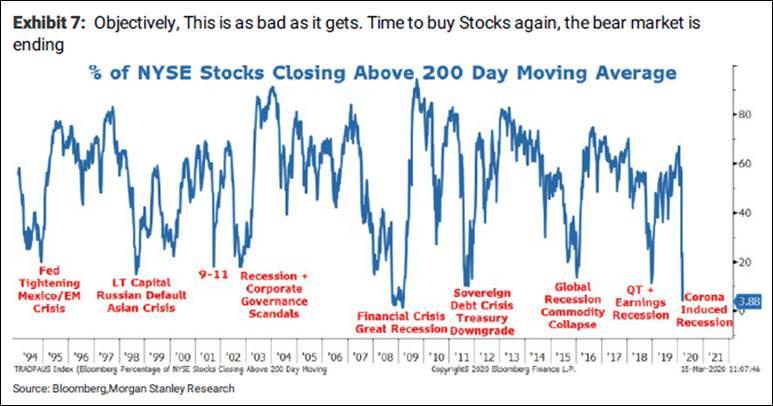

Finally, before I lay out what Clear Capital has been up to in these unprecedented times, and get too deep into the economic weeds, the markets, and our outlook, let me first express my best wishes to each of you and those in your close circles. I am not really sure how many people read these quarterly memos, or even how many get past the first page once they start, but I am sure that more than a few of you have been very directly and significantly impacted by this epidemic, and I, on behalf of everyone at Clear Capital, want to pass along our very best wishes.
I also wanted to acknowledge and thank the entire Clear Capital team, which has been working tirelessly with our residents, partners, vendors, and on-site management teams in every area of operations – communication, safety and security, leasing, revenue, expense and cash management, staffing, and resident/tenant support – as we seek to preserve capital, position our portfolio for future growth, and seek investment opportunities in dislocated markets, just as you would hope and expect from us.
So, how has Clear Capital responded to the Coronavirus pandemic?
Over the years, I have often told my students that crises, in whatever form they arrive, separate wheat from chaff. That is, in a bull market, the rising tide generally lifts all boats, new competition emerges, and returns compress. However, in times of crisis and bear markets, skills, abilities, and resources – human and financial – are severely tested, and the more capable players not only survive, but position themselves to ultimately thrive in post-crisis environments.
I recognize that all of our inboxes have been inundated with emails from everyone we have ever done business with, as firms lay out how they have responded to this crisis. I have thus far resisted the temptation to circulate such an email, under the assumption that it would soon be relegated to your email’s “deleted items” folder, lost in a sea of similar emails. But I would be remiss if I did not let you know what Clear Capital has been up to and what actions we have been taking, so let me quickly summarize how we have responded to the crisis, so that we indeed not just survive it, but are optimally positioned once it ends.
Oversight and Communication
• Implemented daily reporting protocols for each property (e.g., cash collections, leasing activity, notices)
• Initiated daily leadership teleconferences to share information and coordinate action across our portfolio of assets
• Instituted weekly property-level forecasts, in order to prepare for different economic scenarios
Safety and Security of Residents and Staff
• Modified standard operating procedures to conform with CDC guidelines
• Discontinued routine maintenance in occupied apartments
• Closed common areas (e.g., pools, gyms)
• Discontinued resident functions
• Closed leasing and management offices to foot traffic
• Encouraged team members to work remotely when and if possible
• Require staff to wear protective equipment when appropriate
• Practice social distancing
Leasing
• Pivoted to virtual leasing, by creating video tours of vacant apartments to share with prospective residents, and use of FaceTime and/or other similar software applications
• Contacted all residents scheduled to move out to encourage them to stay and extend their leases
• Reduced rental rates on expiring leases to entice renewal
• Transitioned tenant application process, lease application, and lease renewals online
Expense Reductions
• Discontinued all discretionary capital expenditure projects, including unit upgrades
• Reassigned certain tasks and services from third-party contractors to in-house maintenance personnel (e.g., janitorial, groundskeeping, painting)
• Reduced, halted, and/or discontinued all non-essential regular service contracts
• Withdrew spending authority from property managers. All purchases and expenditures require express approval
• Limited variable expenses to essential materials and services only
Staffing
• Reduced staffing levels through reductions in work hours and furloughs, but have not terminated a single employee
• Refocused staff to essential services only (e.g., leasing, resident support, and asset preservation)
• Supported key personnel by ensuring their full-time status, by sharing their available hours with other portfolio properties
Resident Support
• Assembled a team to research and become familiar with all resources available to residents (e.g., unemployment insurance and other state and local programs, SBA grants, loans and other federal programs, loans and grant programs offered by non-profit and charitable organizations)
• Created reference guides and instructions to assist residents to determine eligibility and process applications for each resource
• Created and implemented COVID-19 claims process, documentation, forms, and tracking protocols
• Proactively reached out to residents to inquire about their well-being and to offer assistance where needed
• Waived late fees and withheld eviction proceedings against delinquent residents affected by COVID-19
• Negotiated repayment agreements with delinquent residents affected by COVID-19
In short, we have been very busy, not necessarily doing things we would like to do, but things that we must do. I am confident that these endeavors will pay dividends both during and subsequent to the crisis, and again, I send my sincere thanks and appreciation to our team.
So, let’s start with an overview of recent events, as sobering as they might be
Unless you have been living under a rock and practicing social isolation as a way of life, you don’t need me to tell you that we have witnessed unprecedented economic and market contractions, and spikes in unemployment and market volatility never seen previously. In my last memo, I marveled at just how resilient the markets had been over the past decade, withstanding all the slings and arrows flung at them. But not this time. While the equity markets have recently rallied, substantially cutting year-to-date losses, all market indices are lower, and the spikes and declines in volatility, as measured by the VIX, have been unnerving.


An enemy invisible to the naked eye and a contemporaneous collapse in oil prices (oil prices hit an 18-year low on Friday) have proved a toxic pairing, and the related job losses have simply been stunning. The 9.9% and 12.3% national and California unemployment rates that we witnessed in 2009 seem like distant memories, and will pale in comparison to what the Bureau of Labor and Statistics is likely to report in coming months. 57 economists surveyed by the Wall Street Journal project that 14.4 million jobs shall be lost in coming months, and the unemployment rate will rise to a record 13.5% in June, nearly four times February’s 3.5%. While I am always skeptical of consensus, I don’t think these folks are going out on a limb. After all, this data speaks an immutable truth.
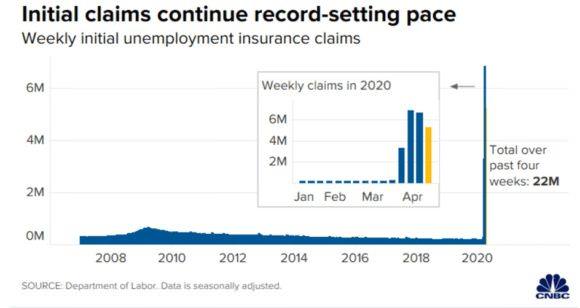
Obviously the travel, hospitality, tourist, and retail trades have been hardest hit, but white-collar job losses will not be far behind. Hopefully, some government intervention (e.g., the Paycheck Protection Program) will mitigate job losses to a degree. Meantime, Las Vegas, the Southwest Florida Coast, Orlando, and Houston, whose economies are dependent on hard-hit industries and lack industry diversification, have been and will be especially impacted.

And while a drop in consumer spending, travel, and overall economic output would provide headwinds for oil prices in any case, a Russian-Saudi Arabia standoff surrounding oil supplies could not have come at a worse time. Keep in mind that the U.S. is now an energy exporter, and the oil and gas industry is especially significant to Texas, the Gulf of Mexico, California, North Dakota, and Oklahoma. Such low energy prices would lead to significant job losses and bankruptcies in even the best of times.
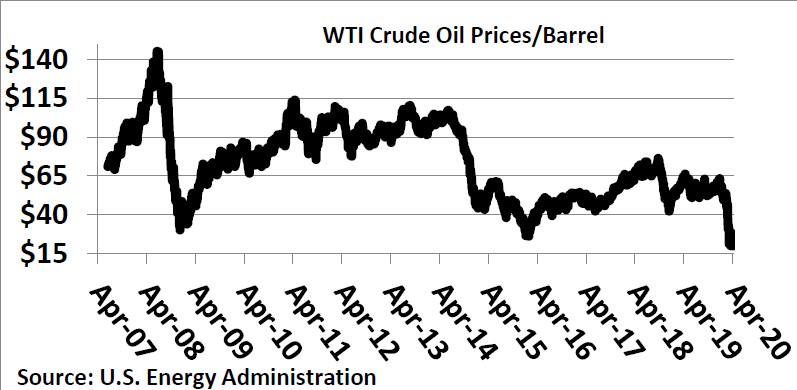
Finally, keep in mind that consumer spending makes up 70% of the U.S. GDP, and the incomparable job losses we have sustained will leave a mark, no matter the largesse of our federal and state governments. I suppose we will have to wait until the government releases March and April data before we can know for sure just how badly the consumer has been impacted.1 It is simply too early to be sure, like predicting the end of a pro basketball game based on the halftime score. However, this reality – the power and impact of the U.S. consumer – is what is providing the greatest pressure from politicians to reopen the economy.
Meanwhile, the federal government has brought out the heavy artillery to combat the economic fallout from COVID-19, and while these have stabilized financial markets in the short-run, the longer-term implications are worrisome
To say that the federal government has brought out the howitzers to offset the unprecedented economic dislocation we have witnessed would be an understatement, from CARES (Coronavirus Aid, Relief, and Economic Security Act), to PPP (Paycheck Protection Program), to $4 trillion of Fed stimulus and quantitative easing, under several different programs. In the short run, our federal government is going to print money like there is no tomorrow, with deflation the bigger near-term concern. But longer-term? What will be the efficacy of these unprecedented moves, and are we making some sort of Faustian deal in the longer-term?
In short, these questions are probably academic, as I don’t believe we have a choice, unless a second Great Depression is on the menu. I felt the same way in 2008 and 2009, while fully recognizing the same Faustian deal we arguably made back then and the moral hazards and unintended consequences bailouts and heavy-handed governmental intervention can bring. The last time our federal spending represented such a significant percentage of our GDP was during World War II.
1) Some argue (see https://www.nationalreview.com/exchequer/70-percent-myth-consumer-economy-kevin-d-williamson/, for example) that the actual percentage is less than 70%, perhaps “only” 40%, depending on how it is measured. It is sort of an academic argument, as it is extremely material in any case.

And keep in mind that Central Bank balance sheets were already bloated, sitting at record levels before this crisis hit.

The long-term implications of these extraordinary actions remain to be seen, and reasonable and educated pundits might disagree. Me? I see asset bubbles and inflation in our future, though I cannot say when that will occur. Depending on how quickly improved treatments and/or a vaccine for COVID-19 are created, the asset appreciation and related inflation which I anticipte may happen sooner rather than later.
What about real estate markets, now and looking forward?
Not surprisingly, the real estate market has also taken it on the chin, with the hospitality, retail, and office sectors being especially hard hit. Many hotel owners and retail landlords, along with many of their tenants, will not survive this downturn. Neiman Marcus and JC Penny missed debt payments this past week, and many others will likely follow suit. The list of retailers not likely to survive this crisis include not just Neiman and Penny’s, but Macy’s. Others like Kohl’s and Nordstrom’s have been drawing down lines of credit, joining a long list of companies taking similar actions. I imagine most retailers, including Kohl’s and Nordstrom’s, have six months of cash on hand, maybe eight to ten. But nobody should feel guilty or alone in their efforts to increase liquidity. Firms seeking increased liquidity are part of a very large fraternity:
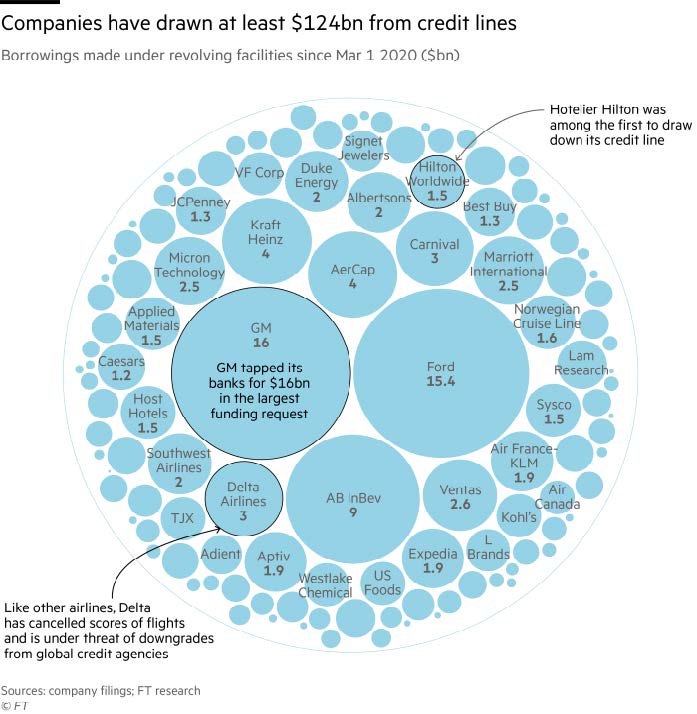
Prologis, the largest industrial landlord, indicated that 25% of its tenants have requested some sort of “rent relief,” though I suspect the industrial market will perform better than retail or office looking forward because of the continued growth in e-tailing and the likely future return of on-shore manufacturing of certain essential health care products and equipment that had previously been outsourced to China. I assume the mask, ventilator, and protective equipment markets will be quite robust for the foreseeable future, and domestic supply chains for these products strengthened.
Meanwhile, the National Association of Homebuilders/Wells Fargo Housing Market Index, based on a monthly survey of homebuilders and designed to take the pulse of the single-family housing market, plunged 42 points in April, to 30 (a 42% drop), the largest monthly decline ever. At 42, the Index stands at its lowest level since June of 2012, and represents the first reading below 50 (indicating industry contraction) since June 2014. As though the single-family residential market needed other headwinds, JP Morgan Chase just announced that it is raising its mortgage borrowing standards, requiring potential homebuyers to have FICO credit scores of at least 700 and 20% down payments at the ready. I have to believe that all lenders will be tightening underwriting standards, across every asset type, such that lower interest and mortgage rates won’t be nearly as impactful as one might think (or hope), as a result. That is, lower rates will be more than offset by higher spreads and tighter underwriting.
While multifamily assets are probably the safest place to be, they are not immune from the economic realities of job losses and furloughs, reduced wages for those still employed, and stay-at-home orders. While we have collected about 90% of April rents across our portfolio, not all assets fared equally well, of course. Moreover, we expect May’s results to be worse, simply recognizing the number of unemployment claims filed so far this month. Federal stimulus efforts will help, but can only do so much. Frankly, until the employment picture brightens, multifamily investors will feel the pinch. The drop in single-family home demand and purchases will provide some buffer and a modest tailwind, as will stay-at-home orders, boosting lease renewals.
The pressure will be greatest on lower-income households, who not only spend so much more on housing (as a percentage of their total incomes), but have minimal savings or safety nets. And in those communities where housing costs are highest, especially California, the impact will be even more widely felt. As a result, the pressures on California residents to move elsewhere for lower housing costs, will become even greater from Coronavirus, at least in the short- to near-term.
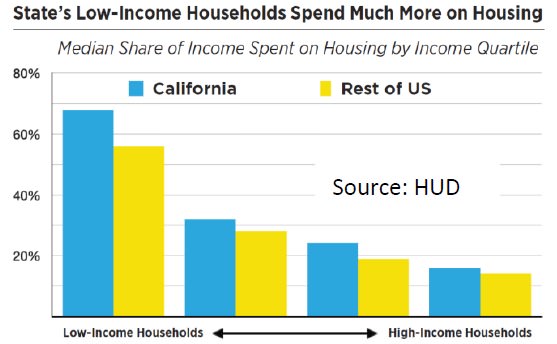
The multifamily market remains the safest and best place to invest, with the trends favoring secondary and tertiary (and don’t forget quaternary) markets well intact.
Over the past several years, I have discussed, at length, the exodus of residents from California to other states, namely Texas, Arizona, Colorado, Oregon, Utah, Washington, and Idaho. It is why Clear Capital has
mostly shifted its investment focus to these other markets. After all, the price of an identical home in California costs three times as that same home in Texas. The median house price in California is up 72% since 2009, versus a 6.5% increase in median household income. With routine shortfalls in housing construction, due to everything from excessively burdensome regulations to NIMBYism to a scarcity of land to high costs of doing business to labor shortages to an ever-growing homeless population, California will continue to see residents depart for other states. Recent events will only increase motivations to leave. I found this simple picture to be sadly informative.
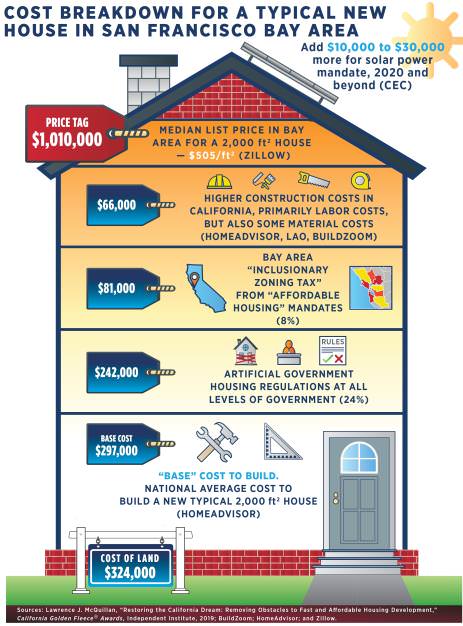
Therefore, I anticipate that we will continue to pursue investment opportunities in places where California residents are headed. These two pictures speak quite directly to the exodus of Californians, all pre-COVID-19.
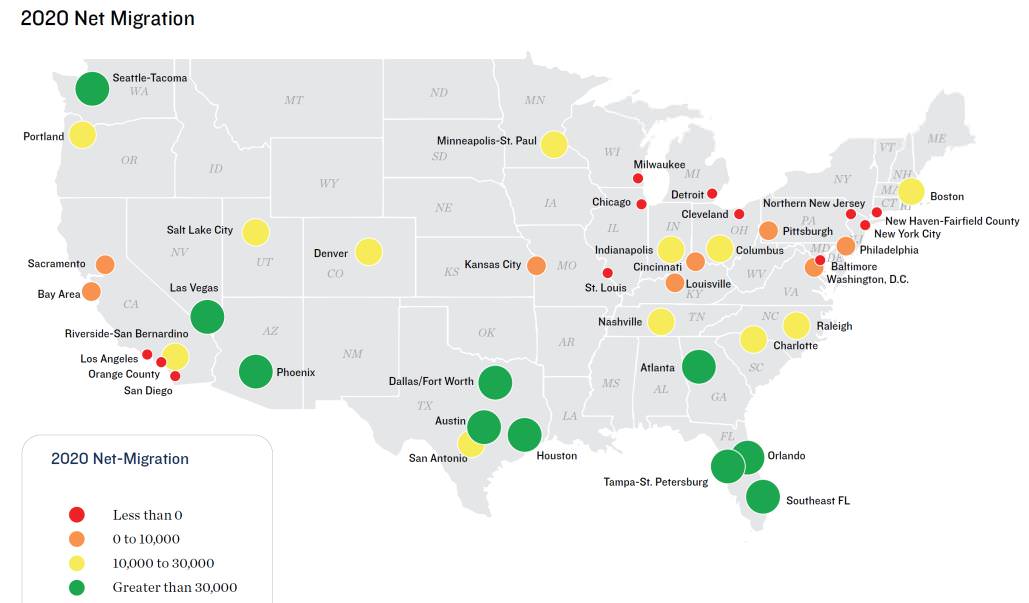
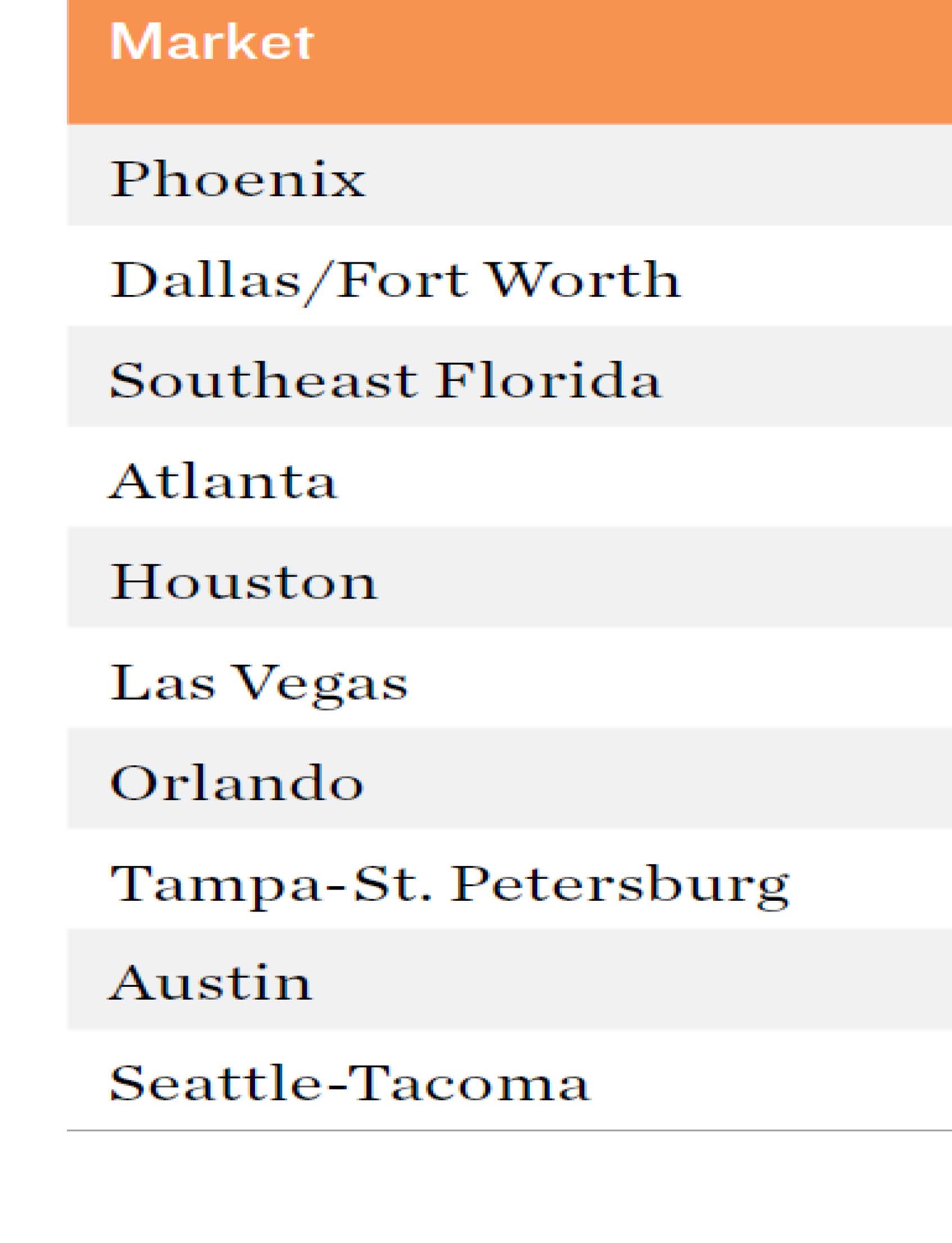
I recently came across one other interesting tidbit, and that is a look at which states have seen the largest changes in “Adjusted Gross Incomes” over time, as reported to the Internal Revenue Service on personal tax returns. Granted the data is from 2012 to 2018, but it is nevertheless entirely consistent with other data and trends. California and New York have seen the highest outflows, while Florida, Arizona, and Texas, the greatest inflows.

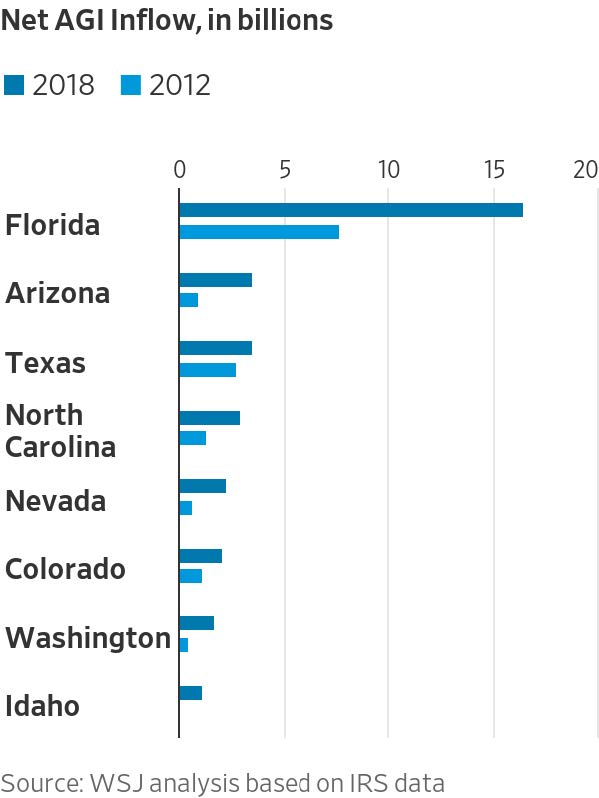
Finally, I read an interesting article in the (failing!) New York Times about how this population exodus from California is impacting politics in neighboring states. The 7.3 million people who have left California since 2007 have turned Colorado blue, likely resulting in a flipped senate seat. In Nevada, Democrats won the governor’s mansion and a second senate seat in 2018. And last, but certainly not least, Arizona may turn blue in short order. Texas, the top state for California’s diaspora, is in play, though the State is not likely to turn blue quite yet. But Democrats are growing their influence in major metros like Dallas, Austin, Houston, and San Antonio, and the overall trend cannot be ignored.
And multifamily rents? Between economic and political pressure/activism, they are likely to drop in the short-run, especially in those regions with high “at risk” employment and high housing costs. However, they will likely continue to rise, longer-term
Over the last decade, multifamily rental growth, nearly anywhere you looked, was robust. In certain markets, especially on the coasts, the growth rate far outpaced inflation. However, more recently, it has been the secondary and tertiary markets that have shined, as residents fled the coasts in search of better job opportunities, lower housing costs, and higher net wages, as described above. Markets like Phoenix, Aurora and Colorado Springs, the Inland Empire, and Boise have led the pack in terms of rental growth.
So, what now? In those markets with average levels at-risk jobs, I actually expect rents to remain fairly flat in the short-run, as residents mostly stay put, remain in whatever job they might have (as opposed to relocating), receive stimulus and unemployment checks, and fail to buy homes. Over the next year, however, I do expect rents to decline, though modestly, mainly due to job dislocations and additional supply delivered to the market. There will be new projects coming on-line (some 330,000 units in 2020), and some residents will be doubling/tripling up and/or moving back home with parents, trends we witnessed during the Great Recession. It is really a question of how quickly the economy and job markets rebound.
In some markets, those with especially high levels of at-risk jobs, such as Las Vegas and Orlando, all bets are off, quite frankly. It is why I would avoid any market with excessive single-industry exposure, or a significant lack of employment diversification. Last year, for example, we evaluated a portfolio of multifamily assets in Midland, Texas. The purchase cap rate and buy-in were far more attractive than what we typically see cross our desks (or emails). But given the unique exposure that market has to the oil and gas industry, we did not pursue the acquisition, a prescient decision in hindsight.
One significant unknown is how lenders will reprice and restructure both existing and new loans
How real estate assets are ultimately repriced as a result of this crisis depends, to a significant degree, on how lenders respond. Obviously, innumerable outstanding loans will need to be restructured, mostly involving deferred payments and maturities, and waivers of certain fees and costs. Presumably, for most assets, such modest modifications will do the trick, provide time for the markets to recover, and allow borrowers to satisfy their obligations. In other cases, perhaps loans on certain hotel and retail assets, more dramatic and draconian actions will need to be taken, with assets needing complete or partial do-overs or redevelopment.
As expected, the Federal Housing Finance Agency, which oversees Fannie Mae and Freddie Mac, the largest residential lender, is offering forbearance of loan payments for up to 90 days, if borrowers can demonstrate that they have been impacted from COVID-19 and agree to suspend evictions of affected tenants. I have yet to see the formal forbearance documentation to understand the precise terms and conditions attached to any forbearance, perhaps because we have not yet requested any. At the end of the day, nearly all lenders, including banks, insurance companies, and debt funds will be motivated to work with and modify loans if the underlying assets and underlying fundamentals are solid, and borrowers, trustworthy. Workouts of CMBS loans will be trickiest, as they always are, due to the manner in which these loans are securitized and require the involvement of special servicers.
For new projects and investment acquisitions, I suspect most lenders will require additional reserves, employ stricter underwriting processes and procedures, resulting in lower loan-to-values, higher debt service ratios, immediate amortization (no interest-only), with lower rates on underlying indices, as seen below, offset by higher credit spreads. These restrictions should ease in time, but markets like these create dislocations everywhere.

What’s interesting is that before the virus hit the fan, all real estate lenders were active. Obviously, we will just have to see how this data from the fourth quarter changes throughout 2020.
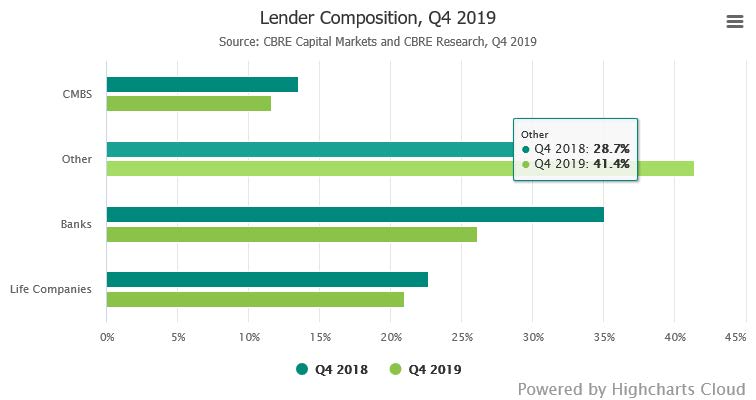
And finally, I sure was wrong when I predicted that 2020 would be a quieter year in terms of public policy initiatives and housing. If anything, COVID-19 has fanned the housing regulation flames
I suppose the one area in which I should just stop making predictions is politics. I honestly thought that after politicians were so busy in 2019, extending efforts to almost nationalize several residential housing markets, they might take a breather in 2020. Wrong. Maybe I should have hired the Houston Astros bench players and coaches to help me make better predictions. Obviously, much of the recent political machinations are responses to the Coronavirus. This simple map provides a bird’s eye view of what happened before 2020.
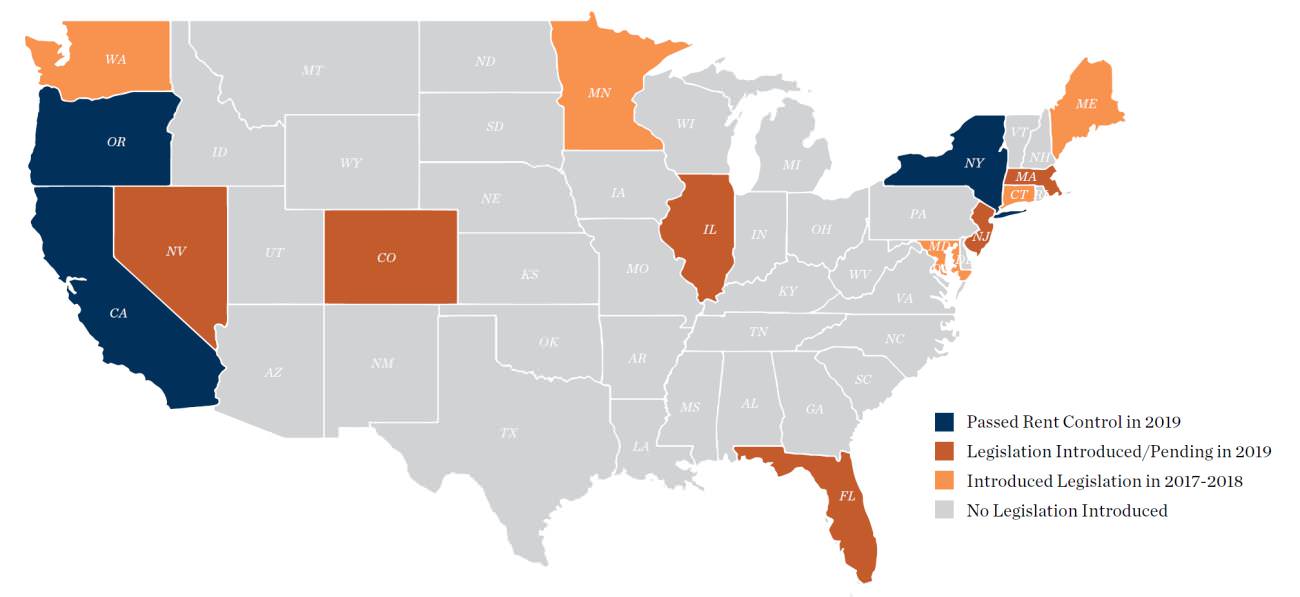
With that backdrop, allow me to provide a summary of what different cities and states have been up to this year:
• Countless cities and states have passed emergency legislation to protect residential tenants from being evicted, if they are unable pay rent because of the Coronavirus. These include Arizona, California, Illinois, Kansas, Louisiana, Massachusetts, New York, among several others, both red and blue. Practically speaking, because unlawful detainer courts are closed everywhere, actually processing evictions would be hard, if not impossible. In addition, the CARES Act put a 120-day national eviction moratorium for tenants in properties that are part of government programs or that have a federally-backed mortgage loan.
• California Assembly Bill 828, if passed, would establish a moratorium on evictions and foreclosures while a state of emergency related to COVID-19 is in effect, and until 15 days after that state of emergency has ended. And if this were not restrictive enough, tenants impacted by COVID-19 and subject to an unlawful detainer action, would be entitled to reduce their rent by 25% for a year. While seemingly unconstitutional on its face and unlikely to pass, I would think, such heavy-handed tactics scare the bejeezus out of me.
• Meantime, and ironically, California once again shot down a bill (SB 50), which would have allowed more mid-rise apartment buildings near transit and job centers. The Bill failed to pass because it took too much power away from local governments, those same local governments that have essentially done squat to meaningfully address housing shortages. California should be building 250,000 housing units a year, plus or minus, and yet we are producing less than 100,000. No wonder the exodus from the state continues. There is no monopoly on myopia or stupidity.
• Before COVID-19, Utah was considering statewide rent control, as were the cities of Seattle and Atlanta.
• Also prior to the arrival of COVID-19, the mayor of San Francisco was pushing a ballot initiative to streamline approval of 100% affordable projects or where developers agree to set aside 15% additional units as affordable above what would be required. On Super Tuesday, San Francisco passed a ballot measure to charge a “vacant storefront tax,” a tax on commercial storefronts that remain vacant for at least six months, which sounds both absurd and illogical. Let’s take a group of landlords, already struggling financially with vacancy (assuming these landlords have been unsuccessful in finding commercial tenants) and tax them! Yet, in a surprise to absolutely nobody, the measure passed with almost 70% voting in favor of it. Being a landlord in the Bay Area must feel like what it feels to be a UCLA football fan in recent years.
• Oregon’s governor, Kate Brown, and the state’s lawmakers are considering adding transfer taxes to real estate transactions to pay for affordable housing.
And across the Pond, Berlin’s five-year freeze on residential rents (“Mietendeckel”) went into effect this quarter. In addition, the new law will allow renters paying more than $10.80/sq. meter to petition the city to force landlords to reduce their rents. As bad as California and New York might be, I am not sure there is a place anywhere which dislikes its residential landlords more than Berlin. In some very perverse economic thinking, supporters of the new bill indicated that it will give renters time for supply to “catch up” to demand. From Spain to Toronto, renters are feeling the pinch of higher rents caused by urbanization and the failure of supply to meet demand. According to the Economist, 68% of the world’s population is expected to reside in urban areas by 2050, up from 55% today, so these challenges are only going to worsen over time, and anti-landlord sentiment and pro-tenant legislation are sure to follow.
In closing, while the COVID-19 crisis has presented us all with unique and unprecedented challenges, I remain optimistic about our ability to confront them, persevere, change, and grow.
I believe it was Teddy Roosevelt who said that “nothing worth having comes easy.” I am not sure I believe this to always be true (just ask a Super Lotto or PowerBall winner!), but it sure rings true today. Crises have a way of inducing fear, panic, and gratitude, all at once. I am, by nature, a “glass half-full” sort of individual, and while this crisis has been extraordinarily difficult and disruptive, I am truly grateful for friends, family, our Clear Capital team, our partners, and investors, and of course, our collective good health. I reiterate my sincere well wishes to you all, and hope that my next memo will celebrate an end to social isolation and a return to greater normalcy, in whatever form such normalcy may take.
Meantime, we will continue to evaluate investment opportunities, believing that market dislocations and crises always present opportunities, so please stay tuned.
Best,

Eric Sussman
Founding Partner
“If all the economists were laid end to end, they’d never reach a conclusion.”
-George Bernard Shaw“Prophesy is a good business, but full of risks.”
-Mark Twain
First and foremost, on behalf of the entire Clear Capital team, allow me to express my very best wishes to each of you and your families for a happy, healthy, and prosperous 2020. We had a busy, productive, and successful 2019, and we hope to carry this momentum into the New Year and beyond.
Over the past year or two, I have quoted everyone from Jerry Garcia to PT Barnum to Rod Serling as I have endeavored to reconcile the seemingly contradictory and confounding data points that the economy, investment markets, and national and geopolitical environment have provided. Yet, despite all the uncertainties and risks, nearly every investment vehicle – equities, bonds, commodities (e.g., oil, gold), and residential and commercial real estate – performed very well in 2019. The S&P 500 returned nearly 29%, its best performance since 2013, and all 11 sectors comprising the Index finished in the black. Oil, gold, and bonds achieved double-digit returns.
Even U.S. Treasuries, which tend to decline when risky assets rally, generated positive returns during the year, as the Fed cut rates three times. And if you had any doubt how good a year 2019 was, consider that Greek 10-year bond yields dropped in half (to 2.05%!). So instead of PT Barnum, perhaps I should quote Pangloss, as it truly seems to be “the best of all possible worlds,” at least when it comes to recent investment returns. Significant liquidity and low interest rates are indeed formidable and impactful dance partners.
Taking a longer view, U.S. stocks returned 252% during the last ten years, and for the first time, an entire decade passed without a bear market or recession. That is not to say that there have not been some fireworks along the way. During the last decade we experienced six separate market corrections (declines of at least ten percent), the May 2010 “flash crash,” Europe’s sovereign debt crisis (2011-2012), the devaluation of the yuan, the Arab Spring, global trade wars, Brexit, Trump and impeachment, negative interest rates and inverted yield curves, riots in Hong Kong, the implosion of WeWork, Australian wildfires, a couple royal weddings (pre-Megxit!), the closure of tens of thousands of brick-and-mortar retail locations, and even a total solar eclipse. The financial markets more than withstood each.
However, plenty of risk, uncertainty, and conflicting data points remain. For example, while labor markets may be buoyant, retail sales strong, and inflation tame, domestic and global GDP growth is tepid and manufacturing data mixed, while trade tensions persist, the federal deficit topped $1 trillion for the first time in seven years, and even more brick-and-mortar retail locations seem to close each week. Furthermore, the Fed has signaled that no additional interest rate cuts are in the cards, at least for the near future. Washington remains as dysfunctional as ever, with impeachment proceedings and the fallout from the recent bombing in Iran increasing macro-level uncertainties.
My biggest concern is that investors, desperate for yield in a very low (and in some cases, negative) interest rate environment, have become complacent, and may not be properly pricing risk. The reality is that it is easier to find Sasquatch or political compromise than yield these days, and some investors seem to be ignoring macro-level risks. The Volatility Index (VIX) remains at near-term lows, while the price-earnings ratio of the S&P 500 has increased to more than 24 times earnings, up from 15 at the end of 2018. A mere five companies (Apple, Microsoft, Google/Alphabet, Amazon, and Facebook) make up nearly 20% of the entire market capitalization of the S&P 500, an unprecedented level of concentration. The ten largest stocks in the Index account for nearly a quarter of its value. Interest in and capital flows to secondary, tertiary, and in some cases, quaternary (first time using that word, best I can recall) real estate markets have increased significantly, reaching record highs.
So what were the most significant events from 2019 that impacted real estate (and other) markets? Which might have the greatest impact on markets looking forward?
In the spirit of the cinematic awards season, here are the nominees for “Most Impactful Event on U.S. Commercial Real Estate Values” from 2019, in no particular order:
- Implosion of WeWork (Adam Neumann, Producer): With 528 locations in 111 cities across 29 countries and over 12.2 million square feet of leased space, WeWork has been an extremely active player in core office markets. For example, WeWork is now the largest private tenant in all of New York City. The company will clearly be consolidating and cost cutting this year (and perhaps beyond), and many office assets and markets will be affected, though the ultimate fallout remains to be seen.
- Sharp decline in foreign investment activity (Numerous Countries, Producers): In the first half of 2019, cross-border commercial real estate investment dropped 54% from the prior year, reflecting global uncertainty and capital constraints. In fact, cross-border investors became net sellers of U.S. commercial real estate in the second quarter of 2019 for the first time in seven years. One need only look at New York City where nearly half of the Manhattan luxury-condo units that have come onto the market in the past five years are still unsold, according to The New York Times, as developers bet big on foreign plutocrats—Russian oligarchs, Chinese moguls, Saudi royalty—looking to buy their second (or seventh?) homes. Those bets appear to have been losing ones. While 2020 should be stronger as the U.S. remains a safe(r) haven and is still growing faster than other regions, I doubt foreign investment in the next year or two will match the substantial activity we witnessed in the latter part of the last decade. Reduced foreign investment will affect nearly every property type, mostly core assets in primary markets.
- Fed’s reversal on interest rates (Jerome Powell, Producer): In 2019, and to the surprise of many, the Fed lowered rates three times, reducing the Fed Funds rate 75 basis points (to 1.50%), the last time in October. However, while the Fed has signaled that no further rate cuts are in the cards for at least the near term, I recently read that UBS predicts that there could be as many as three additional rate cuts in 2020, in light of slowing economic growth and the impact of trade tariffs. Others say the Fed will stand down in an election year. We shall see.
- Passage of statewide rent control in California, Oregon, and New York (Gavin Newsom, Kate Brown, Bill de Blasio, Producers): As I have described in prior updates, local and state governments have been pulling different levers in order to address housing affordability. Three states implemented statewide rent control during the year, and more may soon follow. While these efforts are destined not to succeed, in my view, I do not expect politicians to pursue alternative (and probably more effective) approaches any time soon. They lack the resources, both financial and political, to do so.
If I had to add one other nominee to the aforementioned list, it would have to be the 2.1 million jobs that were added during 2019. However, these results were not a 2019 phenomenon as we have now witnessed ten years of job gains, including 2.8 million new jobs in 2018. Regardless, such a noteworthy data point at least deserves an “honorable mention.”
Unfortunately, Price Waterhouse Coopers was not available to count ballots and determine the victor, so we will have to declare a four-way tie for now. Perhaps a clear winner will emerge sometime this year or next.
So, with all this being said, what should one expect in 2020?
I recall someone telling me once that when there is broad consensus about something, it is likely that something else altogether different will occur, though I am not sure if there is any academic research to support this platitude. However, with U.S. equity markets now having experienced the longest and least volatile bull market in history, and nearly every economic pundit not anticipating a recession this year (or even into the first half of 2021), one with a longer view of history has to be wary. Recession fears have significantly abated, and the UCLA Anderson forecast believes there is a less than 20% chance of a recession through the third quarter of 2020, consistent with the model below, courtesy of Morgan Stanley.

While mindful of the dangers of joining any consensus (I would hate to join any club which might have me as a member, to channel Groucho Marx), I tend to agree with the view that a recession this year seems unlikely, simply based on the strong fundamentals underpinning the markets: low interest rates, significant liquidity, low unemployment, and tame inflation. The $3.4 trillion in cash sitting on the sidelines (highest level in a decade) remains a downside buffer. I find these two graphs, presented side-by-side to tell the story quite simply. While the S&P 500 has risen sharply, so have cash reserves, measured in part by the growth in assets in Money Market Funds.

As I mentioned in the last quarterly memo, Blackstone recently raised their largest real estate fund (over $20 billion) and Goldman Sachs has reentered the real estate fund game. In fact, real estate fund managers raised over $150 billion in 2019, a record. All that additional equity awaiting investment should also prop up commercial real estate values, or at least create some downside cushion in the event of a downturn or significant decline in asset prices.
However, investor and market psychology can turn very quickly, and the broad complacency extant in the markets is concerning, given the uninspiring growth in GDP here and abroad, recent market returns and valuations, the continued reshaping of the retail landscape, and substantial political and geopolitical risks. Investors are well served by reducing leverage and maintaining adequate liquidity in markets like these, and I think such an approach is especially prudent today.
Meanwhile, the most significant issue in residential real estate will continue to be “affordability,” as prices and rents continue to rise and outpace inflation
The statistics surrounding affordable housing are sobering, if not staggering. The U.S. has a shortage of at least seven million homes for the country’s lowest income households, and less than 40 affordable homes exist for every 100 extremely low-income households. Since 1990, the market has lost more than 2.5 million low-cost rental units and rent growth has substantially outpaced wage growth and inflation. For example, during the last decade, rents in Los Angeles and nationwide increased roughly 65% and 36%, respectively, outpacing growth in household income (36% in Los Angeles, and 27%, nationwide). Homelessness plagues nearly every city, and here in Southern California, one need not look very hard to see the pervasive impact of constrained housing supply.
The underlying causes are several-fold, but the challenges of building in supply-challenged markets remains the most significant impediment to greater affordable housing. Developers consistently rank NIMBYism (“Not in My Backyard”) as the largest barrier to construction. The largest markets where building is “easiest” include Cleveland, Milwaukee, Chicago, Dallas, and Houston. To be candid, we have experienced the impact of easier entitlements in our Dallas/Fort Worth portfolio, as projected rental growth has been lower than projected, though I anticipate supply growth will moderate substantially over time with increasing land acquisition and building costs, and rents will rise substantially in time. The low inventory of homes for sale nationally sits at its lowest level in 37 years (adjusted for changes in population), and only adds to the demand-supply imbalance.
Not surprisingly, many California markets rank highest in difficulty of adding supply. It has gotten so bad that the private sector has had to shoulder more of the burden. Apple recently announced that it is committing $2.5 billion to affordable housing in the Bay Area, following the lead of Alphabet/Google and Facebook, which have similar, though more modest, $1 billion commitments. Microsoft has committed to invest $750 million to Seattle housing. However, a lack of capital is merely one impediment to adding to the affordable housing stock. It is incumbent that local and state politicians simplify zoning regulations, reduce bureaucracy, and accelerate the entitlement process to promote construction and increase housing supply. Meantime, the affordable and workforce housing shortage is not limited to primary markets like the Bay Area or Seattle. Supply-constrained markets are spread throughout the country. Secondary and tertiary markets such as Austin, Charleston, and Raleigh are also experiencing a significant need for more supply as residents struggle to find affordable housing.
Rising construction costs are not helping the cause, of course, nor the fact that most multifamily housing building during the last decade was Class-A, and not targeted towards working-class households. Fortunately, construction material costs remained fairly stable last year, despite the ongoing trade tensions. Lumber prices actually dropped, declining about 10%, after an 11.2% rise in prior year. Gypsum (wallboard) costs dropped 8.0%. However, the persistent, longer-term trend has been quite different, and a shortage of construction labor and contractors (both general and subs), coupled with glacial approval processes are not helping the cause. Lenders remain bullish on apartments and seem more than willing to fund new construction, but prospective projects are getting harder to pencil, and lower interest rates can only do so much.
The net result is that multifamily rents will continue to increase, though at a slower pace. Through the third quarter of last year, rents in 79 of the 82 markets tracked by REIS experienced increased rents. Effective rents nationally grew by one percent and 0.5% in the third and fourth quarters of 2019, respectively, the lowest growth rates in more than two years. Net absorption of 21,500 units was less than half of that experienced in the third quarter, and 30,159 units were completed, about sixty percent of third quarter activity. Overall occupancy among multifamily assets nationally has remained between 95 and 96%.
Secondary, tertiary, and even quaternary markets will be the primary beneficiaries of increased housing costs, the sort of markets Clear Capital is focusing on to source potential acquisitions
In 2019, the best performing multifamily markets, measured by annual rent growth, did not include a single core or primary market. Instead, cities like Midland-Odessa (TX), Pensacola (FL), Las Vegas, Phoenix, and Wilmington (NC) dot the list, locales with strong employment and job growth. As discussed many times before, companies are relocating to these markets from more costly primary markets, and employees follow suit. Another source I read identified “Boomtowns in America,” based on the fastest-growing cities in terms of population and economic growth. The largest markets making the list were Miami and Denver, but Longmont, Colorado is the BCS Champion of this particular list, with appropriate apologies to LSU’s Tigers.

In mid-November, the LA Times published an article, “California Exodus Makes Waves: Boise’s mayoral race is a referendum fueled by those from the Golden State.” One sentence from the article captures the tension between core and secondary markets: “Candidate Wayne Richey ran on a very simple platform: Stop the California Invasion.” One local Boise newspaper article likened California transplants to a “plague of locusts,” putting things in biblical terms. While California’s experiences record low growth rates, population outflows, reduced household formation, and lower immigration, tertiary markets like Boise and Longmont are the principal beneficiaries (or perhaps the opposite, if one thinks locusts a nuisance) of the trend.
While these smaller markets may present additional risks, the vacancy rates in secondary and tertiary markets are actually less than one percent greater than vacancy seen in core markets. With these risks, however, come stronger cash flows. Cap rates average 150 to 200 basis points higher in secondary and tertiary markets than in primary markets. Not surprisingly, more than half (55%) of multifamily properties bought in 2019 were located in secondary and tertiary markets, up from 43% ten years ago. While apartment vacancy in core markets has dropped to 3.4% from 5.4% a decade ago, the decline even more pronounced in secondary and tertiary markets, from 7.2% to 4.8%. Obviously one has to be especially mindful of the risk-reward tradeoffs and perform due diligence accordingly when evaluating acquisition opportunities in such markets.
With all of this being said, it will come as no surprise that the faster-growth secondary and tertiary markets are where we are evaluating potential acquisition candidates, in our belief that most opportunities in core markets simply do not pencil.
But finding value in any market – primary to quaternary – remains no simple task
With so much investable cash sitting on the sidelines, and investors searching far-and-wide for yield, it should come as no surprise that the first three quarters of 2019 witnessed higher multifamily sales volume (nearly $131 billion) than any comparable period in the last ten years. REITS were particularly active, having spent $7.1 billion on apartment acquisitions, the most they have acquired since 2014 and more than all of what they spent in 2018.


Meantime, while overall volume of cross-border investment in U.S. real estate has declined and slowed, as described above, apartments remain popular destinations for foreign capital. Cross-border investors spent over $16 billion on apartment property acquisitions during the 12 months ending in June of last year, a 10% increase. The biggest buyers, by far, have been Canadian investors.

The net impact is that substantial capital is seeking opportunities in the multifamily space, and finding value is no easy task. Each week the Clear Capital underwriting team is underwriting between 20 and 25 opportunities, in markets across California, Arizona, Colorado, Utah, New Mexico, Texas, Ohio, and Florida. We hope that our casting a wide net in markets we find attractive will ultimately pay dividends.
Low interest rates should persist well into this decade, meaning the chase for yield will continue
If a single picture can tell a thousand words when it comes to what has happened with interest rates both here and abroad over the last decade, perhaps this is it.

While yields on 10-year U.S. Treasuries were volatile in 2019, they ended the year at 1.92%, as compared to 2.66% at the start of the year, and 1.68% at the start of the fourth quarter. In mid-December, after reducing interest rates at its three previous meetings, the Fed voted unanimously (10-0) to leave the Central Bank’s benchmark rate where it presently stands (1.75%), and indicated that it would take an indefinite breather on reducing rates further.
The Fed’s statement comes as no surprise, given asset values, recent market performance, and low unemployment. On the other hand, GDP growth remains uninspiring and inflation remarkably subdued, with the CPI-U up a modest 2.3% in 2019 (0.2% in December). Perhaps this is why UBS is predicting that the Fed could lower interest rates three times in 2020, in contrast to other banks and prognosticators. Meanwhile, the previously inverted yield curve has quietly “uninverted,” another indicator that perhaps a recession is indeed not in the cards.
The biggest question mark is whether the Fed can use its usual monetary policy toolbox to combat a recession, should one arise. After all, the Fed already holds about $3.8 trillion in assets which still includes bonds purchased to stimulate the economy following the 2008 global financial crisis. As mentioned in my last memo, the Fed has recently had to purchase short-term treasuries and inject cash to alleviate reserve shortages in the banking system. How many bullets does the Fed have left in its arsenal and how effective will those bullets be in the event that we experience a meaningful downturn? That remains to be seen.
As mentioned, these low interest rates are, in part, a byproduct of uninspiring GDP growth, here and globally, so the message is mixed
Real U.S. economic growth slowed in the third quarter of 2019 to a whopping 1.9%, reflecting the impact of the tariffs and a decline in consumer spending, which was up 2.9% (versus 4.6% in the second quarter). Keep in mind that consumer spending typically constitutes 70% of GDP growth.

Meantime, I recently read an interesting piece from Stanford’s Institute for Economic Policy Research, which has created a “World Uncertainty Index,” a broad metric (143 countries) to measure “global views on uncertainty” in the view that “uncertainty” creates a drag on investment and economic expansion. Their most recent results and conclusions align with those of the IMF, that global economic growth will be 3.0%, the slowest growth rate since the end of the global crisis and down 0.3% from forecasts made earlier in 2019.
But the employment picture here in the U.S. continues to shine…mostly
The U.S. added 145,000 jobs in December, marking the longest stretch of annual increases in employment in 80 years, a truly remarkable data point. An alternative measure, which captures the “underemployed” and those “marginally attached to the workforce,” the U-6, fell to 6.7%, the lowest figure on record since 1994. Ironically, the share of adults working or looking for work held steady in December at 63.2%, but remains well below the peak of 67.3% in 2000. In one dark spot, wages advanced only 2.9% from a year earlier, the smallest annual gain since July 2018. This most recent data on wages is a little sobering because October’s wage growth (3.8%) eclipsed the average fixed rate, 30-year mortgage rate of 3.7% for the first time since 1972. However, that achievement sure did not last long.
In any event, this conundrum, an economy experiencing more than “full employment” and yet, minimal real wage growth, will continue to affect everything from multifamily rents to politics to GDP.

Job Growth by Decade

One other employment tidbit I read recently is that the most common occupation for American males lacking a college degree is as a driver – truck, taxi, bus, and/or Uber/Lyft – jobs which may ultimately be replaced with Level 5 autonomy (self-driving cars). While I suspect this remains at least a decade away, it is at least worth noting as we look into the labor markets of the future.
Of course, I would be remiss if I did not at least pass on a few tidbits about the public sector’s efforts to further regulate housing markets
At the risk of sounding like a broken record (or perhaps a corrupted Mp3 file), here are some noteworthy recent anecdotes from the annals of public sector efforts to further regulate housing markets and tackle the “affordability crisis”:
- In late November, I read an LA Times article, “Rent Fears Scuttle 577-Unit Project,” about how planning officials rejected a high-rise (six story) residential housing project in South Los Angeles because of “gentrification fears” surrounding “market-rate” housing. The project was rejected even as developers made a last-minute offer to designate 63 units as “affordable,” charging below-market rents. In a telling quote, one of the Council members voting against the project said, “If the current residents cannot afford it, we should not build it.” I can certainly appreciate the sentiment, but it essentially ensures that no meaningful housing will be built, affordable or not, without significant financial incentives from the public sector. After all, where is developable, high-density, housing able to be built and needed? Beverly Hills? Keep in mind that the proposed project was consistent with local zoning ordinances, adjacent to two light-rail lines, and therefore “transit-oriented.” It is truly no wonder that Governor Newsom wants to take control of the project permitting process, ensuring that should a project comply with local zoning laws, it must be approved. Stay tuned and have your popcorn ready.
- In early December, the Los Angeles City Council approved a ban on donations from developers, limiting the ability of real estate developers to donate to campaigns of City Council members, mayors, or city attorneys, while the City weighs key approvals for any of their projects, including zone changes or similar issues. Opponents wanted an outright ban on donations from developers.
- A Portland suburb is about to vote on new law that would tax anyone who demolishes a home ($15,000), with funds used for maintenance of local parks. I am not arguing that maintenance of local parks is not important, but it seems far less important than homelessness or the “affordable housing crisis.” Moreover, such taxes may mean less development of new housing, at least on the margin.
I suspect that 2020 will bring fewer headlines regarding real estate regulation than we saw in 2019…thankfully. I suppose this means these memos might be shorter, and that is not all bad. However, let’s not kid ourselves. The longer-term trend towards increased public sector intervention is clear and will be ongoing.
And finally, a few additional data points or newsworthy items worth noting…
- The Senior Housing market has cooled: While the broad trends appear very favorable for senior housing with Baby Boomers (folks born between 1946 and 1964) representing one in five Americans, the senior housing market has cooled off lately, in part because of technologies allowing seniors to stay in homes longer than ever before (e.g., sensors responding to various medical conditions, flexible housing fixtures). Senior housing occupancy rates dropped in the third quarter of 2019, to 88%, as compared to 90.2% in the fourth quarter of 2014. Meanwhile, a recent article in the WSJ, “OK Boomer, Who’s Going to Buy Your 21 Million Homes,” discussed how aging Baby Boomers are going to need to sell their homes in the coming years, but these homes are not necessarily located in markets or locations where younger families want to buy. According to the article, some 9.2 million homes in the U.S. are expected to be vacated by seniors through 2027 (21 million, in total, through 2037). Hardest hit will be retirement communities in places like Sun City, Arizona, or Delray Beach, Florida, and the Rust Belt, which have aging populations where young people probably do not want to live, all else equal. The precise impacts remain to be seen, but it is an interesting phenomenon worth tracking.

- Apartment sizes have shrunk over the last ten years: As developers build more new apartment buildings in busy urban areas, they are focusing more on studios and one-bedroom units to meet the needs of the market, principally unmarried individuals and childless couples. These smaller units are most commonly found in the urban cores of California, the Northwest, and Northeast. In buildings developed since 2010, new apartments have averaged approximately 940 square feet, down from roughly 1,000 square feet built previously. In California, the “shrinkage” has been most dramatic (858 square feet from 974 square feet).
Even if it were not an election year, 2020 should provide plenty of interesting story lines. The biggest question is whether the markets and economy can continue their unprecedented run
Whether we like it or not, we will find it nearly impossible to ignore the 2020 news headlines, whether political or economic. While the upcoming election and impeachment news will inevitably bombard us at every turn, I will mostly be interested in economic news and whether this unprecedented run we have experienced in the markets is sustainable. The S&P 500 is already up over 3.0% thus far in 2020, but three weeks in January do not a year make, especially in an election year.
While I remain optimistic that we will not have a recession this year, I still expect greater market volatility and remain cautious. Maybe that is one of the things I like most about multifamily assets, as they are more of a longer-term macro bet on housing and demographics, which I find
easier to evaluate and predict than what the equity markets might do this year. Regardless, no matter what 2020 brings, we will stay the course, remaining the best stewards we can be for the capital you have entrusted with us. Finally, for those reading this newsletter for the first time, feel free to contact us at clearcapllc.com if you would like to be added to our mailing list. You will receive all future newsletters and information on any future investment offerings.
Thank you, again, for your support, for which we are profoundly grateful.
Best,

Eric Sussman
Founding Partner
“If you have to forecast, forecast often.”
- Edgar Fiedler
“An economist is an expert who will know tomorrow why the things he predicted yesterday didn’t happen today.”
- Evan Esar
As I reflect back on the recently concluded third quarter, I would like to start by engaging you in a simple thought experiment. Imagine that you emerged from hiding on October 1st after a three-month vacation on a deserted island in the Pacific, and someone handed you the following list of data points from the most recent quarter. After you had a chance to peruse the list, they asked you to predict how the domestic equity, bond, and real estate markets fared during the period, in light of what you had reviewed. Here is the list:
- Impeachment proceedings against a U.S. President commenced for only the fourth time in our nation’s history
- The September U.S. Manufacturing Survey (the Purchasing Managers’ Index from the Institute for Supply Management) had its worst showing (47.8%) since June 2009, and its second consecutive month of contraction, a decline from 49.1% (any reading below 50% is indicative of economic contraction)
- The New Export Orders Index (also published by the Institute for Supply Management) was only 41%, its lowest level since March 2009
- Job growth slowed in September (135,000 new jobs added versus 168,000 in August, 223,000 in the same period in 2018, and forecasts of 145,000 new jobs), while wages rose just 2.9% (year-over-year), the lowest rate of increase in over a year
- California passed statewide rent control, joining Oregon and New York in this select (read: auspicious) group
- The Fed embarked on this decade’s first rate reduction “cycle,” with two 25 basis point cuts to the Federal Funds Rate
- In August, the yield curve completely inverted, with all maturities of treasury securities yielding less than that same Federal Funds Rate
- In mid-September, the Fed implemented “temporary operations” to relieve short-term stresses and soaring borrowing costs in the short-term funding markets (money markets) for the first time since 2008
- Brent and WTI (West Texas Intermediate) crude oil prices declined 8.5% and 5.8% during the quarter, respectively, despite attacks against Saudi Arabia’s oil infrastructure
- WeWork was forced to scrap its highly anticipated initial public offering, seeing its most recent valuation of $47 billion (from its last capital raise) evaporate to near insolvency in weeks, the latest in a string of stunningly weak public offerings of previously highflying “unicorns.”
- Utilities and real estate investment trust’s shares, generally considered safer and more conservative investments, significantly outperformed broader market indices in September
Further imagine that I added one other data point, that retailers, through the third quarter, had already announced nearly 7,900 store closures in 2019, easily surpassing 2018’s entire total of 5,844. Now I am going to go out on a proverbial limb to suggest that you (and I, for that matter, along with nearly everyone else) would conclude that any and all financial assets had been soundly trashed during the quarter, and that a significant economic downturn was not just imminent, but had quite possibly already begun. And yet…we would all be wrong, as not only did none of these things occur, but seemingly quite the opposite. Most domestic equity indices remain within hairs’ breadths of their all-time highs. As I type, the S&P 500 sits less than one percent below its record high. U.S housing starts increased 12.3% in September (from August), reaching their highest level since June 2007. Multifamily rents increased 0.8% during the quarter, and, while nothing to write home about, continued to outpace inflation. And while job growth has slowed, some 470,000 jobs were added in the third quarter, adding to the record number of consecutive months (109!) experiencing job growth, and the unemployment rate dropped to a 50-year low, 3.5%. A late 2019 or early 2020 recession, which seemed a certainty not too long ago, seems far less likely today, although economic winds can shift quickly in these fairly volatile times.
In any event, how might we reconcile these seemingly inconsistent realities? The answers are likely several-fold, as no simple explanation suffices. One, market liquidity remains very high, aided by the Fed’s recent monetary easing. Two, the U.S. remains a destination for risk-averse capital in an environment of significant global uncertainty. While U.S. equity indices produced positive returns in the quarter, non-U.S. equity indices all finished in the red, with emerging market equity prices declining over 4.0%. Three, with interest rates, here and elsewhere, at or near record lows (see additional discussion below), if not negative, such inexpensive capital costs coupled with the widespread availability of capital compel investment in riskier assets. And finally, the broad trends in commercial real estate, those we have discussed for years, remain firmly intact, with strong demand for apartment assets and other income-producing real property.
Focusing on multifamily markets, the sandbox where Clear Capital plays, market fundamentals remain squarely intact. Apartment occupancy reached an all-time high earlier this summer, exceeding 96% across the country, surpassing the previous high achieved in 2000. National asking rents rose very modestly during the third quarter, up about 0.8%, less than previous quarters, but above inflation. Net unit absorption approximated 33,000 units. Apartment asset prices continue to rise – up over eight percent during the last year – though the rate of price increases has abated, not surprising given how apartments have performed over the past ten years and the slowing (yet still attractive) rate of rental growth. Metros that posted the highest effective rental growth include two markets in which Clear Capital is acquiring assets, Phoenix and Colorado Springs. One picture provides a macro-view of the multifamily market over the past 20 years:

As discussed in greater detail below, the third quarter provided a number of significant and noteworthy data points, all of which we consider in our strategic decisions: what investment opportunities to underwrite and pursue and in which geographic markets, which assets we should monetize via sale and/or refinancing, and how to improve or upgrade acquired properties in order to maximize each property’s cash flows and returns.
With every passing quarter, it becomes clearer and clearer that apartments remain the most practical solution to the nation’s (and world’s) housing needs
Two recent articles from the Wall Street Journal say it all: “Financial Crisis Yields a Generation of Renters” (July 27th) and “So You Make $100,000? It Still Might Not Be Enough to Buy a Home” (October 15th). The headlines speak for themselves and echo sentiments we have written about for years. I won’t belabor the broader conclusions set forth in the articles, lest I sound like a broken record, but a few data points are worth repeating.
One, the median age of a homebuyer in the U.S. is now 46, higher than it has ever been since the National Association of Realtors began tracking such data in 1981. The average price of a “starter” home has risen over 64% since 2012, outpacing the 40% gain in higher-end homes. The median home price in the U.S. now exceeds $278,000, reflecting ninety consecutive months of price increases, and an increase of 4.7% over the past year. Employee wage gains have not nearly kept pace. Nearly a third of all renter households consist of individuals in their 20’s and 30’s, living alone, in middle-market, Class-B product. More than half (about 55%) have student debt. About a third of recent college graduates live with their parents, versus 19% in 2005. Nearly a fifth of U.S. households with incomes above $100,000 are renters, up from 12% in 2006. And in primary markets, it is estimated that at least half of recent graduates return to the nest, according to Apartment Guide magazine.
Perhaps these trends are not necessarily bad things. Renting generally presents reduced financial burdens and risk, while providing greater flexibility. Companies like Roofstock (ironically run by a business school classmate of mine), American Homes, and Invitation Homes, firms that collectively own thousands of homes for rent, did not exist ten years ago.
In related news, homebuilders appear to be cutting back significantly on new construction due to trends we have also previously addressed: increasing construction costs and government fees (up over 25% in the past twelve to eighteen months), NIMBYism (Not in My Backyard), labor scarcity, higher land acquisition costs, more conservative lender underwriting (lenders now fund lower percentages of construction costs, generally 60%), lower foreign investment, and broader economic, political, and social uncertainties. In the first half of the year, for example, California builders obtained approvals for some 51,178 new homes, nearly 20% fewer than in the prior year period, and the first meaningful decline since the financial crisis. The drop was even more significant in Southern California, where approvals were down 25%. The trend is widespread (permits are down 6% nationally) and is perhaps a bit worrisome given where we are in the economic cycle.
Interestingly enough, not all markets are created equal, and some of the best performing residential housing markets are to be found in the Midwest, in markets like Cleveland, where home prices rose 12% in June, as compared to the prior year. Low mortgage rates are certainly doing the trick. One broker noted that she is seeing “an influx of buyers from expensive coastal cities.” While Clear Capital is not yet considering investments in Cleveland, don’t be overly surprised if we ultimately do so. In the meantime, other markets like Phoenix, Colorado Springs, Salt Lake City, or Cincinnati are more likely candidates.
Finally, while not necessarily impacting Clear Capital’s approach or strategy, I would note that the trends here in the States can be found globally. The recent protests in Hong Kong are the most visible example. Hong Kong remains the most unaffordable housing market in the world, where the ratio of home prices to median household income (21) make New York City or Los Angeles look like child’s play, and countless residents live in literal shoeboxes. Even Vancouver (12.6) and Sydney (11.7) pale in comparison. These sorts of market realities are supremely problematic and will remain a source of significant tension for the foreseeable future. As discussed below, growing wealth inequality, captured in all of this housing data, are giving rise to growing populism here and everywhere. I just returned from Mexico City, where I spent some time with alumni of UCLA Anderson, and they are experiencing these same trends. It is indeed a small world, but when it comes to global housing issues, I am not sure that is a good thing.
In a world of pervasive and seemingly sticky negative interest rates, finance professionals everywhere are suffering from collective migraines as they try to assess whether such an economic reality reflects a longer-term structural shift in the market or is merely a temporary blip
You may recall that I described a situation in an earlier quarterly update where a lender in Denmark was actually paying prospective homebuyers to borrow money, turning the finance world upside-down. Perhaps this situation is the punchline to that old accounting joke that “we may lose money on each transaction, but we will make it up with volume.” But this is no joke. Jyske Bank, the third largest Danish bank, was offering 10-year, negative 0.5% mortgages during the quarter. Yes, a negative rate mortgage, where they pay you to borrow. While I reach for some ibuprofen, I can say that this scenario reflects certain idiosyncrasies in Denmark (e.g., pegged currency, unique mortgage origination practices), but it is nevertheless something I have never seen or heard of in my career. And rates remain negative in a number of countries.
Meanwhile, closer to home, the Federal Reserve reduced rates twice during the quarter, dropping the Fed Funds rate by 50 basis points (two, 25 basis point reductions). The 10-year Treasury yield ended the quarter at 1.68%% (most recently 1.75%), a significant drop from 2.03% at the start of the third quarter, both below that Fed Funds rate of 2.25%. The low-rate virus is infectious as a trio of other central banks (India, New Zealand, and Thailand) aggressively reduced rates in August.
So, is the yield curve inversion a good thing for commercial real estate investors? Will the gap between short- and long-term rates or between bond yields and cap rates encourage even greater investment in the sector? These are tricky and complex questions, but my intuitive answer to both questions is “yes.” Obviously, it remains to be seen where equilibrium is reached between lenders, borrowers, buyers, and sellers in this new interest rate reality.
Meantime, apartment investors are finding new sources for debt financing, beyond Fannie Mae and Freddie Mac, which have curtailed their lending in recent months. In fact, new leadership of the Federal Housing Finance Agency (FHFA) recently hinted that it would like to take further steps to curtail the market dominance of Fannie and Freddie. The CMBS market has filled some of this void, recently offering loans equal to 75% of apartment values, at rates fixed at roughly 250 basis points above swap rates (about 4.0%). Life insurance companies remain active as well, offering fixed rates closer to 3.5%, at lower loans-to-value (65%).
In short, I see nothing to suggest that interest rates will be rising in any meaningful way for the foreseeable future, which will provide a significant floor for any and all financial assets, including commercial real estate.
While the job market has slowed, the data still suggests a growing and fundamentally solid economy
As highlighted above, the U.S. employment market remains fairly robust, as 470,000 jobs were created in the third quarter and the unemployment rate reached a 50-year low, 3.5%, down from 3.7% in August. The last time the unemployment rate reached such levels was in December 1969 (I was about three for those keeping track). While certainly slowing, the results certainly do not portend any imminent end to the country’s economic expansion and should allay some of the concerns many of us share about when a downturn or recession might occur. Meantime, average hourly wages for private-sector workers increased 3.2% from last year, a fairly meaningful increase, and certainly above recent inflation rates. The following graphical/tabular summaries are informative:


Not surprisingly, job growth is one of the most critical economic indicators we follow, and we will continue to closely monitor both national and local trends when both evaluating our existing portfolio and potential acquisition opportunities.
Meanwhile, our politicians remain steadfast in their efforts to rein in spiraling housing costs via increased regulation, which may be positive for progressive politicians, but is, ironically, profoundly negative for prospective renters, landlords, and investors alike, at least in the intermediate- to long-term
Well, it was another busy, busy quarter for our nation’s politicians, and I am not talking about the perpetual circus we are witnessing in our nation’s capital. California officially enacted statewide rent control, voting to expand rent regulations for the first time in 25 years, joining Oregon and New York, as the most auspicious threesome since Chevy Chase and the “Three Amigos” (with all due respect to Larry, Curley, and Moe). California rental adjustments are now capped at five percent plus inflation (less than the seven percent initially floated and that allowed in even more liberal Oregon), and tenants now have expanded protection against evictions. The Bill covers buildings that are 15 years or older (excluding single-family residences). In concert, cities and local municipalities have passed even more restrictive controls. Lest you think this trend will soon abate or end, you will be profoundly disappointed. What is nearly a certainty is that these economic “sticks” will ultimately fail.
Meantime to show that California is not completely myopic or ignorant, the State also enacted a new law, subject to which developers of affordable housing will receive property tax exemptions during the construction phase (three to five years post-land acquisition). Such a law demonstrates that the State understands the power of economic “carrots” as opposed to those “sticks.” While other impediments to widespread housing development remain firmly intact, these kinds of policies are far superior (in my view) to price controls and regulatory restrictions. Meanwhile, Oregon passed a law during the quarter that requires cities of 25,000 people or more to allow two-, three-, and four-unit residential buildings in single-family residential neighborhoods, something Minneapolis approved earlier this year. Obviously implementing these new laws will be contentious and have its own challenges, as “public interest groups” (often an oxymoron) continue to throw wrenches into nearly every effort to building housing in the places where it is most desperately needed, but laws and regulations with economic incentives reflect far better thinking and policy than price controls and similar restrictions.
In any event, of the 58 unique markets tracked by Real Capital Analytics, twelve have some kind of rent regulation in place, ranging from strict price ceilings to simple vacancy de-control (rents can be raised to “market” upon the vacating of a unit). These markets include a range of cities and suburbs in New York, California, Washington D.C., New Jersey, and Portland, those with the highest rents and lowest cap rates.

Meantime, San Francisco recently passed what I consider to be perhaps the most absurd housing-related ordinance I have ever seen, the Community Opportunity to Purchase Act, which became effective on September 3rd. In short, the Ordinance requires that prospective sellers of any multifamily buildings with three or more units, or land entitled for such assets, must first offer the assets to “qualified non-profits,” essentially entities involved with affordable housing or community development. While the seller can refuse any offer received from the non-profit, it must then offer the non-profit a right of first refusal, to purchase the property on the terms of the proposed sale to another third-party. There are other elements to the Ordinance, but suffice it to say that they simply make what I consider to be an absurd, if not seemingly unconstitutional ordinance, even more so. And I see more practical issues, challenges, and pitfalls associated with this Ordinance that my head is spinning. And many lawyers must be salivating about challenging it as I write.
One final question you might have is how the Democratic nominees, especially those leaning further left, feel about rent control. Issues surrounding housing are not issues typically addressed during debates or presidential political campaigns. But as one recent Nobel Prize winner once sang, “The times, they are a changin’.” Bernie Sanders, Kamala Harris, and Elizabeth Warren have mentioned their partiality to rent control. In July Bernie actually penned an op-ed piece, “As a Child, Rent Control Kept a Roof Over My Head,” capturing his predictable views.[1] I probably don’t need to tell you that this memo writer thinks his opinions and policy views, while well-intentioned, are impractical and will not work, and that might be considered a generous description.
As always, there are numerous other significant and noteworthy trends we monitor as we formulate and evaluate Clear Capital’s go-forward investment strategy, both for existing assets and prospective acquisitions
- Goldman Sachs and Blackstone’s new real estate funds: Goldman Sachs is soliciting investments for a new $2.5 billion real estate fund, which sounds like a big yawner, except that it is the first real estate fund they have sponsored since the financial crisis, when their Whitehall Funds got creamed. What I also found noteworthy is that they state that the new fund will assume less risk (loan to values limited to 60%) and will target returns of 12-15% annually (IRRs), which are not nearly as aggressive as the returns they targeted previously (unsuccessfully, I might add). Meanwhile, Blackstone announced that they had raised (buckle your seatbelts) $20.5 billion for their latest global real estate fund, which closed in mid-September, the largest real estate fund in history. I am not sure we can draw anything definitive from such data points, other than global demand for real estate quite clearly remains strong. The contrarian in me cannot ignore that such a strong appetite for real estate could be meaningful.
- Lessons from the WeWork debacle: All I can say is that I have never seen anything quite like it, with a near $50 billion valuation and an imminent public offering both evaporating almost overnight. The last time I witnessed something so dramatic was probably the demise of Bear Stearns over one particular March weekend in 2008. Whether history looks back at the WeWork mess as some sort of near-term top in domestic equity markets or an end to the illogical valuations of the so-called “unicorns” remains to be seen. Regardless, I did learn a new term from WeWork’s S-1 filing with the SEC, “community-based EBITDA,” which reinforces my belief that we should be wary when companies feel the need to invent new, never-before seen financial metrics. I do recall the last time a company became notably creative with its accounting metrics, when Groupon went public, and its initial filing documents contained the metric, “Adjusted Consolidated Segment Operating Income,” or ACSOI for short. The SEC made them remove this metric from their filing, but no matter. Their IPO was a dud. Not a WeWork-level dud, but a dud nevertheless. I suppose the takeaway is to beware the creative and previously never seen financial acronym.
- Shrinking of three largest U.S. metros: In recent memos, I have described how California has seen annual population declines since 2010, certainly due in part to the state’s high cost of living. However, the trend is more widespread. New York, Chicago, and Los Angeles have all seen their populations decline. In 2018, the New York City area lost more than 100,000 people (277 people each day). This trend is a significant reversal from what we witnessed prior to the financial crisis, when many of the country’s urban cores saw renaissances. It is no mystery why such migration is occurring, as affordability becomes of ever increasing significance in impacting where people decide to live. To wit, the four principal Texas metros – Houston, Dallas, San Antonio, and Austin – have collectively added more than three million additional residents since 2010. The most popular destinations are now Phoenix, Dallas, and Las Vegas. Immigration has historically made up for a certain amount of domestic migration, but that trend is also abating, certainly impacted by recent crackdowns on immigration – both legal and not – as well as those high housing costs. California’s population growth has slowed to its lowest rate in history. To be clear, I don’t see any of these trends reversing soon.
- Increasing wealth inequality: The rise in progressive and populist political candidates, both here and abroad, is no surprise, in the face of rising wealth inequality. In the U.S. wealth inequality (the Gini Coefficient) sits at its highest levels in more than 50 years, with the gap being the widest in five states: California, Connecticut, Florida, Louisiana, and New York, but the trend is widespread. It is my opinion that these trends have given rise to progressive politics and strongly socialist policies ranging from wealth taxes, Medicare for All, and the elimination of student debt. While I am concerned that all of these policies are poorly conceived for one reason or another, a discussion I will avoid here, their growing popularity among a large number of elected politicians and those seeking office, reflects the expanding gap between the haves and the have-nots, which I believe to be a significant threat to our economy and future stability.
- Latest updates of what younger renters desire in multifamily communities: Every year, different publications covering the multifamily market survey tenants to determine which features, amenities, and services they value most. For obvious reasons, we follow these surveys closely. It is no surprise that tenants are placing greater value on technology and convenience. Automated storage areas or lockers for deliveries (e.g., Amazon shipments), trash valet services, community dog parks, dog-walking and on-site grooming services, Nest thermostats, smart fitness equipment (e.g., Peloton bikes), yoga and Zumba classes, access to personal trainers, ride-sharing drop-off and pick-up zones, and even on-site services significantly increase the attractiveness of multifamily communities, at least those that are considered Class-A. It is a simple formula: Downton Abbey + Apple store + Petco + Spectrum + Peloton + Burke Williams + apartment community = Very Desirable Class A multifamily project. I cannot testify to the academic robustness of this formula, but it seems to fit empirical realities.
- Continuing brick-and-mortar closures: As mentioned above, 2019 has been another brutal year for traditional retailers, with nearly 7,900 store closures already announced. 2017’s inauspicious record of 8,139 closures seems sadly in reach. Recent casualties include Forever 21 (which it wasn’t), Barney’s New York, Dress Barn, and Perkins/Marie Callender’s. Those retailers needing oxygen tanks include J.C. Penney, Rite Aid, and Pier 1. Even Bed, Bath, & Beyond is on the danger list. While we don’t play in the retail sandbox, the challenges in traditional retail will have profound economic consequences.
Finally, with all the unique macroeconomic, social, and political goings-on, several of which we routinely discuss in these memos, I thought I would take a final moment to reflect on the overall strategy and thinking of the Clear Capital team.
As sponsors of investment opportunities and fiduciaries of both your capital and our own, which we take very seriously, we are compensated for several things. One is to make macro-level assessments about specific geographic markets in which we consider investing; the second is to underwrite and identify attractive opportunities within each market, and acquire such opportunities at what we believe to be attractive prices; and finally, we must manage the acquired assets as best we can, consistent with our strategic plans. With that being said, our optimism about the multifamily market remains unwavering, as the long-term fundamentals underpinning the market remain squarely intact, and I see nothing that will change that perspective as far out as I can see. The most significant headwind I see is increased local and state regulation in certain primary markets, as politicians and understandably concerned constituents try to rein in spiraling housing costs.
If we were to engage you in one last thought experiment, and we were to somehow fast-forward decades into the future, I strongly believe that we would find that multifamily investments, as a class, provided very favorable risk-adjusted real rates of return. With that being said, our recent focus on markets in Texas, Arizona, Colorado, and a few others is not accidental, as we believe various submarkets in each of these states are characterized by compelling, long-term fundamentals, including solid population and job growth. Our pending acquisitions of Lantana Gardens in Mesa, Arizona, and Palmer Park in Colorado Springs, Colorado (marketing materials coming soon) fit squarely into our strategy. The Clear Capital team always puts its own capital “where its mouth is” and we are sincerely appreciative of those of you who will be joining us in these and our other endeavors.
We remain grateful for each of you and the trust and confidence you have placed in me and our team.
[1] https://www.google.com/amp/s/amp.cnn.com/cnn/2019/07/30/opinions/bernie-sanders-2020-affordable-housing-policy/index.html
Best,

Eric Sussman
Founding Partner
“The good news is that economists are intelligent, engaging, and often charming folks. The bad news is their work is often of little use to investors.”
- Barry Ritholtz
The only function of economic forecasting is to make astrology look respectable.”
- John Galbraith
After reflecting on the events of the second quarter, I was tempted to begin this memo differently, with a quote from a Grateful Dead album cover, “What a Long, Strange Trip It’s Been.” How else might one reconcile U.S. equity markets at (or very near) all-time highs, unemployment at 50-year lows, U.S. Treasury yields at their lowest levels in three years (with a modestly inverted yield curve), and the Federal Reserve poised to cut interest rates later this month? Why would the Federal Reserve even be contemplating a reduction in interest rates in the face of such seemingly strong and compelling economic data? And here I thought the ending of Game of Thrones was hard to explain.
Indeed, trying to weave seemingly contradictory realities into a cohesive narrative is no easy task. To wit, not one of the 69 economists surveyed by the Wall Street Journal in January predicted that 10-year Treasury yields would be below 2.5% this year. And yet, as I write, 10-year Treasury yields sit at 2.04%. Talk about a whiff. I suppose that we can conclude that market “pundits” should not open up tarot card reading storefronts any time soon. Their primary defense would be that it has indeed been a long, strange quarter.
Perhaps the conflicting signals merely indicate a stretched expansion, somewhat past its “sell-by” date. The reality is that this particular expansion, despite its record length (120 consecutive months and counting), has been fairly uninspiring, with average annual GDP growth of just 2.3%, far lower than what has occurred in prior expansions (3.6% annual growth in the last three). However, there are few signs that a significant market correction is around the proverbial corner, as bank balance sheets appear in decent shape (Deutsche Bank notwithstanding), bank lending practices seem reasonable (unlike the recklessness we have witnessed in the not-too-distant past), and inflation modest.
Some individual stocks certainly seem overvalued, and mounting federal deficits ($1 trillion in 2019), significant national and global geopolitical and economic uncertainty, and that imminent, and arguably ill-timed, rate cut are causes for concern, but I don’t see broad systemic risks, at least not yet. However, my sense is that the markets are flagging a bit as they seek greater clarity about so many of these uncertainties and areas of concern.
With that being said, here are the highlights from the second quarter:
- Equity markets experienced their best first half of any year since 1997, with the S&P 500 up over 17%, marked by a flurry of noteworthy (and fairly successful) initial public offerings: Uber, Lyft, Zoom, Pinterest, and the gold medalist of the bunch, Beyond Meat, which has quadrupled from its initial offering price.
- Bond yields plunged with rates on 10-year Treasuries falling all the way to 2.0% from 2.41% at the start of the second quarter (most recently at 2.04% as noted above). On June 3rd, yields on three-month Treasuries exceeded that on 10-year bonds by the largest amount since 2007, reflecting the failure of GDP and inflation targets to hit Fed targets, declines in the Manufacturers Purchasing Manager’s Index (which fell to lowest levels since September 2009), ongoing trade tensions, an end to the stimulus resulting from the 2017 Tax Bill, political theatre in our nation’s capital, and/or simple secular stagnation at the tail end of an aging expansion.
- In June, 224,000 new jobs were created, far surpassing expectations, and representing more than twice as many jobs needed to keep pace with workforce growth. In total, 562,000 jobs were added during the quarter, impressive results by any measure.
- New York passed what can only be described as the most tenant-friendly extension of rent control and tenant protections that I have witnessed in my 25 years in this business. The media generally described it as “historic,” which is not inaccurate, but perhaps a tad euphemistic. I might have chosen words like “draconian,” “misdirected,” or “excessively overreaching.” Perhaps most telling was when one of the lead organizers pushing for the new law stated that “it’s stronger than anybody predicted going into the campaign.” And as will be discussed in greater detail below, California is poised to follow suit with its own form of statewide rent control. Quasi-nationalization of rental housing seems to be the tool of choice for politicians trying to address spiraling residential occupancy costs, a worrisome proposition in my view.


Meantime, strong investor appetite for multifamily assets continues unabated reflecting market liquidity, the decline in interest rates, and solid fundamental underpinnings. Prices for apartment assets increased 8.8% during the twelve months ending in May, far exceeding inflation, of course, though less than the nearly thirteen percent rise in the previous year. The result is a decline in investment yields and cap rates, which averaged 5.20% in the first half of 2019, down five basis points from the same period in 2019.


Investors, including Clear Capital, have been compelled to look to secondary and suburban markets in their search for opportunity and yield. We continue to evaluate opportunities in various Texas markets (e.g., Dallas/Fort Worth, Houston, San Antonio, and Midland), but are underwriting projects in other markets including Phoenix and certain submarkets outside of Denver, areas with favorable demographics, strong job growth, and good schools.


State politicians should receive overtime pay given how darn busy they have been passing housing-related legislation
Based on the number of housing-related initiatives and legislation that were proposed and promulgated this quarter, it is clear that politicians are squarely focused on doing what they can to rein in spiraling housing costs. My past predictions in this regard have, unfortunately, proved quite prescient. I alluded to New York’s recently passed legislation that provides significant protections for tenants, and prevents landlords from raising rents (even when rental units are vacated). New York politicians were indeed very, very busy as they also passed the Climate Mobilization Act, requiring large and medium-sized buildings to reduce their carbon emissions by 40% by 2030, and 80% by 2050, and another law prohibiting the conversion of rental units to condominiums. And lest you think this is merely a unique or blue-state only phenomenon, even Georgia passed some tenant protection laws in late April. Yes, deep-red Georgia.
Here in California, statewide rent control, mirroring what was passed in Oregon, is right around the corner. In late May, the California State Assembly passed a bill which would cap annual rent hikes statewide to seven percent plus inflation, though, if passed, it would only remain in effect for three years, a compromise to get it passed. The bill still needs Governor Newsom’s autograph, though I am fairly confident he will do so. Even closer to home, Los Angeles is considering passing a law, which would assess a “vacancy penalty” for residential property owners that do not occupy or otherwise rent their homes. Similar laws have been passed in Vancouver, Washington D.C., and Oakland, but their efficacy is profoundly unclear. Common sense tells you that such laws might have some modest impact on tax revenue, but is not going to make any discernible dent on housing shortages. Such regulations almost reek of desperation.
Other recent governmental regulations include toughening energy mandates for sustainable development. In Nashville, for example, newly passed regulations now require all projects over 5,000 square feet or that cost in excess of $2 million obtain to silver LEED (Leadership in Energy and Efficient Design) certification. Finally, across the pond, Berlin’s government has agreed to freeze rents for five years starting in 2020 in an attempt to halt “runaway gentrification.” Rents there were up seven percent in just the first quarter of 2019 alone.
Will any of these regulations address spiraling housing costs in any meaningful way? If history and economic theory have any probative value whatsoever, the answer is a resounding “no.” But politicians have bad habits of taking paths of least resistance, repeating sins of the past and passing laws that appear attractive on the surface, but do not really provide meaningful, sustainable solutions: increasing housing density and supply, relaxing laws and regulations that delay and/or deter new projects, and providing economic carrots and incentives to developers, property owners, and landlords. I am sure there are limits to how far politicians can push the quasi-socialization or nationalization of residential rental markets, but we do not seem to be there quite yet.
In light of all these public policy and regulatory machinations, the shift that Clear Capital has made in recent years, reallocating capital from California to other markets like Texas is not accidental. We are by no means abandoning our home state, but have to be considerate of the political climate in our underwriting and asset management practices.
While Q1 GDP growth rose more than expected, the outlook for GDP growth during the remainder of the year appears far less impressive
2019 started off strongly, with first quarter GDP increasing more than expected (3.1%), due principally to rising exports, declining imports, and higher investment in inventories, in response to increased tariffs and a flat U.S. dollar.


However, there is near universal agreement that lower growth is in our future, at least for the remainder of 2019. Granted, this is the view of “professional forecasters” surveyed by the Federal Reserve Bank of Philadelphia, and I am generally cynical about the whole forecasting business, and I have no idea what qualifies someone to be a “professional” forecaster (almost seems oxymoronic.)
However, I have always believed that three percent real growth is a realistic target (and likely long-term ceiling) for a large, fairly mature, and diversified economy like ours, already characterized by full employment. And if anything, I see downside risk looking into 2020 if simply because this period of economic growth has persisted for as long as it has, our nation’s capital remains in a state of legislative paralysis, and global growth rates virtually everywhere are dropping.
Meanwhile, the U.S. job market keeps humming right along….
Perhaps the employment figures remain the best news in a sea of economic data, if the June hiring data alluded to above is any indicator. I can’t imagine unemployment rates going any lower than 3.6 %, where they stood in May, and sure enough, in June they ticked up ever so slightly to 3.7% in June, mostly resulting from a greater number of people looking for work. The reality is that actual employment growth has been remarkably consistent and steady for nearly a decade.


Perhaps the bigger question is wages, as the traditional correlation between employment levels and wage inflation (the Phillips Curve) has not applied for some time, reflecting the impact of technology and increases in productivity as we have discussed in previous missives. However, I sense this is starting to change, in part due to more widespread increases in the minimum wage, but also due to employers having greater difficulties in filling available positions. While a federally-mandated $15 per hour minimum wage has been recently passed by the House, it certainly won’t reach a vote on the Senate Floor. Meanwhile, 18 states began 2019 with higher minimum wages (than the prior year), and 29 states now have minimum wages above the Federal minimum of $7.25 per hour.


While extremely low interest rates and bond yields, here and abroad, continue to defy expectations and confound those professional forecasters…
While 10-year U.S. Treasury yields hover around 2.0-2.10%, well below what
“professional” forecasters (and even an amateur or three) predicted, global bond yields remain at or near record lows, while as much as twenty percent of the $55 trillion in global debt has negative yields, in the face of slowing growth and tame inflation. In fact, a recent Business Week cover asked rhetorically, “Is Inflation Dead?” I imagine countless economics and finance professors around the globe are suffering migraines as they try to answer this very question and make heads and tails out of this new interest rate reality.


Here at home, investors chasing yields have narrowed the gap between investment grade (read: “junk”) bonds and risk-free bonds, while issuances of investment grade debt globally has ballooned, to $52 trillion, double that outstanding at the time of the financial crisis.




Finally, there are some other trends and data points worth noting, as there always are…
Growth in Co-Living Housing and Co-Working Sectors: Imagine a high-end fraternity house (or sorority, if you wish), where individuals rent beds instead of units while sharing certain common area amenities (e.g., kitchens, bathrooms). For younger, cash-strapped individuals, such units might make sense in certain core housing markets, and several developers are building such projects. In fact, the largest co-living building is coming to San Jose, thanks to Starcity, a start-up which plans to build an 800-unit, 18-story “dorm for adults” to help affordably house some of the Silicon Valley workforce. The firm has already broken ground on seven such developments in Los Angeles and San Francisco.
In a typical Starcity project, residents receive a furnished 130- to 220-square foot bedroom (read: shoebox) and share communal kitchen and living space at rents of some $10/foot. Yes, $10 per foot. Meanwhile, co-working commercial tenants also remain very active. For example, WeWork leased over 360,000 square feet across five new leases in the Los Angeles submarket in just the last quarter. How sustainable and scalable this trend is remains to be seen, but it appears to be a logical reaction to broader market forces.
The zombie apocalypse may already be here: I recently read a report published by Bank of America- Merrill Lynch, which determined that thirteen percent of developed-country and sixteen percent of U.S. public companies cannot cover their interest payments, and are relying upon the largesse of the capital markets to remain in business. Think about all of the so-called “unicorns” that recently went public (e.g., Lyft, Uber, Pinterest). Think about Tesla or Netflix. These so-called companies carry extraordinary valuations but have never generated sustainable, if any, operating cash flows and repeatedly raise capital to fund cash flow deficits. This remains a modest systemic risk if and when the capital spigot turns off, and these zombies could suddenly and unexpectedly face their day(s) of reckoning.
The inequality between the “haves” and the “have-nots” continues to grow in the U.S.: I continue to believe that growing wealth inequality is another material systemic risk. As it stands, the top 0.1% of U.S. taxpayers control 20 percent of American wealth, the highest level since 1929. The top one percent controls 39 percent, and the bottom 90 percent only 26 percent. I don’t think this is something that can simply be ignored, and history tells us so.


Finally, is Texas the adolescent California? The June 22nd edition of the Economist included a lengthy article (actually a series of smaller articles) about California and Texas, comparing and contrasting the two states. The articles were very interesting in their own right, but especially so given Clear Capital’s change in strategy over past few years, as we have actively pursued projects in Dallas/Fort Worth, and significantly reallocated capital from California under our premise that Texas markets have substantially more upside. In that regard, the Economist posed the question as to whether Texas is merely an “adolescent California?” In any event, here are some interesting tidbits from the article:
- One in five Americans call Texas or California home, and one in four will do so by 2050. The Dallas and Houston markets each gained over one million people since the 2010 census, so that they now rank as the fourth and fifth most populous cities in the U.S., behind New York, Los Angeles, and Chicago.
- If California and Texas were standalone countries, they would rank fifth and 11th respectively, in terms of overall GDP.
- The cost of living in California is 40% higher than the national average, while in Texas, it is 9% below the national average.
- Between 2007 and 2016, a million California residents (net), representing approximately 2.5% of the population departed for other states. Texas was the most common destination.


- In 2019, several California companies relocated their headquarters to Texas including McKesson (medical products distributor), Core-Mark (supplier to convenience stores), and Jamba Juice. Other California companies are adding significant jobs outside the state. By the end of 2019, for example, Charles Schwab, founded and headquartered in San Francisco, is expected to have more employees in Texas than California.
- In terms of the “ease of doing business,”, Texas was ranked first and California, 25th. One person interviewed for the story quipped that, “It is easier to do business in Cuba than San Francisco”. For example, one can generally secure a building permit within a few months in Texas, while in California permits can take years due environmental reviews, legal challenges, and mind-numbing bureaucracy.
- As much as the article was extremely bullish on Texas, one of the articles noted that the lack of a state income tax in Texas is problematic as revenues from other sources, namely sales and property taxes, need to satisfy the State’s funding needs. In fact, we have had to appeal the extremely aggressive reassessments of property taxes that we have received on some of our recently acquired properties in the Texas market.
In short, I believe Texas to be, in many ways, an adolescent California, with significant economic upside. However, that upside and the business and population growth that it brings will create stresses on the State’s infrastructure, political, and tax systems, and it will be interesting to see how the state responds. In any event, Clear Capital’s substantial allocation of capital and resources into the Dallas market was not made accidentally.
In closing, the second quarter provided as many questions as answers as we wonder how much longer current economic expansion can continue. Regardless, the multifamily market appears poised for continued success, especially in the markets on which we focus
Reviewing and evaluating so much disparate economic, financial, and demographic data can be a bit like reading tea leaves, especially when we are flooded with new, different, and seemingly conflicting data so regularly. While there are certainly some causes for concern and yellow lights flashing, no recession appears imminent and the fundamental underpinnings supporting the multifamily market remain well intact.
For those of you who have committed to invest in our most recent offering, Woodmeadow DFW, LLC, we are excited by the opportunity and upside that it presents, and we hope to offer similarly compelling opportunities in the latter half of the year. Each week, our recently expanded underwriting team is evaluating numerous projects for potential acquisition, and I remain confident we will find some.
In the meantime, thank you once again for the trust and confidence you have placed in the Clear Capital team, and let us know if you should have any comments or questions about your investments with us, our offerings, or even the views or opinions I express in these memos.
Best,


Eric Sussman
Founding Partner
“Look to the future, because that is where you will spend the rest of your life”
- George Burns
“I never think of the future. It comes soon enough.”
- Albert Einstein
These two quotes, seemingly complete contradictions both in terms of content and authorship, are remarkably apropos of this latest quarter and the very conflicting (if not schizophrenic) data it provided.
The ink was barely dry on our last quarterly update when a front-page article in the Wall Street Journal ominously proclaimed, “Slump in Housing Market Deepens,” focused upon the 6.4% drop in December (year-over-year) home sales and what such a sharp decline might signify when viewed in light of the government shutdown, recent increases in interest rates, and significant volatility in equity markets that characterized the end of 2018. At that point, it was not a question of whether a recession was coming, but whether it would happen in the last half of 2018 or sometime in early 2019.
And then, like an economic slingshot, the housing and equity markets bounced right back, sharply, such that all of the major stock market indices are presently within a stone’s throw of their all-time highs. Following a very tepid February employment report (33,000 jobs added), March saw 196,000 new jobs created, well exceeding analyst expectations, with the unemployment rate holding steady at 3.8%. Homebuilder stocks experienced their best quarter in seven years, rising 17%, after declining 29% in 2018, including 15% in Q4 alone. Mortgage rates dropped sharply, boosting demand for single-family acquisitions and refinancing activity.
Perhaps one particular day, March 22nd, captures the essence of the first entire quarter. On that day, Robert Mueller finally delivered his long-awaited report, the S&P 500 declined 2.5%, longer-term bond yields tanked (with rates on ten-year Treasuries dropping below those on 90-day Treasury Bills for the first time since 2007), and the National Association of Realtors announced that sales of existing U.S. homes increased nearly 12 percent in February (from January), the largest monthly gain since 2015.
Very fittingly and reflective of the quarter’s confounding data, several noted economists concluded, again on that same day, that the inversion of the yield curve likely foretold of recession in the fairly near term. After all, the last time the yield curve inverted was before the global financial crisis. At nearly the same time, former Fed Chair, Janet Yellen stated that the inversion did not indicate that a recession was imminent. If the supposed experts and those whose careers depend on analyzing and interpreting economic data and making forecasts cannot draw conclusions while looking at the same data, where does that leave the rest of us? Why can’t economists be like dentists, who almost universally (nine out of 10!) recommend Trident for their patients who chew gum?
In any event, though there are no signs that a recession is imminent, the global economy is slowing, and it is becoming increasingly likely that the remainder of 2019 will be characterized by modest, but uninspiring growth, both here and abroad. Perhaps the recent earnings announcements from FedEx are especially probative, given the nature of the firm’s operations. The company recently reduced 2019 earnings expectations for the second time in as many quarters, citing a significant slowdown in the EU, the impact of tariffs and trade disputes, the waning stimulus from 2017’s corporate tax cuts, and overall slowing international growth. Meantime, yields on ten-year U.S. Treasuries have dropped sharply, ending the first quarter at 2.41%, versus 2.69% at the end of 2018 and 2.59% today, while yields on German and Japanese bonds remain negative, at least for two- and five-year maturities. All of this data clearly point to slowing economic growth.
The key takeaway is that investors need to act cautiously in such an environment, and not be tempted to assume greater risk in the chase for higher yields and returns. And this certainly includes investors in commercial real estate. I have been telling investors for years that they ought to recalibrate return expectations, certainly as to what they should anticipate from investments in most multifamily assets, like those evaluated and acquired by Clear Capital. Historically, I have told investors that they ought to expect mid-teen IRRs from investments in multifamily assets, over three- to five-year investment horizons.
Not any longer. I don’t think such lofty expectations can be reconciled with so much equity and debt capital available and on the sidelines awaiting investment opportunities, low Treasury yields, and similarly low cap rates. I now believe investors ought to expect IRRs of ten to twelve percent on investments in multifamily assets, achieved over longer investment horizons, say five to seven years. That is not to say that the occasional higher-yielding opportunity is not out there and won’t cross our desks, but I anticipate those will be exceptions as opposed to norms. To be clear, we remain very bullish on the multifamily market, as all of the long-term, structural trends underpinning demand for rental housing remain firmly intact. It is simply a matter of tempering expectations to reflect economic and financial realities.
In such an environment, it is critical to remain disciplined and maintain underwriting standards and investment objectives, and we will certainly do so.
Despite all the economic uncertainty, investors in residential or commercial real estate anticipating broad or sharp declines in asset values and related buying opportunities will most likely end up disappointed
While housing prices in 2018 grew at their slowest pace in four years, they still rose 4.7% during the year, well above inflation. In February, U.S. housing starts declined 8.7% from January to a seasonally adjusted 1.16 million units, the largest decline since last June, as construction of single-family homes dropped to a more than 18-month low. For some broader historical perspective, monthly U.S. housing starts averaged some 1.43 million units between 1959 and 2018. Meanwhile, in Fannie Mae’s December homebuyer sentiment survey, only 52% of respondents nationwide said that they believed it was a “good time to buy,” a low for a survey that started in 2010. Fourteen percent of respondents believed home prices would drop in 2019, the highest figure since 2012. From my perspective, declining construction coupled with relatively pessimistic consumer or investor sentiment, are contrarian indicators. Combined with low interest rates, strong employment data, equity indices near all-time highs, and a number of initial public offerings coming to the markets providing additional liquidity to several key markets, I cannot foresee meaningful drops in home prices.
In fact, I just read that from the proceeds of Lyft’s recent initial public offering, the company’s current and former employees could purchase all of the homes presently listed for sale in San Francisco, and still have funds left over. While perhaps not exactly the most probative or predictive data, the point is clear. Liquidity, coupled with low interest rates, provide substantial buffers, if not catalysts, to residential real estate markets. However, for every bullish data point, there are plenty of bearish ones…or maybe it is fallacious to talk about the residential housing market as a single, unified market, but the tale of several markets, defined by geography, segment (e.g., high-end versus entry-level), and whether we are talking about single-family homes for purchase, or multifamily residences for rent.
High-end luxury rentals in the urban cores continue to be popular, especially amongst those in their twenties and thirties. For example, high-income renters (those with incomes in excess of $100K per year) in markets like Austin and Dallas have increased exponentially, some 142% and 91%, respectively, during just the past five years. Dallas now ranks third nationally in per-capita spending on multifamily housing, just behind Denver and Seattle. The graph below says it all. Despite so many tailwinds (e.g., strong job market, equity markets, and low mortgage rates), homeownership rates for those under 35 remains below levels seen in 1994.


Affordability remains the principal challenge facing the single-family residential housing markets, and the problem is not merely a domestic one. You may have seen articles in the WS Journal or LA Times, which focused on markets like Berlin, which are facing significant housing crises and shortages of their own. In some 32 cities around the world, real home prices have surged 24% (on average) over just the last five years (see graph below), while household incomes have not nearly kept pace. In Berlin, at least one proposal calls for the nationalizing of all housing privatized following the fall of the Berlin Wall. While these radical proposals are likely to fail, the broader point is clear. Housing affordability is the single greatest challenge to the residential markets, both here and abroad, and the implications for prospective owners/renters, investors and policy makers are profound.
Global Real House Price Index


Closer to home, the private sector, perhaps recognizing that the government can only do so much to alleviate the affordability crisis, is stepping in. The “Chan-Zuckerberg Initiative,” a partnership between Facebook Chief Executive, Mark Zuckerberg, and several corporate foundations (e.g., Genentech, Ford, Hewlett-Packard), plans to raise $450 million to preserve or develop 8,000 affordable housing units in the Bay Area is one such example. It has already raised $280 million towards its fundraising goal. However, money is only part of the problem, and unless these well-intentioned partners can develop solutions to deal with land scarcity, political gridlock, transportation challenges, and other practical challenges and impediments, they will not make much of a dent in the affordability problem. To highlight just how serious an issue this is, Stanford University is suing Santa Clara County over a new law which would require the University to provide affordable housing as part of its long(er)-term expansion plans. Through these laws and regulations, or “economic sticks” as I like to call them, the public sector is acknowledging that it alone lacks the resources to tackle thorny housing issues, and is trying to compel the private sector to fill the void, even at the risk of inviting legal challenges to their efforts.
However, multifamily rental growth is slowing, providing modest relief to renters struggling with housing affordability
During the first quarter of 2019, national apartment rents increased by a modest 1.3%, as compared to the first quarter of last year. While these results are essentially consistent with overall inflation rates, multifamily rental growth has certainly slowed as compared to the last two years (see graph below) due principally to increases in supply and low mortgage rates, which have spurred single-family acquisition activity.


Obviously slowing rental growth is welcome news to financially strapped renters, especially in the supply-constrained, primary markets. It is also worth noting that relative growth in employee wages, as discussed in more detail below, is finally outpacing rental growth rates. We view this as positive news overall. Meantime, we have to be careful not to generalize because there is no single real estate “market,” of course, and geography matters. Rents continue to grow more quickly in secondary and tertiary markets, which is not altogether surprising. Markets in Arizona, Nevada, and Texas continue to see the strongest rental growth.


Meanwhile, overall the multifamily vacancy rate remained flat at approximately 4.8%, reflecting the overall strong fundamentals in the market.
Global interest rates and the U.S. yield curve are painting a fairly sobering outlook for domestic and global growth, and low rates are likely to persist for the foreseeable future, as we have previously predicted
If pictures tell a thousand words, I think the three graphs that follow are very informative. The first depicts global two-year government bond yields at the end of the first quarter:


Source: Bloomberg
While the absolute levels of negative yields remain below what we witnessed in 2017, the trend has spread to countries like Austria, Finland, and France. The message is clear. Growth expectations both in the U.S. and elsewhere are low and the inflation outlook, tepid. Here in the U.S. the yield on 10-year Treasuries fell sharply during the quarter as described above, and I don’t see anything that would compel significantly higher yields over the next year or two. Perhaps my only concerns are twofold, one increasing budget deficits requiring increased borrowings and the narrowing, if not negative, spreads between short- and longer-term rates:




Perhaps the best thing about the U.S. economy remains the job market
Not only did March employment figures paint a distinctly rosy picture with those 196,000 jobs added, but the net positive figure represents the 102nd straight month of increased employment levels, another record. Meanwhile, wages increased 3.2%, the seventh straight month in which wages have grown by at least 3.0%, the most robust growth rate since the financial crisis.
These results may not seem impressive, but they must be viewed in a longer-term context, in which real wages had essentially been flat over the prior two decades. And, as we have stated repeatedly, we are rooting for strong employment, coupled with modest but not excessive real wage growth, since multifamily rents and asset values should benefit from such a trend.
U.S. Unemployment Rate


The quarter continued to witness increased local and state government regulation in housing markets, continuing a trend that will continue into the foreseeable future
Gavin Newsom, California’s new Governor barely had time to loosen his inauguration tie before the State filed suit against the City of Huntington Beach for failing to meet regional housing needs and comply with a State law that requires cities to provide housing commensurate with job and population growth. Meantime, in New York, a State Senator, Julia Salazar, proposed a bill that prevents “wrongful” evictions, which would include circumstances when rents have been raised by an “unconscionable” amount, defined as 150% of the regional Consumer Price Index. In early March, Oregon became the first state to pass statewide rent control, setting a cap on annual rent increases equal to the inflation rate plus seven percent. On its face, such a cap seems more than reasonable, but I suspect that this is the first volley in a longer-term battle, where this seven percent spread will be reduced over time. Other cities in Southern California (e.g., Inglewood, Beverly Hills) have or are poised to pass “emergency rent control measures.” I am not sure what the sudden “emergency” is, but that is how they have been described. Meantime, I mentioned the Stanford-Santa Clara County litigation and efforts to nationalize certain housing in Berlin.
These are not fads, blips, or cyclical trends or phenomena, so all investors in multifamily housing should be prepared for more of the same and strategize accordingly.
Finally, there are a number of additional financial, demographic, and market data points we are keeping an eye on, to assess how they might impact the economy, housing, and the markets in which we invest or might seek to invest
Retail store closures: The closure of brick-and-mortar retail locations goes on, continuing a brutal trend, with Amazon, Tesla and Bed, Bath, & Beyond joining an auspicious list, which includes The Gap, Amazon (their pop-up stores), and Payless Shoes, all of whom are shuttering locations. In fact, Payless, Gymboree, Charlotte Russe, and Shopko have all filed for bankruptcy in 2019, and will close a combined 3,720 stores. Even Family Dollar, Walgreens, and GNC are struggling and have announced plans to shrink their store footprints to better compete and strengthen their balance sheets.
Through early March, over 4,800 store closures had been announced or completed. As dreadful as this figure might be, the silver lining is that the number of store closures is actually declining, as some 5,524 and 8,139 retail locations were closed in 2018 and 2017, respectively. Of course, saying these results is an improvement over recent history is like saying that the Los Angeles Lakers and the New York Knicks had better seasons this year than last. Sure, they may have won more games, but they both still stunk. In any event, this trend is also not likely to abate significantly in coming quarters. In fact, I have a feeling that before 2019 is through, the total number of physical retail stores that will have closed will actually exceed results in 2018, but we shall see.
It remains unclear how the changing retail landscape will impact the residential housing market overall. Certainly, I see a significant amount of vacant ground-floor retail in New York and in many other mixed-use apartment projects, and I don’t see that changing anytime soon.
Impact of the 2017 Tax Bill: I realize this might be a sore subject, given we all either just filed our returns or extensions thereto (at least I hope so!), and many of us will likely feel the impact of the reduced deductibility of state and local property taxes and mortgage interest, which will impact over 1o million taxpayers, many in California, New York, and New Jersey. In fact, New York just announced a $2.3 billion shortfall, and Governor Andrew Cuomo blamed the tax law changes, as New Yorkers fled in ever increasing numbers to Florida, parts of which are already wholly-owned New York subsidiaries. One real estate agent quipped that New Yorkers are Florida’s new foreign buyers. In 2018, Manhattan co-op and condo sales were down 12% from 2017 to their lowest levels since 2009, while the median price for condos in Miami-Dade County were increased modestly (some two percent), which may not sound like much, but in the face of declining foreign buyers (the real ones) and increasing supply, the price increase is noteworthy.
Rising Student Debt: One of the significant factors playing a significant role in housing, and something we have discussed previously, is the impact of student debt levels. According to a new report issued by the Federal Reserve, student debt prevented 400,000 young Americans (those in their 20’s to 30’s) from purchasing homes. The graph below provides some color on the ballooning student debt levels:


Again, it is hard to fathom what relief might come to these overextended individuals, and the impact on their ability to acquire single-family homes will remain pervasive and long-lasting.
Net Migration from Blue States to Red: As we have also discussed in previous memos, more people have been leaving California, net, for at least the last five years, and in recent years, the trend has been growing, with Arizona, Nevada, and Texas principally benefitting from California’s population outflows.


In fact, more Californians move to Dallas-Fort Worth each year than residents of any other state, according to a new analysis of domestic migration. On average, some 8,300 Californians packed their bags and relocated to Dallas-Fort Worth each year between 2012 and 2016. Texas Governor, Greg Abbott, who successfully won reelection last November, actually incorporated the message “Don’t California my Texas,” as part of his campaign strategy. You can even sign up for Governor Abbot’s petition here, if you wish, although he already won: https://www.gregabbott.com/petition-poll/dont-california-texas/
A simple comparison between the cost of living in California and Texas highlights the issue. According to a report I just read, the overall cost of living in Austin, for example, is 45.6% lower than San Francisco, with the differential in housing costs being the principal differentiator between the two. Home prices and rental rates are 74% and 67% lower in Austin, respectively, simply staggering figures. In my opinion, this migration is also not a secular or cyclical trend, but something far more permanent and structural.
In closing, 2019 will be a fascinating and perhaps a transitional year, economically and politically, with potentially significant impacts on residential real estate markets
It is no secret that the last 20 years have been very good for investors in multifamily residential real estate, impacted by so many significant economic, financial, and demographic shifts. Broadly speaking, those trends will certainly persist as we look out over the next decade. However, after nearly ten years of economic growth, we are cognizant of cycles and the practical reality that a recession is perhaps overdue, and numerous signals are flashing some warning signals, with perhaps the inverted yield curve, sharp declines in global interest rates, and slowing domestic and global growth being the most concerning.
However, it certainly appears that no recession is imminent or even likely in 2019, though what we experienced in December, where equity markets fell sharply, volatility spiked, and real estate transaction volumes declined, should remind us all that things can change rapidly. And as the 2020 election cycle heats up and our nation’s capital, knee-deep in political rancor, continues to be in a state of legislative paralysis, we will be especially thoughtful and conservative in our underwriting and pursuit of investment opportunities. In fact we recently added Enrique Huerta to our underwriting team, and he has already hit the ground running, analyzing potential opportunities not only in the markets in which we already invest, but in other markets, like Arizona. which might provide compelling opportunities.
Thank you, as always, for your trust and confidence, and we look forward to communicating our thoughts and endeavors in the coming quarters. Meantime, please contact a member of the Clear Capital team should you have any comments, questions, or feedback regarding your investments, our strategy, or anything else you might need.
Best,



Eric Sussman
Managing Partner